Jump to Camino Portugués Stages
Porto, Portugal ~ The City with a Vibe
Just so you know, the PilgrimageTraveler.com is an associate of Booking.com, Roamless, and Amazon. As an associate of these merchants, we earn from qualifying purchases from our links.
The romantic city of Porto, bustling with energy, has something for everyone; history, port wine, river walks, gorgeous views, azulejo-lined churches, forts, beaches, towers, friendly natives and great, inexpensive food.
"People get bored everywhere but here. There's always somewhere to be, something to do and someone to see." ~ Alex at Top Crush, 10 things that only the City of Porto can teach you.
If you can spend a day or two in Porto, during or before your pilgrimage, you will not regret it.
If you are planning to stay in Porto, there is only one municipal albergue in the north of town, about 2.0 kilometers from the center, the Albergue de Peregrinos de Porto. Even farther north and off-Camino is the donativo albergue, Refúgio de Senhora da Hora, if you don’t mind walking 2.5 km west from the Central Route towards Matosinhos.
For the private albergues, there are many. In the center of town is the Wine Hostel, the Best Guest Porto Hostel, the Cats Hostel Porto (+351 22 004 3030), the Being Porto Hostel, the Hostel Onefam Ribera and The Passenger Hostel. These are all less expensive places with dormitory beds.
There are many additional accommodations in Porto, and you can pre-book them all. This may be necessary to get the best price and/or best location for your needs, or to ensure a place during holidays and high season. Click here to see your choices on booking.com. They are always running specials, especially in this large tourist city!
🙋♀️ Why Trust Us at the Pilgrimage Traveler?
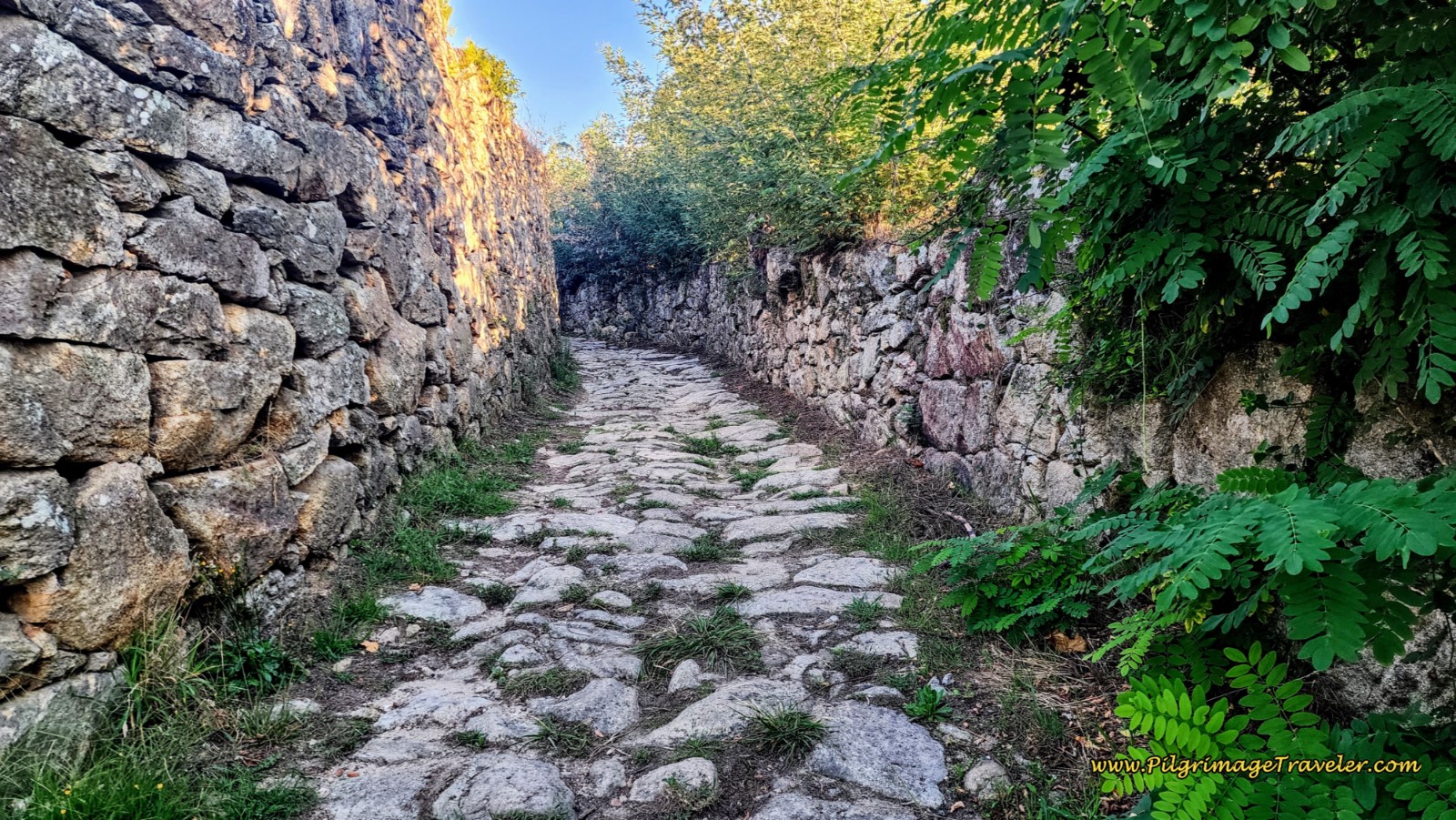
We’re not a travel agency ~ we’re pilgrims, just like you.
We've walked Pilgrimage Routes Across Europe!
💬 We’ve:
- Gotten lost so you don’t have to. 😉
- Followed yellow arrows in the glowing sunlight, the pouring rain and by moonlight. ☀️🌧️🌙
- Slept in albergues, hostals & casa rurals. Ate and drank in cafés along the way. 🛌 😴
- Created detailed and downloadable GPS maps and eBook Guides, full of must-have information based on real pilgrimage travels. 🧭 🗺️
- Shared our complete journeys, step by step to help YOU plan your own ultimate pilgrimage and walk with your own Heart and Soul. 💙✨
Every detail is from our own experiences ~ no fluff, no AI rewrite. Just fellow pilgrims sharing the way. We add a touch of spirituality, a big dose of ❤️ and lots of wisdom from the road.
Ultreia and Safe Pilgrimage Travels, Caminante! 💫 💚 🤍
Because we had walked on day fourteen to Vila Nova de Gaia a southern suburb of Porto, we finished the final two kilometers of the Camino into town, early in the morning of the next day. You can refer to the map from day fourteen (and more photos of Porto), to see how we walked here, if you are interested, by clicking on the link in this paragraph.
You can see the early morning light, in the photo below, taken from the Ponte Luis I, from just down the hill from the cathedral. If you are walking from the center of Porto via the pedestrian bridge, this is how you will locate the Mosteiro da Serra do Pilar, the domed monastery.
Or you can approach the monastery from the south on your final day into Porto, like we did. Climbing to the terrace of the Monastery is a grand introduction to this marvelous place!
It is well worth the walk across the bridge to see this monastery, for the views alone! I am glad we did this first thing on our day in Porto. The light was perfect for photos!
After crossing the bridge, look for the first street to your left, the Rampa do Infante Santo, shown below. The sign marks the way to the Monument.
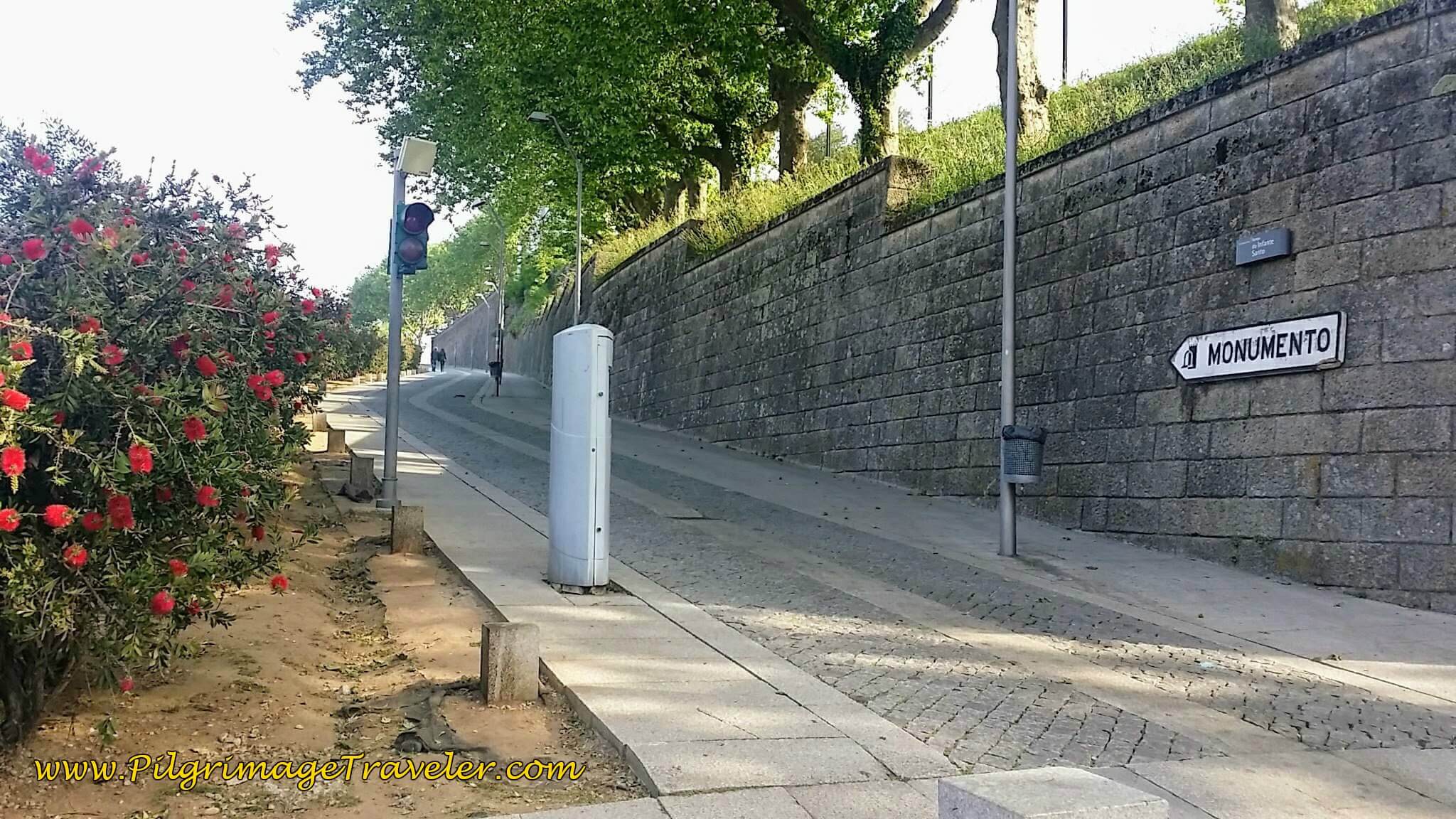 Rampa do Infante Santo Leads to the Monastery
Rampa do Infante Santo Leads to the MonasteryWe did not even visit the monastery itself, but hung out on the terrace overlooking the city.
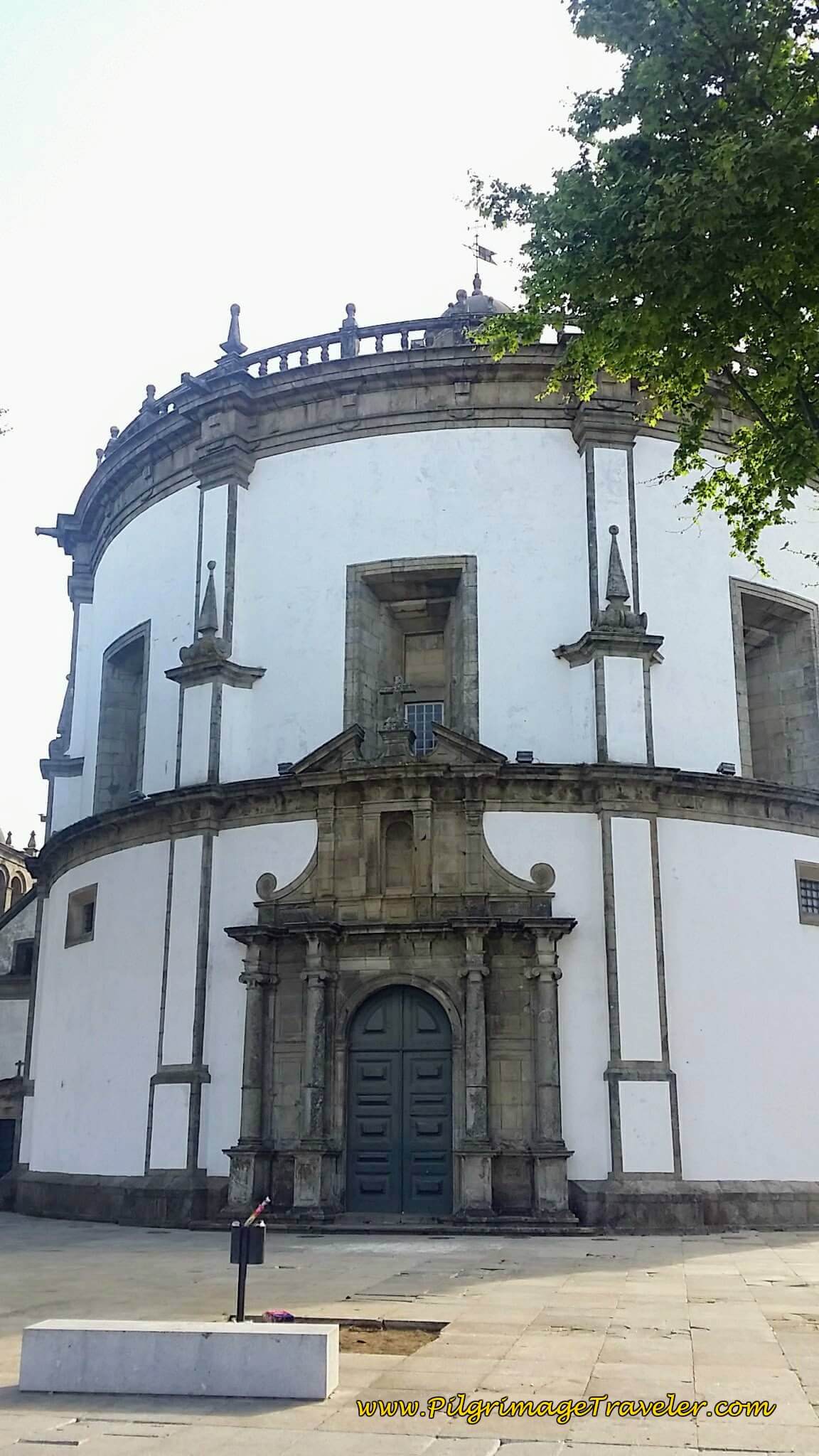 Mosteiro da Serra do Pilar
Mosteiro da Serra do PilarThe views from this monastery terrace are phenomenal! Here are only a few of them:
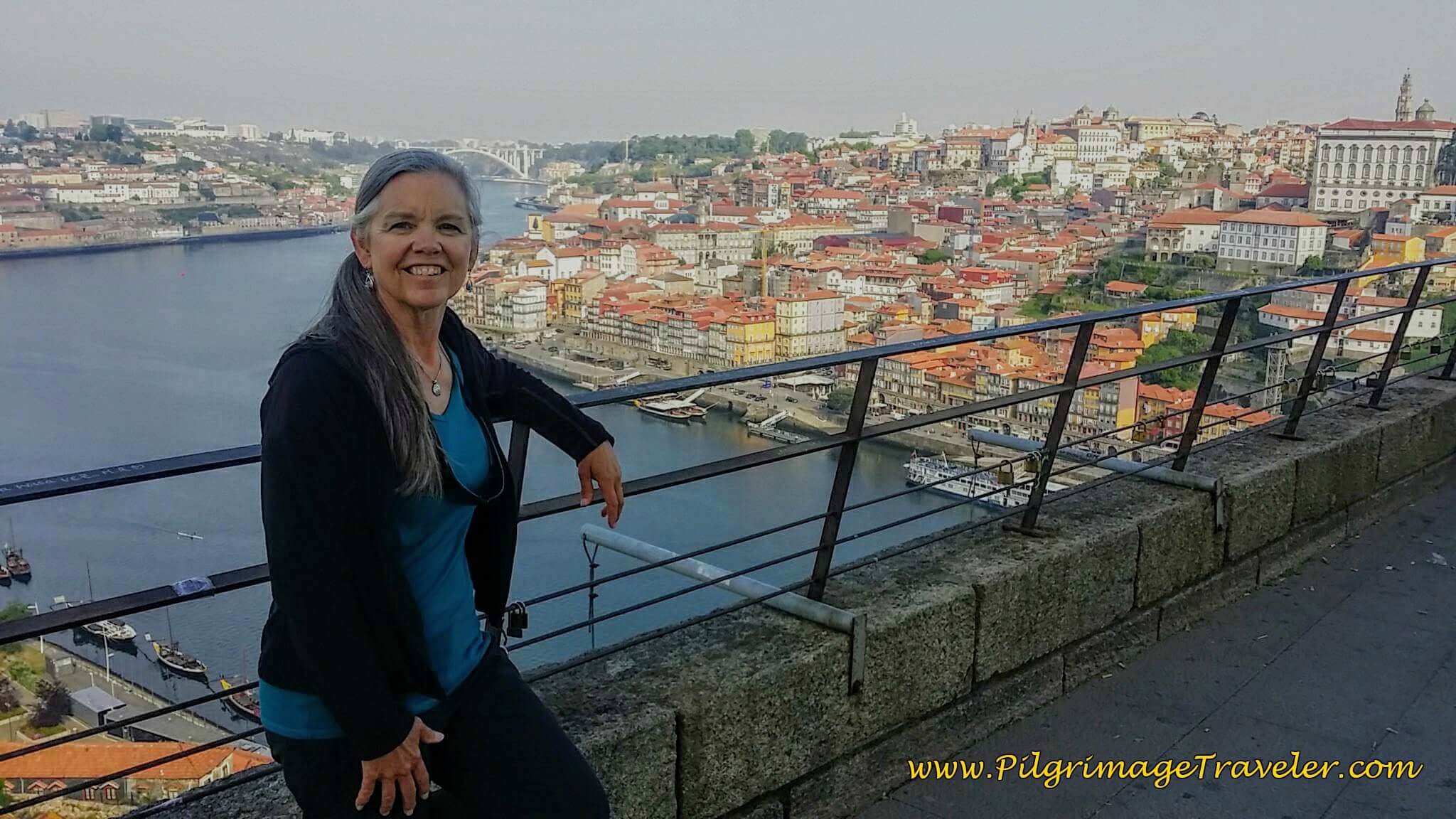 Elle Taking in the Views of Porto
Elle Taking in the Views of PortoOur next destination was the Cathedral of Porto. We actually took a taxi the day before to see the cathedral. We had time on our day fourteen and wanted to take full advantage of the sights to see.
The Sé do Porto is the focal point of the town, and it too is on a terrace with sweeping views of the city. You can see the twin towers of the cathedral in the skyline photos above and from almost everywhere in the city.
For all the information you need to know about this historic cathedral, click here for the official website.
Depending on how much you love cathedrals, how many of them you have already seen and how long you intend to pray, you may want to plan on an hour here. You can pay an additional three Euros to see the cloisters, which we did not. Once we saw the interior, we were more content to sit on the terrace and people watch!
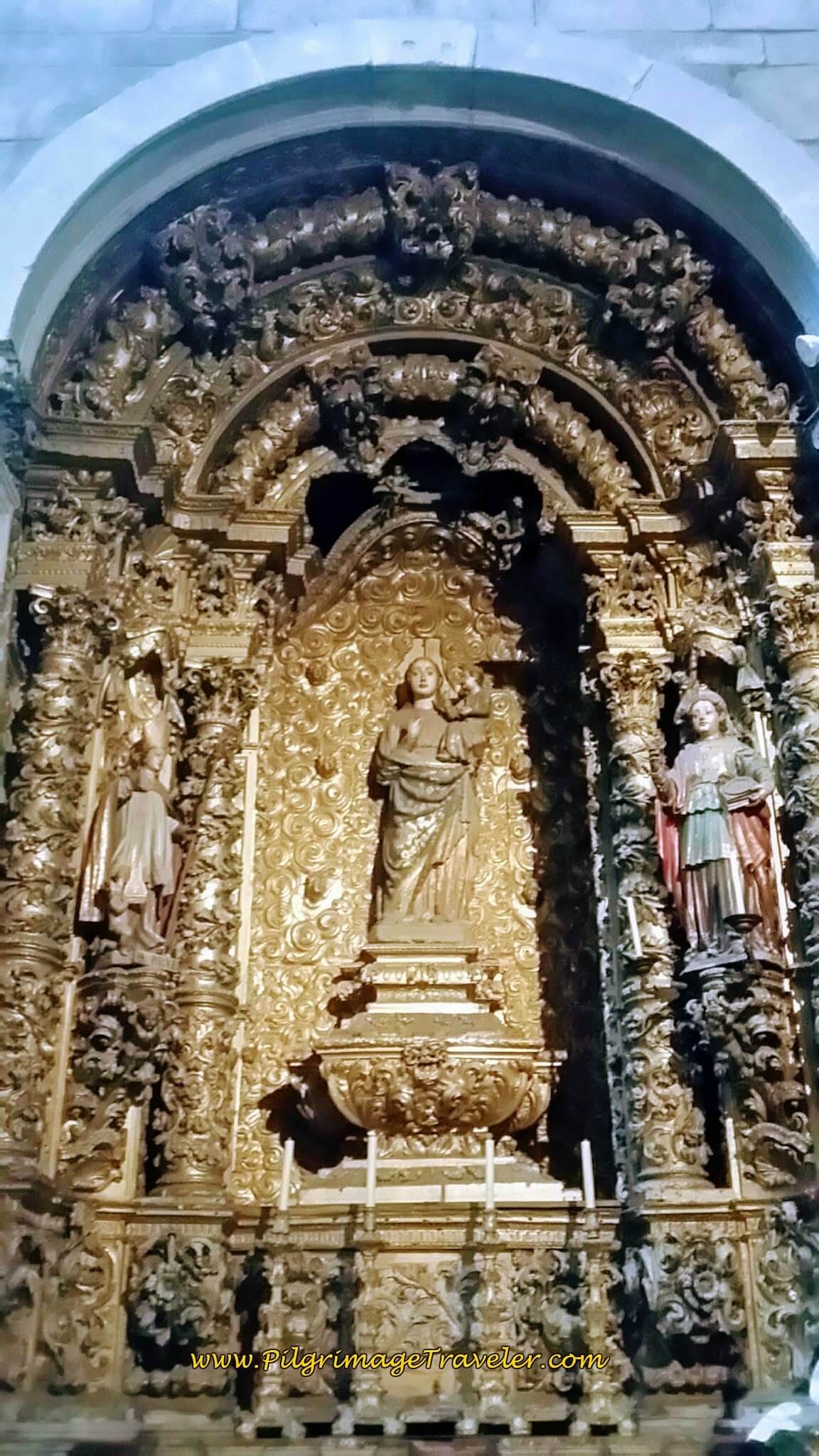 Sé do Porto Side Altar
Sé do Porto Side Altar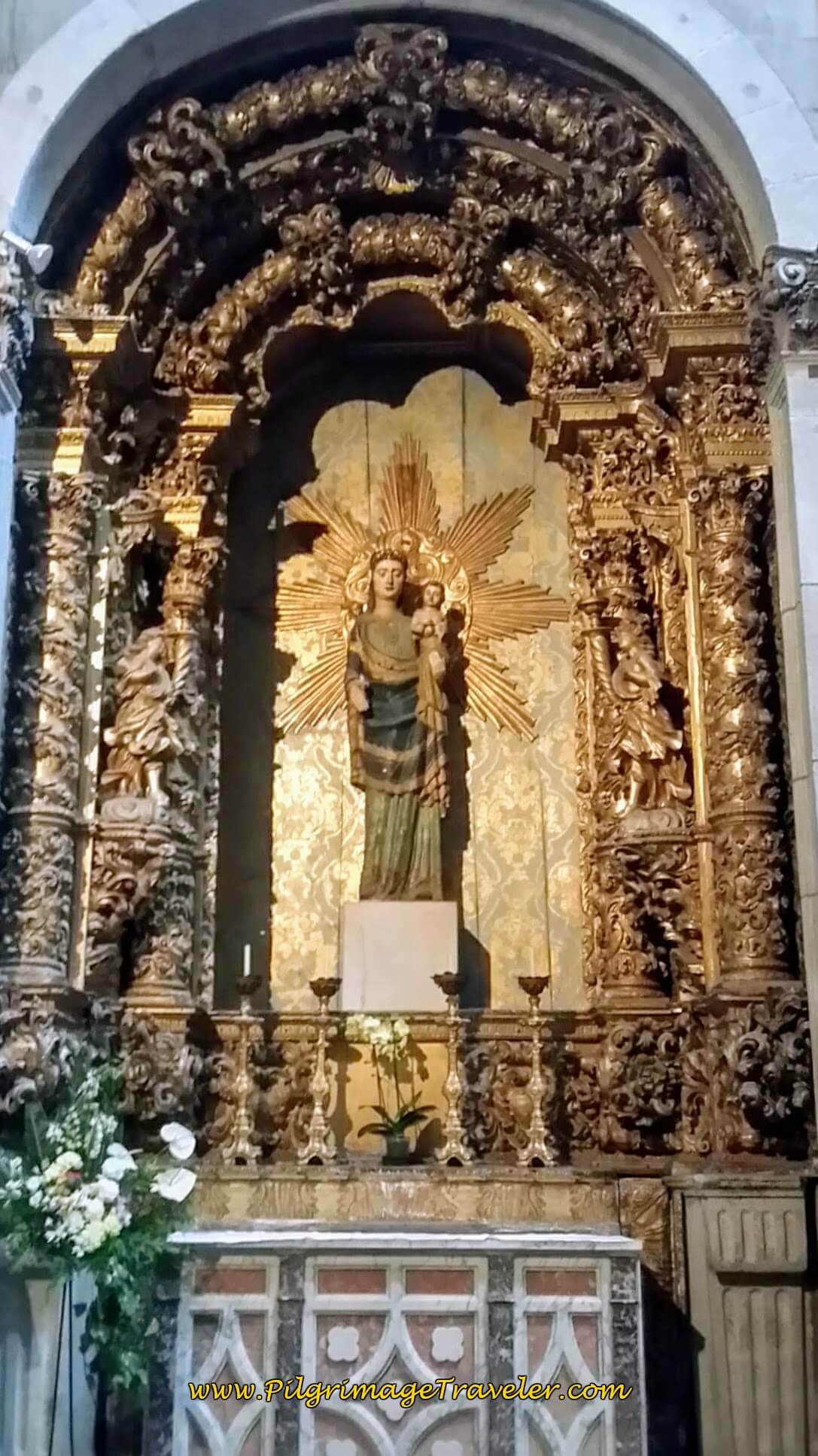 Sé do Porto Side Altar
Sé do Porto Side AltarJust outside the main entrance of the cathedral, in the open plaza is the unique Pillory of Porto. It is of the manueline style, and I found conflicting information as to whether or not it was built in the medieval times. The legend says that medieval criminals were hung from this pillar.
Jump to Camino Portugués Stages
Just below the Cathedral's terrace wall, due west of the pillory, is a fountain, the Chafariz da Rua Escura. It is also known as the Pelican Fountain (Chafariz do Pelicano) as you can see the figure of a pelican in the center, on top of the fountain. It also has two female figures on each side and the royal coat of arms. It was built in the 17th century, but moved to its current location in 1940.
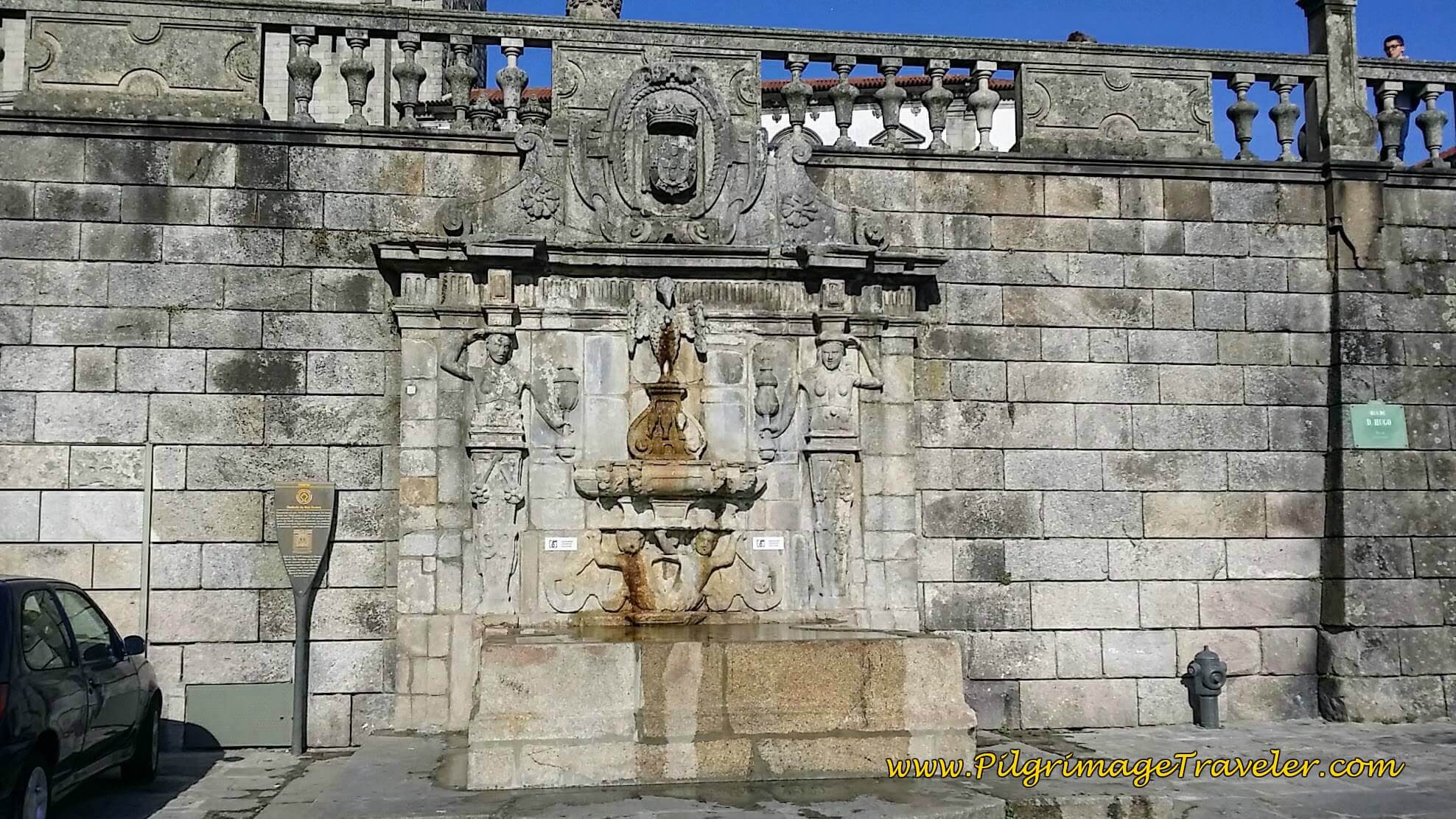 Chafariz da Rua Escura
Chafariz da Rua EscuraAfter the cathedral, we opted to tour the rest of the city on the Hop On Hop Off bus. It was the most economical way to see Porto, without walking for many kilometers. We were ready to take a break from that! Our day in Porto was a glorious respite from walking.
You can choose from the blue line or the red line, depending on what you wish to see. Click on the link above to plan your day in Porto and for current rates. We chose the one day option, but you can choose a slower pace and do the tour in two days.
We rode the red line because it went out to the castles on the coast, the beach and the waterfront on the return, along the Douro River. A nice preview of a portion of day fifteen on the Camino which we planned on the Senda Litoral!
We also rode the red line, when we needed a ride to our hotel in Vila Nova de Gaia at the end of the day! So convenient!
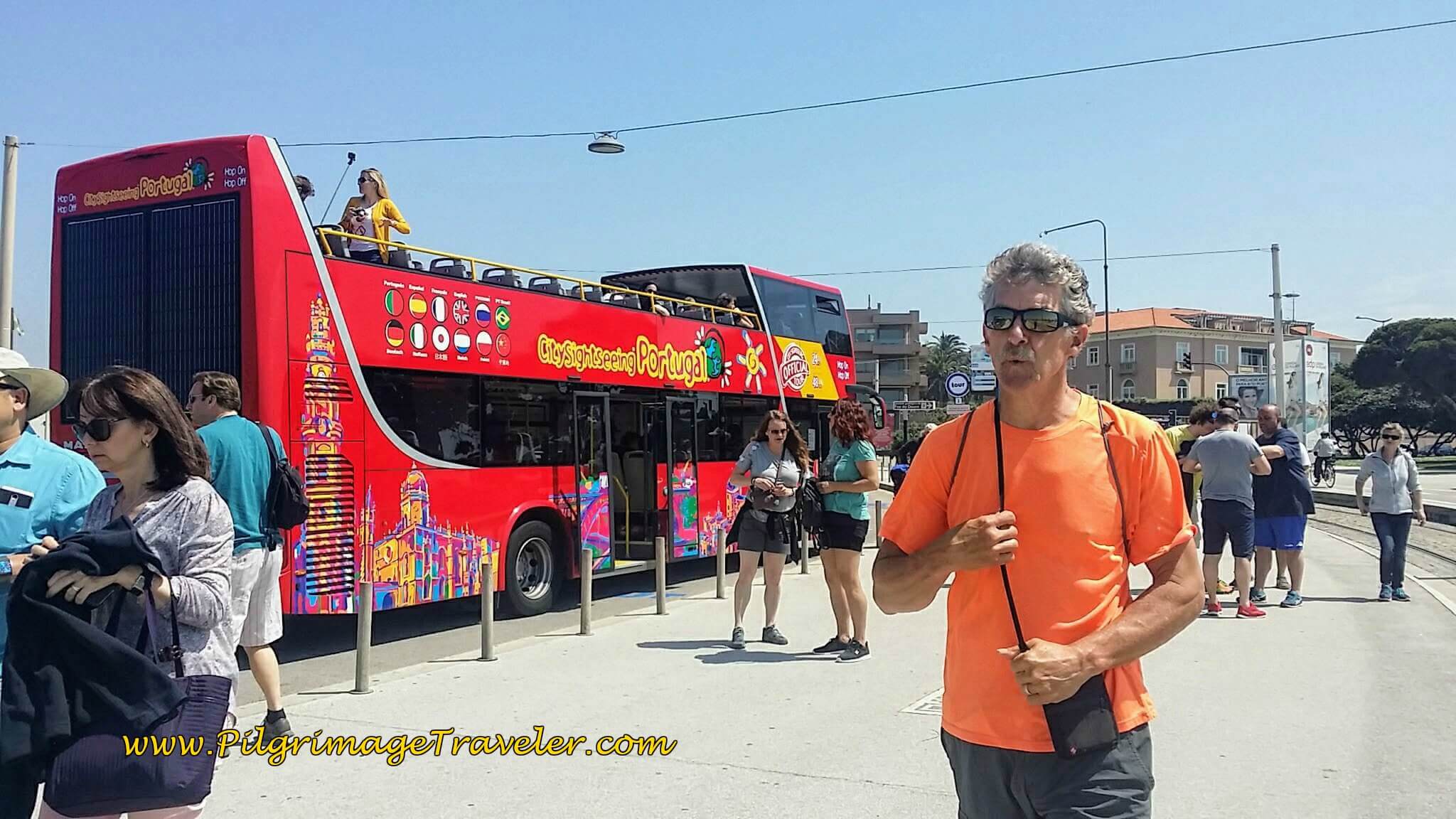 Rich and the Red Line Hop On Hop Off Tourist Bus
Rich and the Red Line Hop On Hop Off Tourist BusWe first boarded the Hop On Hop Off near the Cathedral. It runs counterclockwise and we whizzed by the next two churches. First the Baroque Church of Ildefonso, with its striking blue tiles.
Sitting on the top, open air level, of course, the next church was the Igreja da Santissima Trinidade or the Holy Trinity Church. Neither of these monuments was on the list for scheduled stops, however a short walk will get you to the Trinity Church, behind the City Hall.
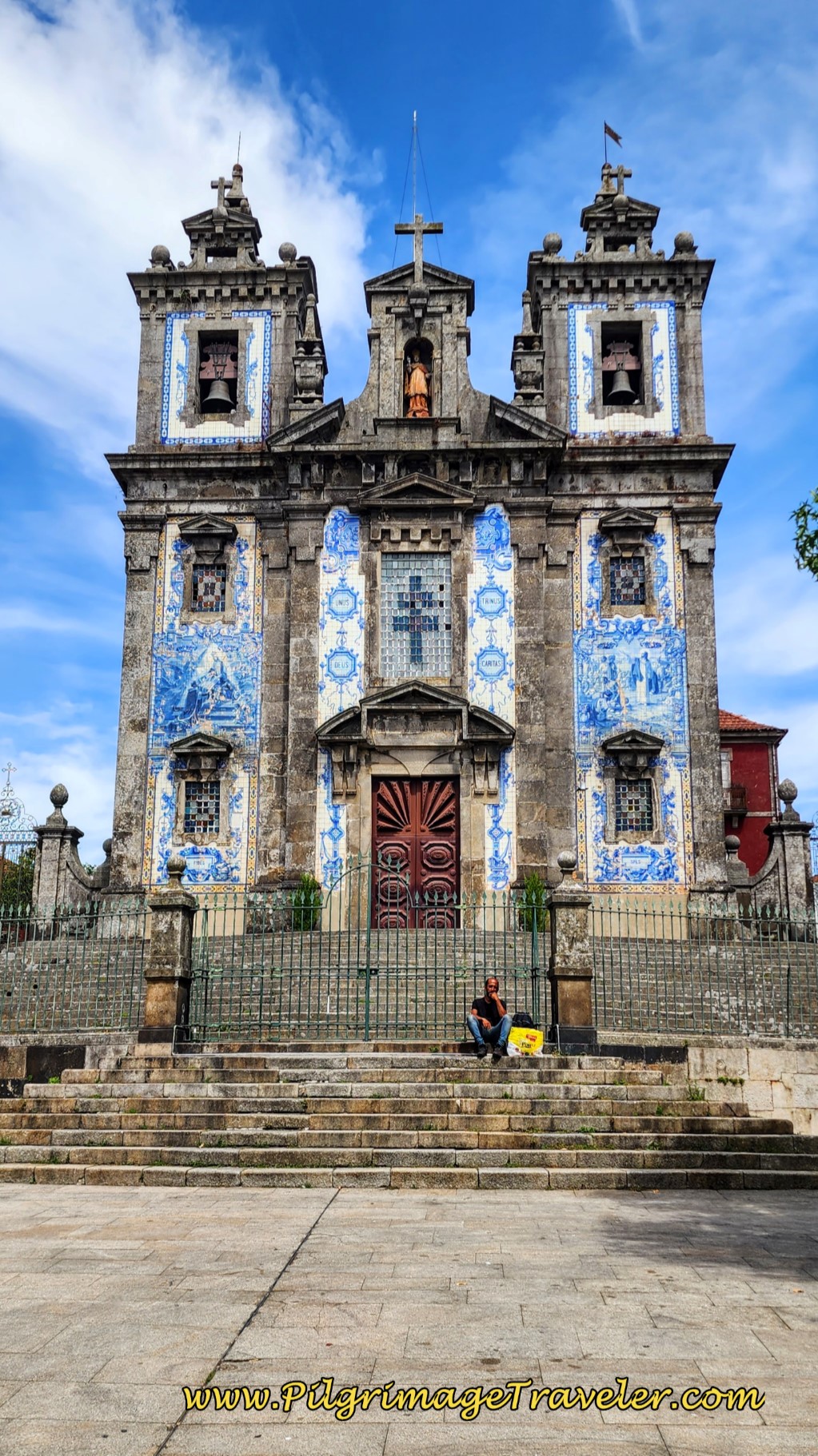 Igreja Paroquial de Santo Ildefonso
Igreja Paroquial de Santo Ildefonso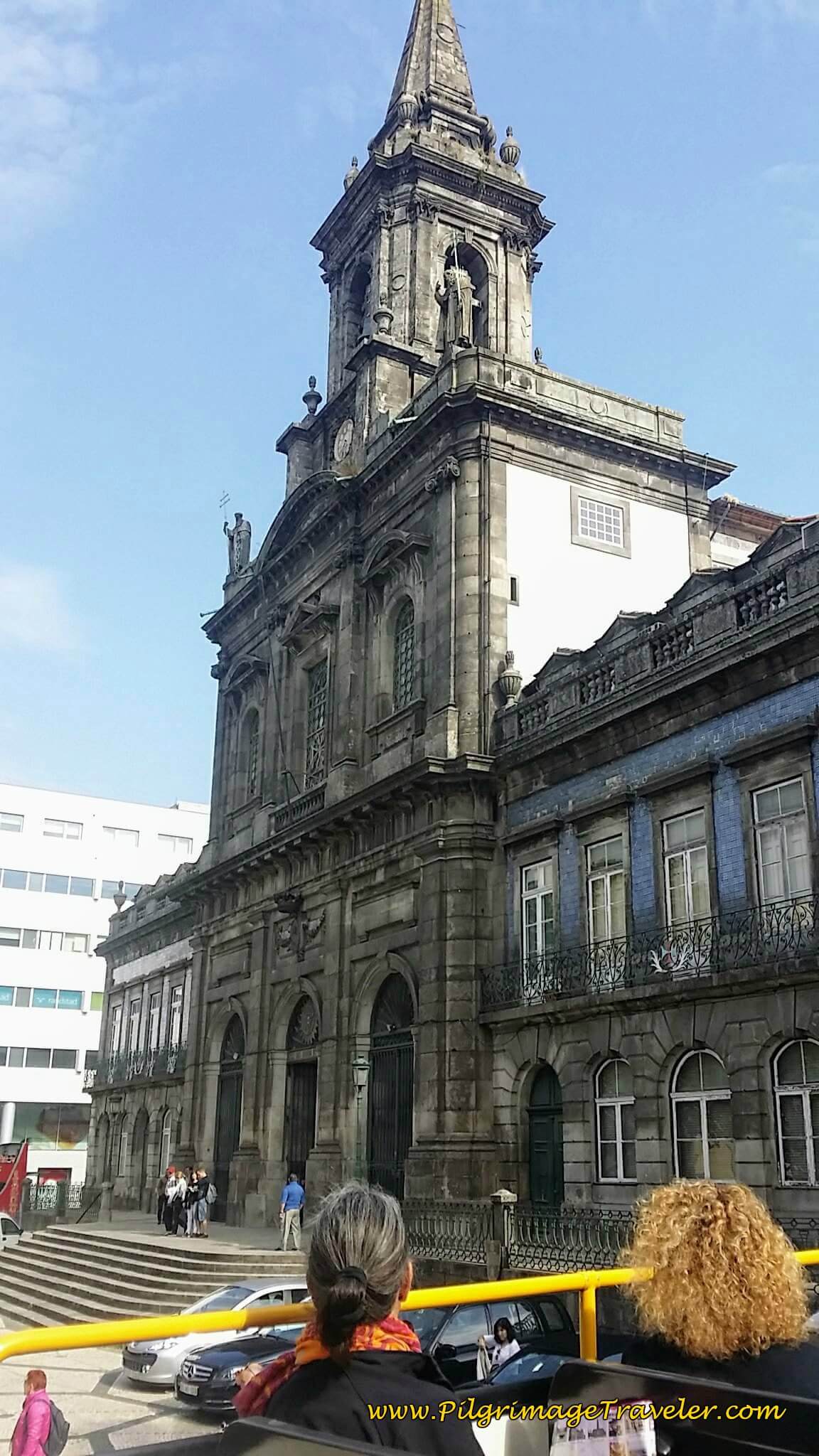 Igreja da Santissima Trinidade
Igreja da Santissima TrinidadeThe first stop was at the Câmara Municipal do Porto or the City Hall, below. It is a grand tourist attraction with a lovely park and reflecting pool.
Back on the bus, the next stop where we disembarked, was the twin churches of the Igreja do Carmo and the Igreja dos Carmelitas. In front of these churches is a fabulous plaza and the Lion's Fountain, the Fonte dos Leões.
While I was fooled at first, thinking this was one church, it is actually two, built side-by-side! Lots of legends abound about whether the nuns and the friars were separated in this manner, one church for males and the other for females. Ha ha!
The well-known blue-tiled mural on the Igreja do Carmo is striking and is seen from a distance as you approach on the tourist bus. It was completed in 1912 by Silvestro Silvestri.
The Igreja do Carmo was built in the 18th century in the Rococo style and the Igreja dos Carmelitas was built 150 years earlier in the 17th century in the Baroque-influenced Classical style.
Both churches have altars carved in gilt, below. There was a mass going on in the Igreja dos Carmelitas on Sunday morning when we visited.
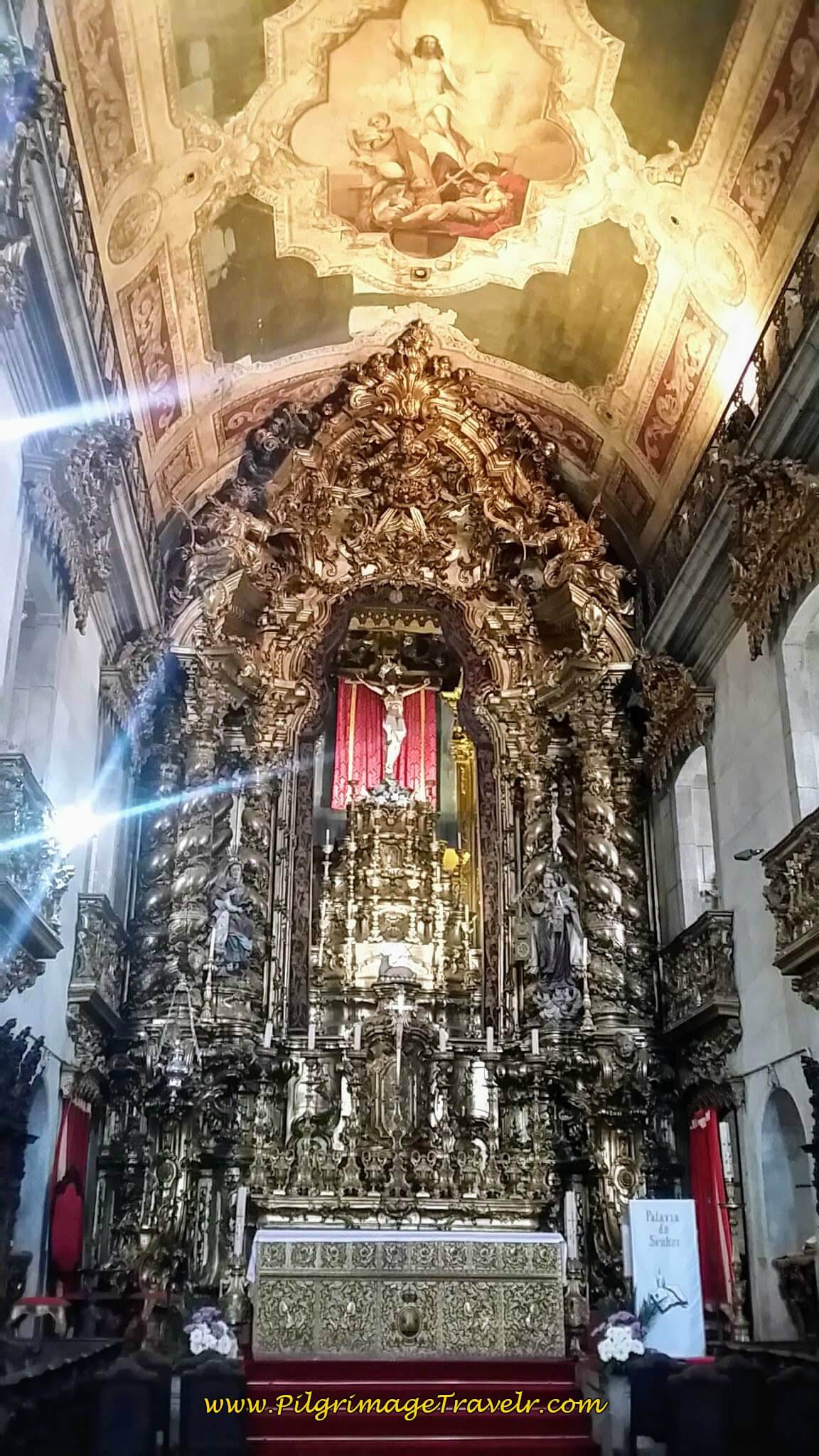 Main Altar of the Igreja do Carmo
Main Altar of the Igreja do Carmo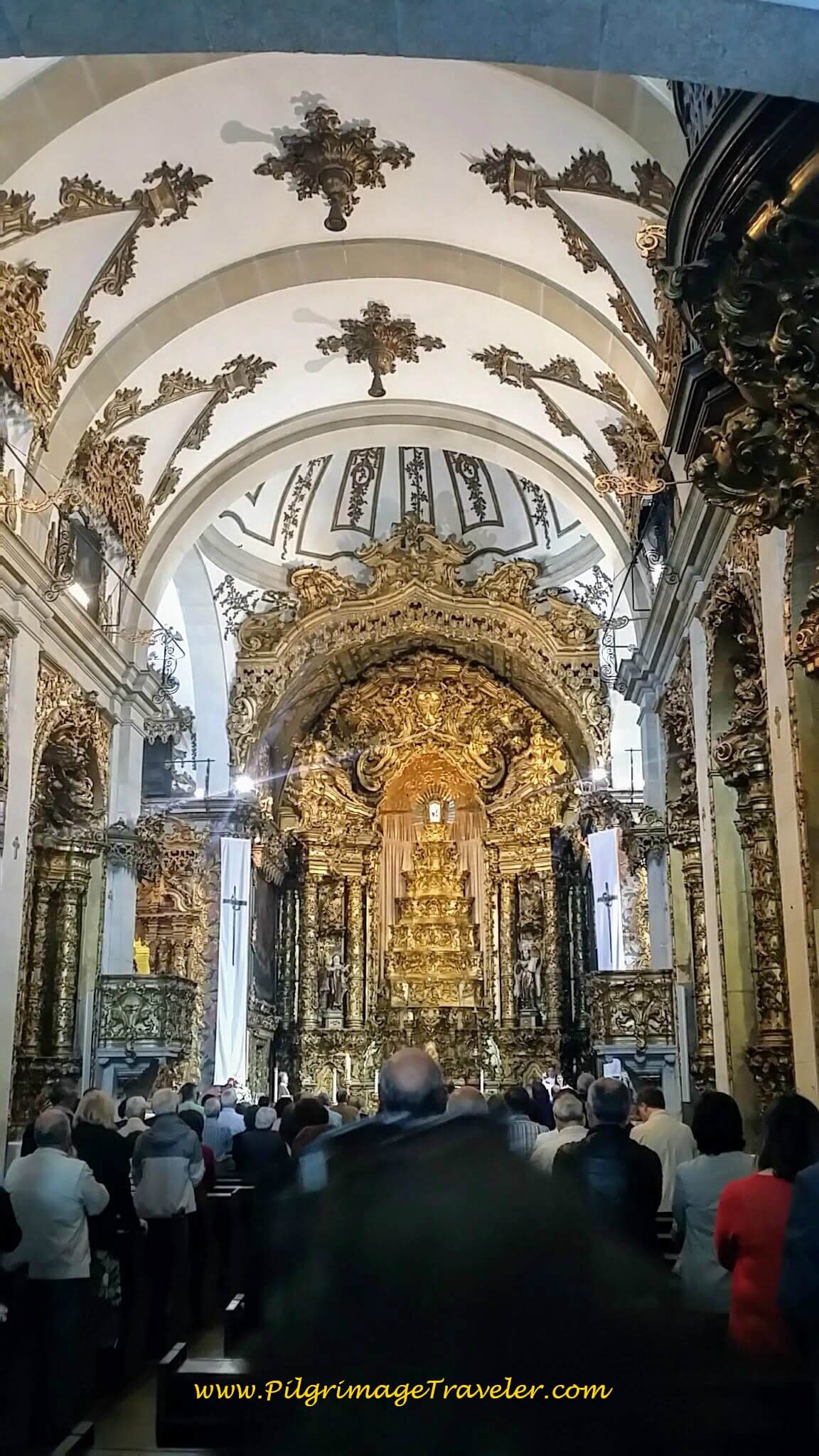 Main Altar of the Igreja dos Carmelitas
Main Altar of the Igreja dos CarmelitasJust across the plaza, the Praça de Gomes Teixeira, is the University of Porto, below.
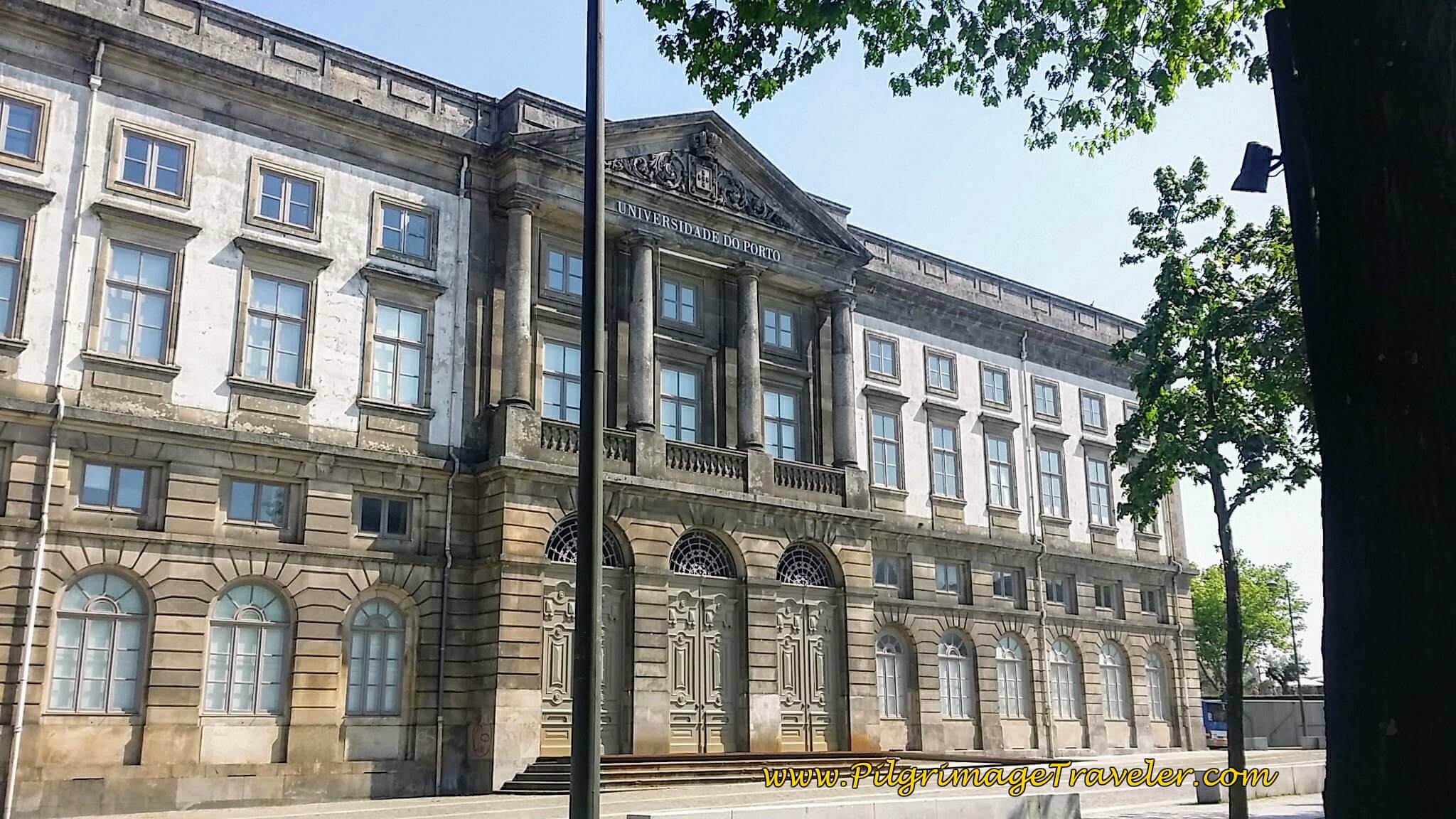 Universidade do Porto
Universidade do PortoInstead of hoping back on the tourist bus, we walked south to see the university, and then through the park, the Jardim da Cordoaria, for only a few blocks toward the Clérigos Tower or the Torre dos Clérigos, one of the most famous sites in Porto and a priority on our list. This bell tower can be seen from just about everywhere in the city.
In front of the tower, I just had to snap this photo, below, to show how popular this site is! The many ways to get around the city, all in one block! All that is missing is a taxi or a horse and carriage.
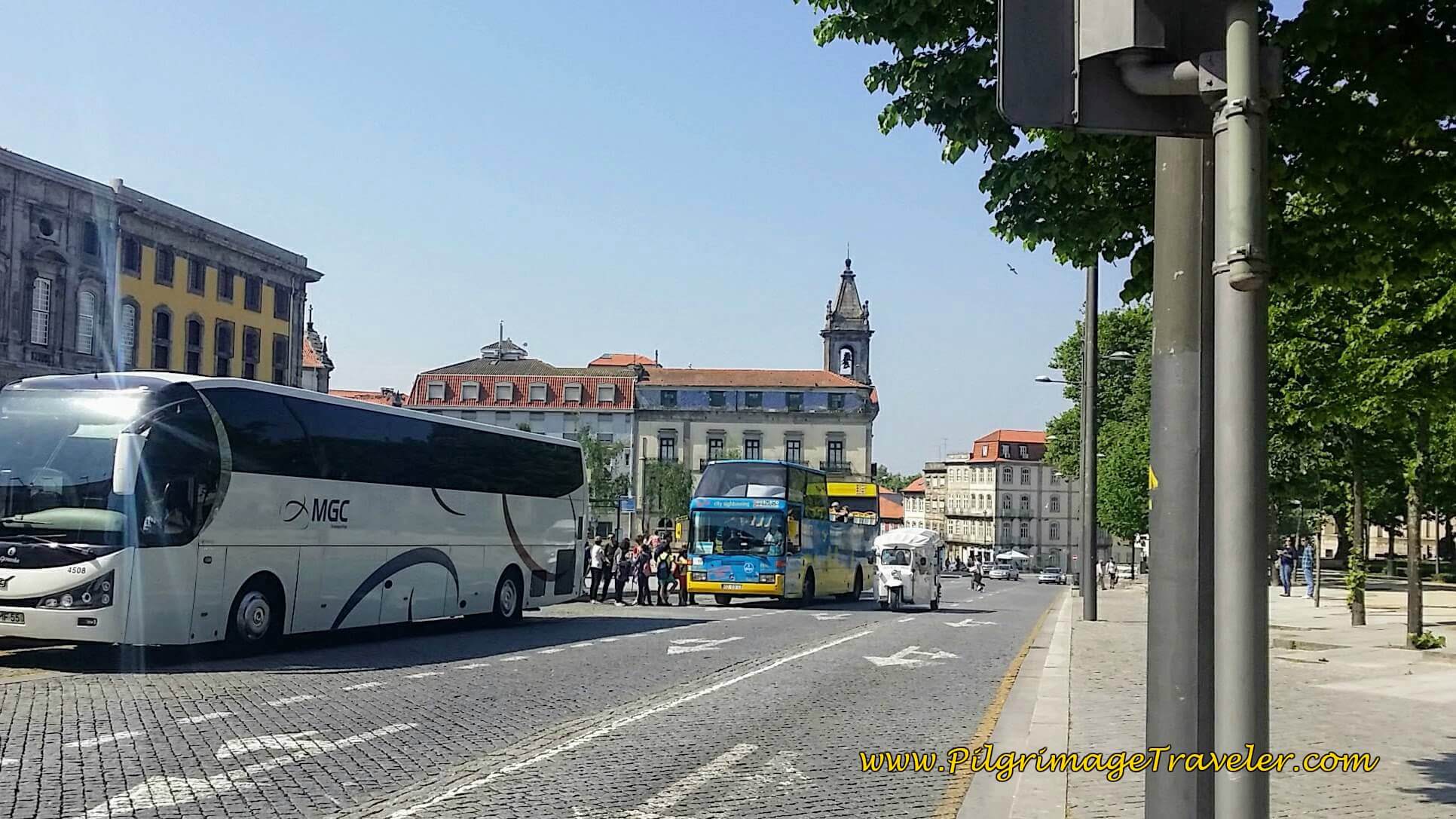 3 Ways to Get Around Porto: Tour Bus, Hop On Bus and Tuk Tuk
3 Ways to Get Around Porto: Tour Bus, Hop On Bus and Tuk TukThe history of the Clérigos Tower and Church, started by the Brotherhood of Clerics in 1754 is quite fascinating. By 1910 this landmark building became a national monument, and in 2014 it opened a museum to the public.
For all the information you need to know about Clérigos, click here.
The street just to the south of the tower, the Rua da Assunção is quite inviting and has lots of shops and restaurants.
The Baroque-style Clérigos church or Igreja dos Clérigos, is rectangular which gives the sanctuary a feeling of intimacy, yet it is full of upper walkways and passageways.
According to the official website, the "marble altar and a rococo-inspired altarpiece, with the design of Manuel dos Santos Porto, in which a throne crowned by the image of the Patroness, Our Lady of the Assumption, stands out. On the flanks of the altarpiece, the co-patron saints of the Brotherhood of the Clerics are highlighted, St. Peter ad Vincula and St. Philip Neri, two painted wooden sculptures."
The Clérigos museum, not shown in any photos, is extensive and full of many sculptures, paintings, furniture, goldsmithery and the "Christus Collection" of various artistic and devotional depictions of Christ on the Cross.
Many of these museum pieces were private, some from personal collections and most used in the daily life and worship of the Brothers of the Clerics.
Plan on spending at least two or more hours on this site, especially if you plan to visit the bell tower, the most dramatic of the attractions. We waited for a very long time, in a very long line to gain entrance to this Baroque tower. Unfortunately, we were there on a Sunday, which may have made it worse.
The tower is 225 steps up, and 75 meters high. It is worth the climb as the views are absolutely stunning as you can see below.
 Panoramic View to the South from the Clérigos Tower
Panoramic View to the South from the Clérigos TowerThe tower staff only let a few people in the tower at once, and though highly controlled, we still had to wiggle our way to the outside to see the view, and wiggle our way around to the 360 degree vantage points!
If you need lots of personal space or are claustrophobic, better stay away!
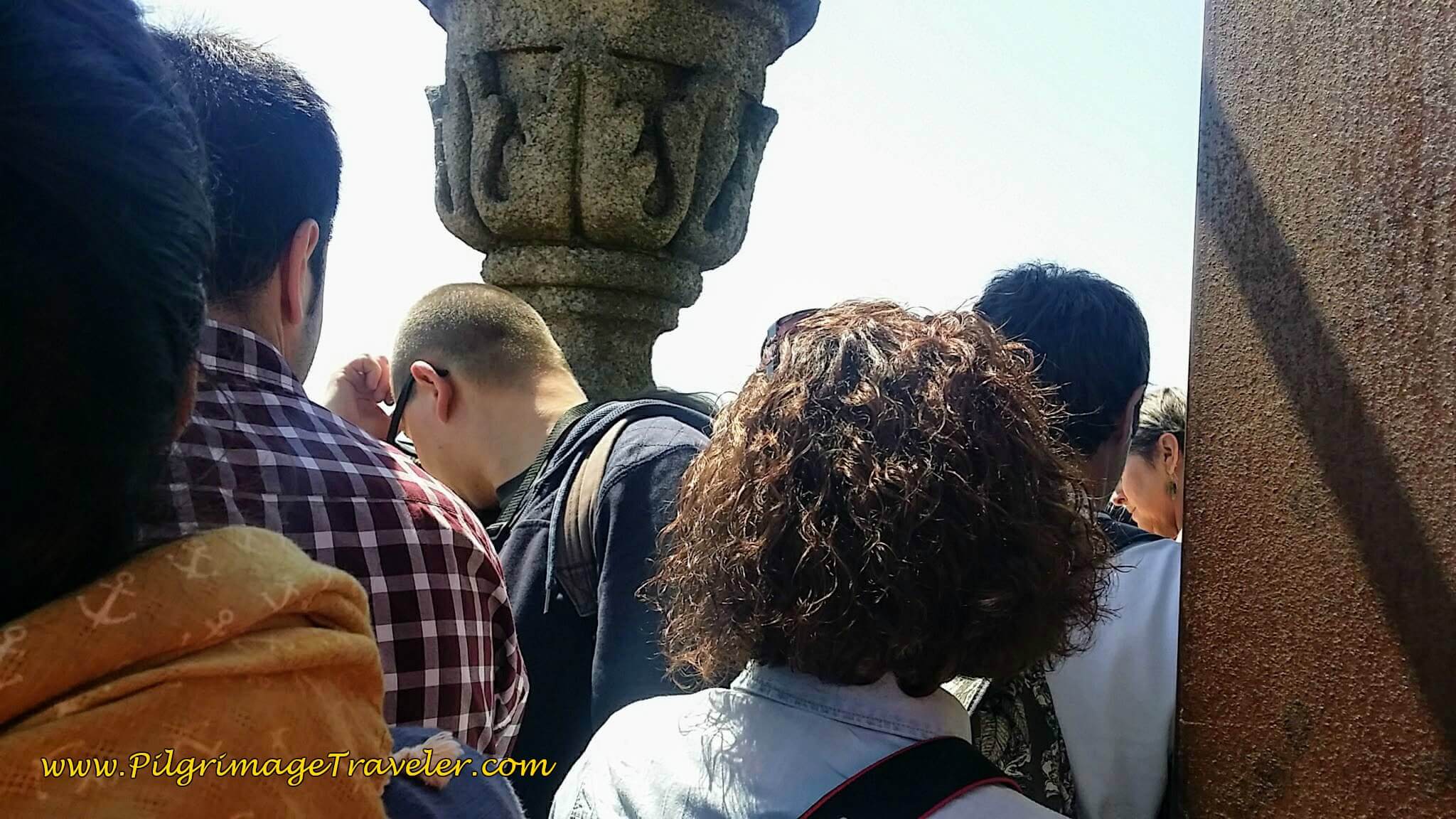 Small and Crowded Catwalk on the Top of the Clérigos Tower
Small and Crowded Catwalk on the Top of the Clérigos TowerJust to the north of the Clérigos Tower is a plaza where we had a noon break at a café. By our resting point was the famous bookshop built in 1906, the Livraria Lello & Irmão. It has some interesting architectural features, but due to its high entry fee and low priority on our list, we were content to admire it from the outside while we ate our lunch.
The official site calls the Livraria Lello & Irmão the most beautiful library in the world, which inspired the author of the Harry Potter books. Click here for more information if you are interested in seeing it.
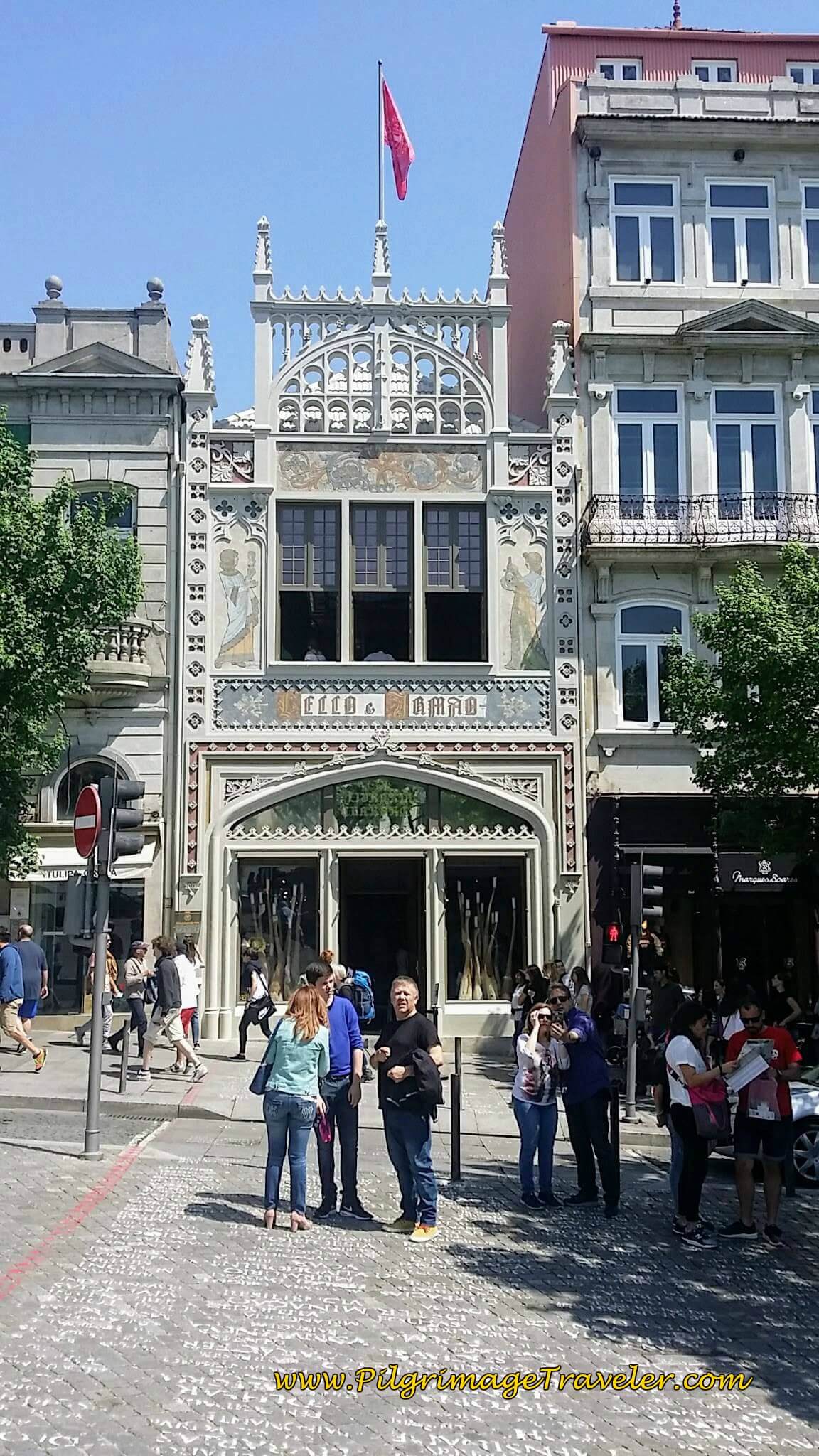 The Bookshop, Livraria Lello & Irmão
The Bookshop, Livraria Lello & IrmãoJump to Camino Portugués Stages
Our first move after lunch, being tired of monuments and museums, was to hop on the tourist bus' red line, west to the seacoast and the Castelo do Queijo.
We were especially excited to see this portion of the bus route, as we would trace the Senda Litoral Coastal Camino, backwards from the Castle. We would walk this route the following day, day fifteen on our Camino Portugués.
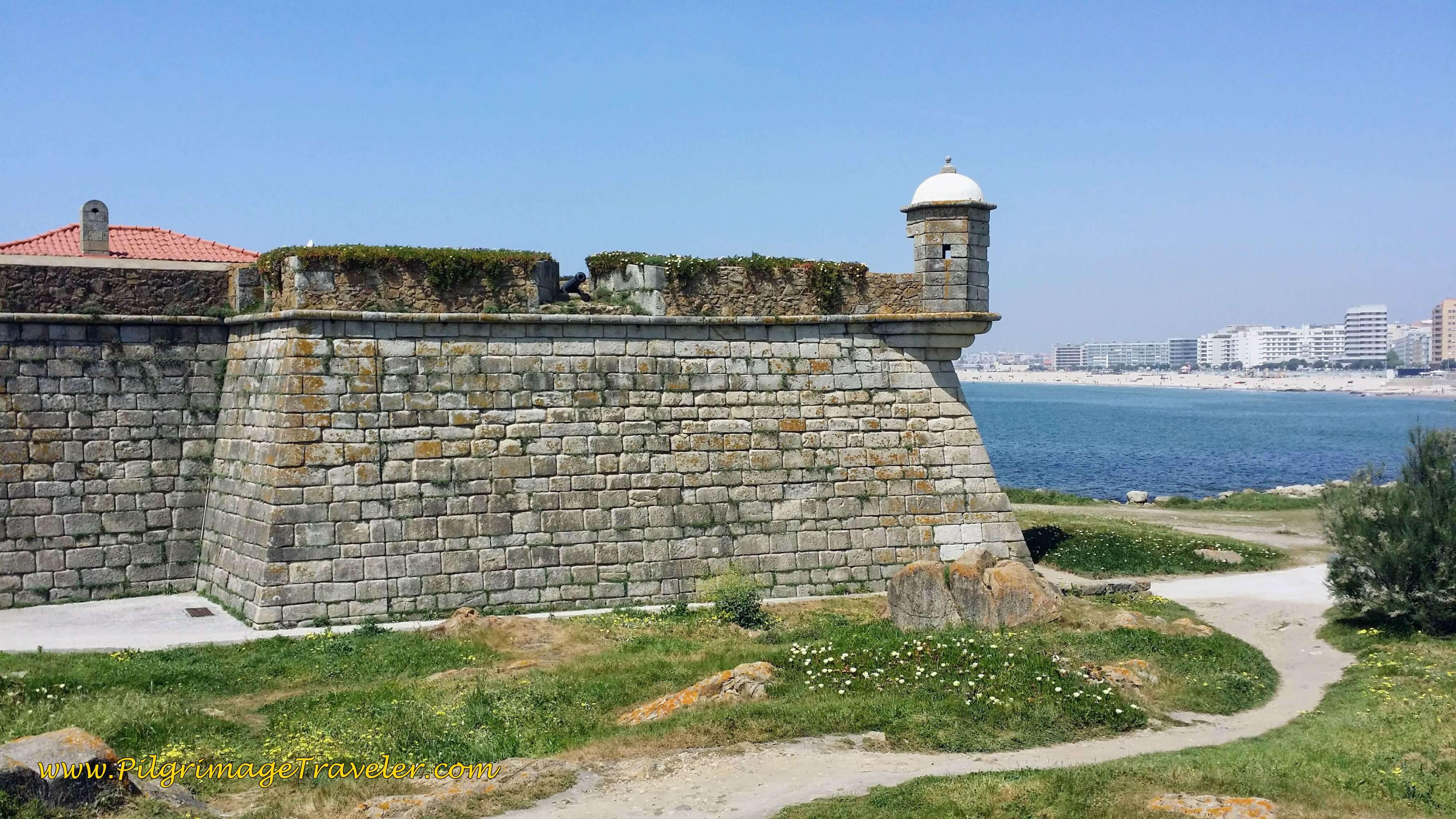 Castelo do Queijo
Castelo do QueijoThe castle, also known as the Forte de São Francisco Xavier was built in 1661. According to the placard by the castle, 1832 saw its occupation by the Absolutionists, and was badly damaged, then for many years it was unoccupied. It then became the headquarters of Porto's 1st Company of the Navy. By 1975 it was given to the Northern Commandos Association.
I loved the yellow flower so often seen at the seaside, in the photo below. If anyone knows the name of this flower, please inform all of us in the comments below!
And yes, by the Castelo is a lovely beach, called none other than the Praia (beach) do Castelo do Queijo. In April of 2017 it was definitely already beach weather!
Hoping back onto the tourist bus, the drive along the coast south and east brings you to yet another fort, the Fortaleza de São João da Foz, or St. John's Fort at the Mouth (my loose translation of Portuguese).
We did not hop off here, but I snapped a quick photo. This fort, built in the 16th century guarded the Douro River at the mouth of the harbor. It is a major landmark on the Senda Litoral where the Douro River meets the sea!
Then the route bends east along the Douro River and back toward the center of Porto. Here is the harbor entrance, just beyond the Fort, (which is around the corner to the right of what is pictured below).
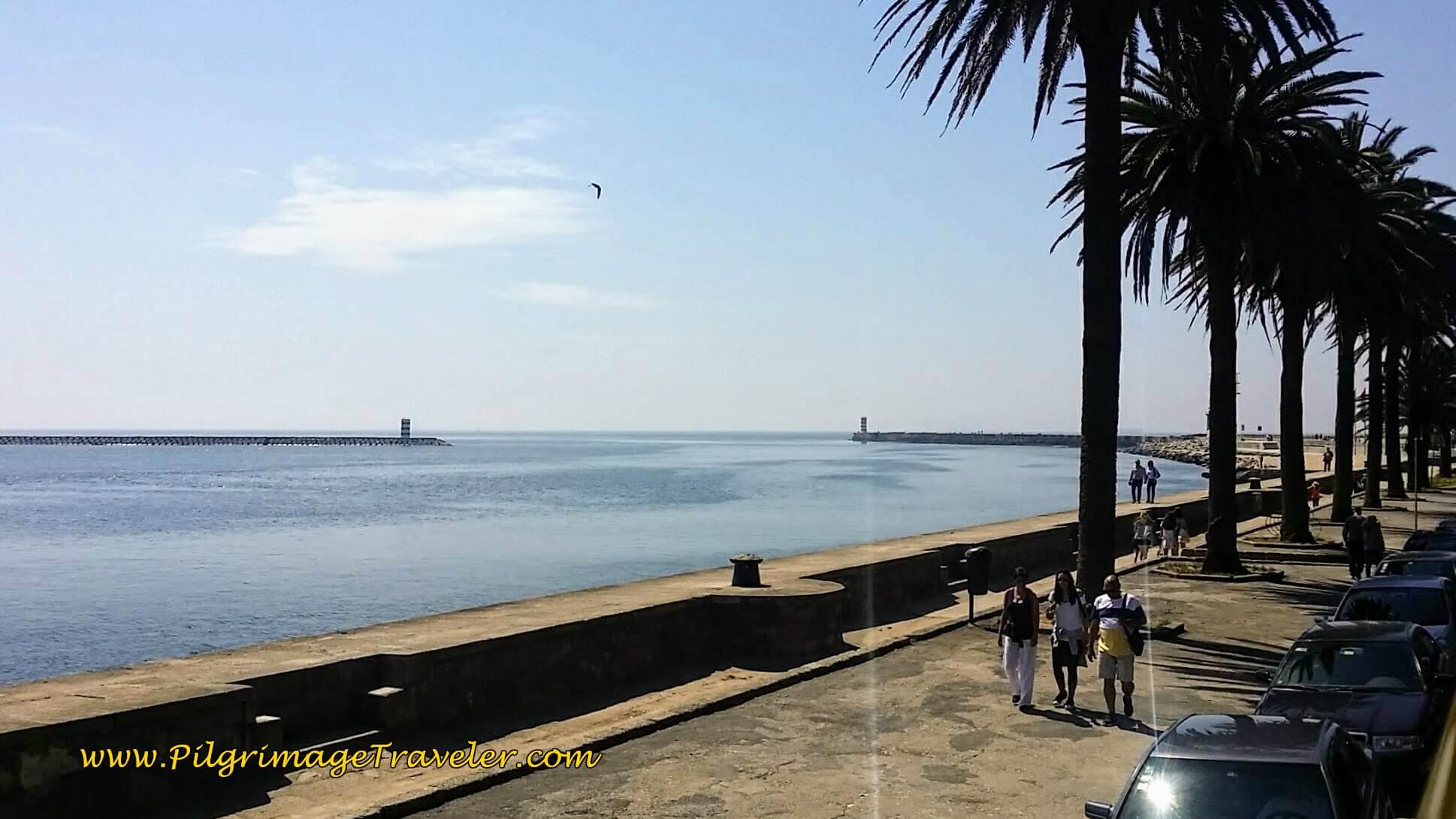 Porto Harbor Entrance
Porto Harbor EntranceIt is along this riverfront promenade that we would begin the second half of our Camino Portugués, along the Senda Litoral. I was very excited to see the Way, the day before, from the upper, open air deck of the Hop On Hop Off bus!
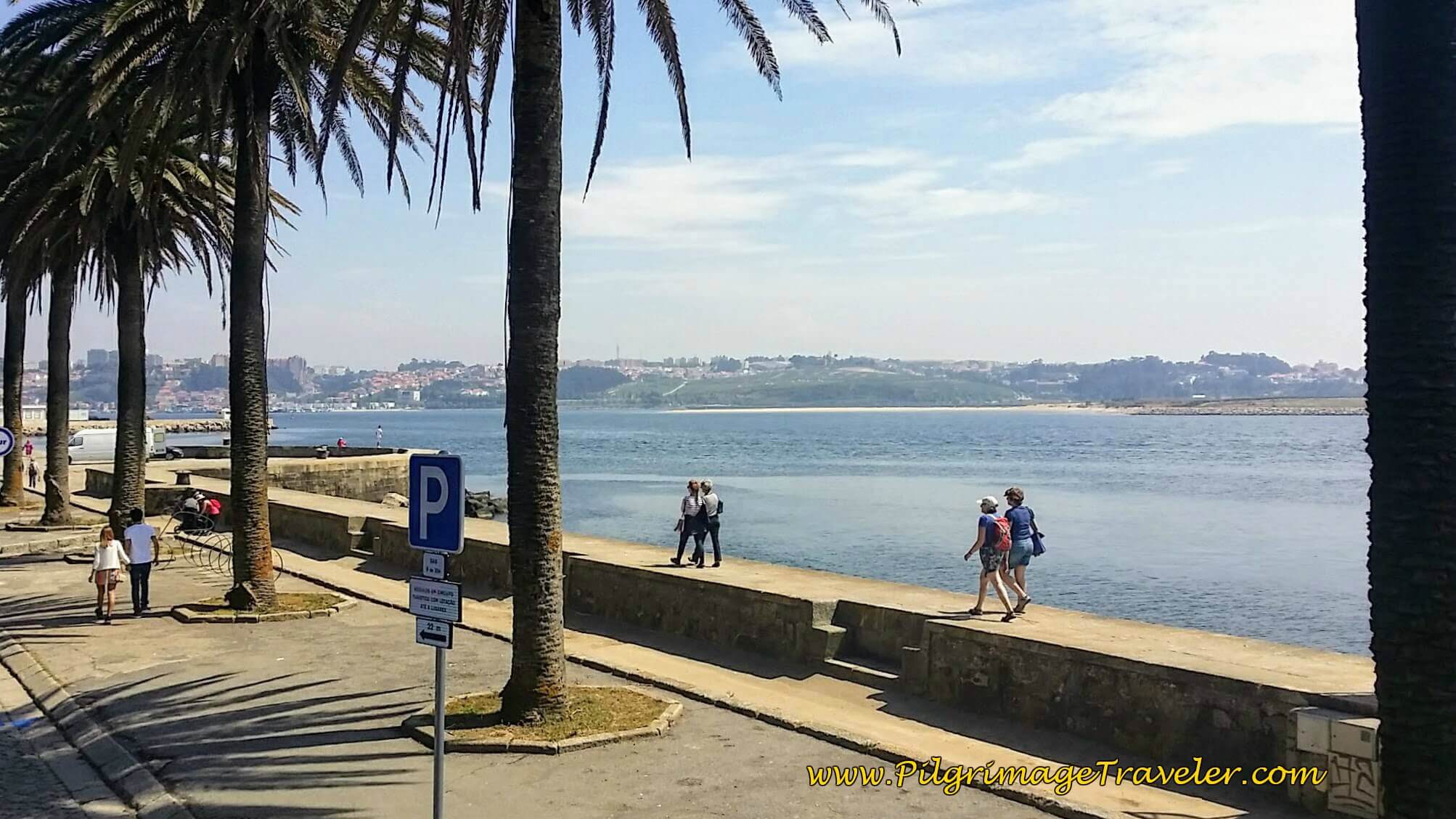 Rio Douro Promenade Towards Porto Center
Rio Douro Promenade Towards Porto Center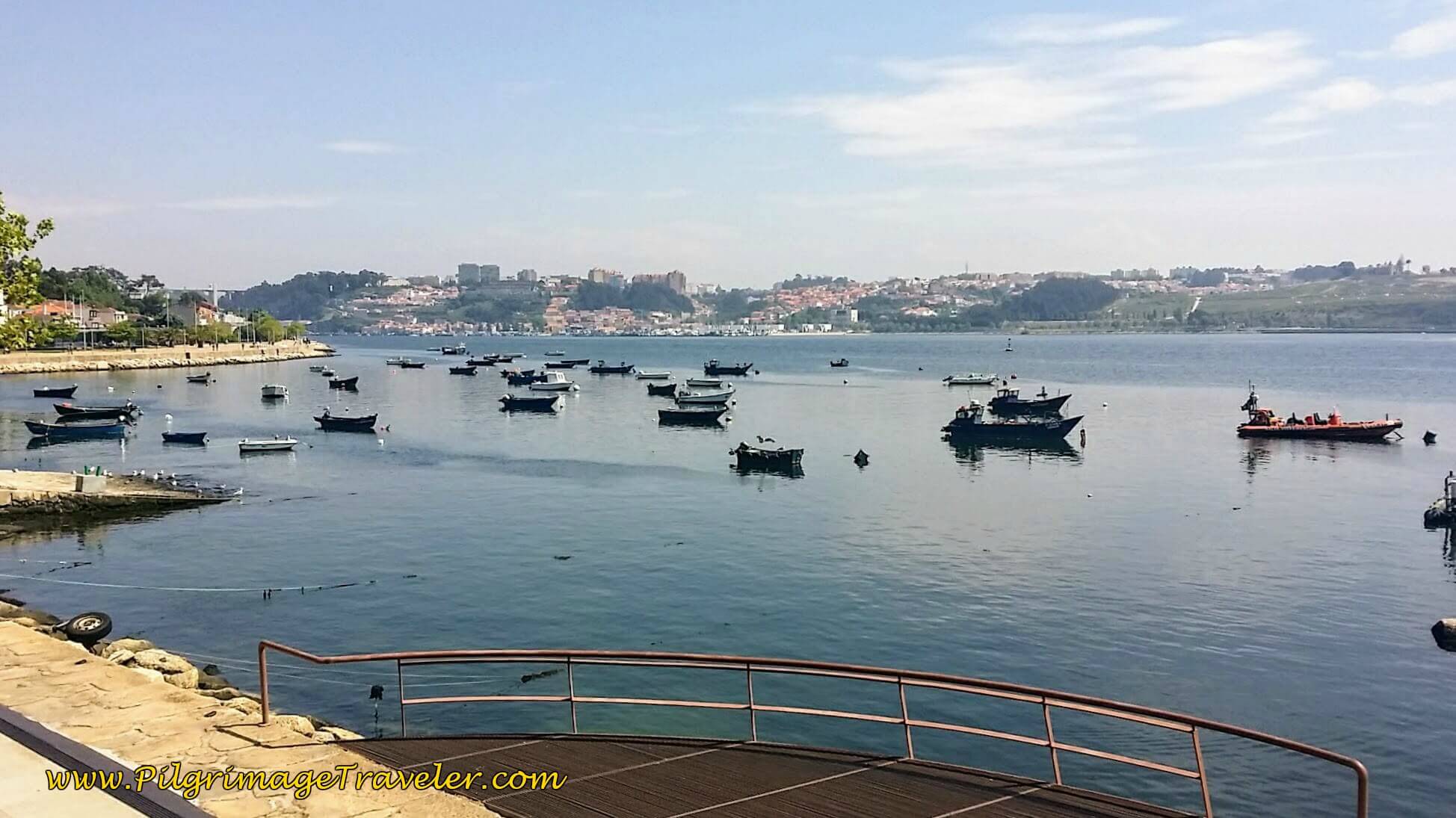 Fishing Boats Line the Harbor
Fishing Boats Line the HarborBack in the center of Porto, we hopped off the bus here at the Igreja Monumento de São Francisco, the San Francisco Church where we chose to only walk around the outside and not pay the entrance fee. Just too many churches in one day I guess! The gilt carvings in this church are fabulous. Click here if you are interested in seeing it.
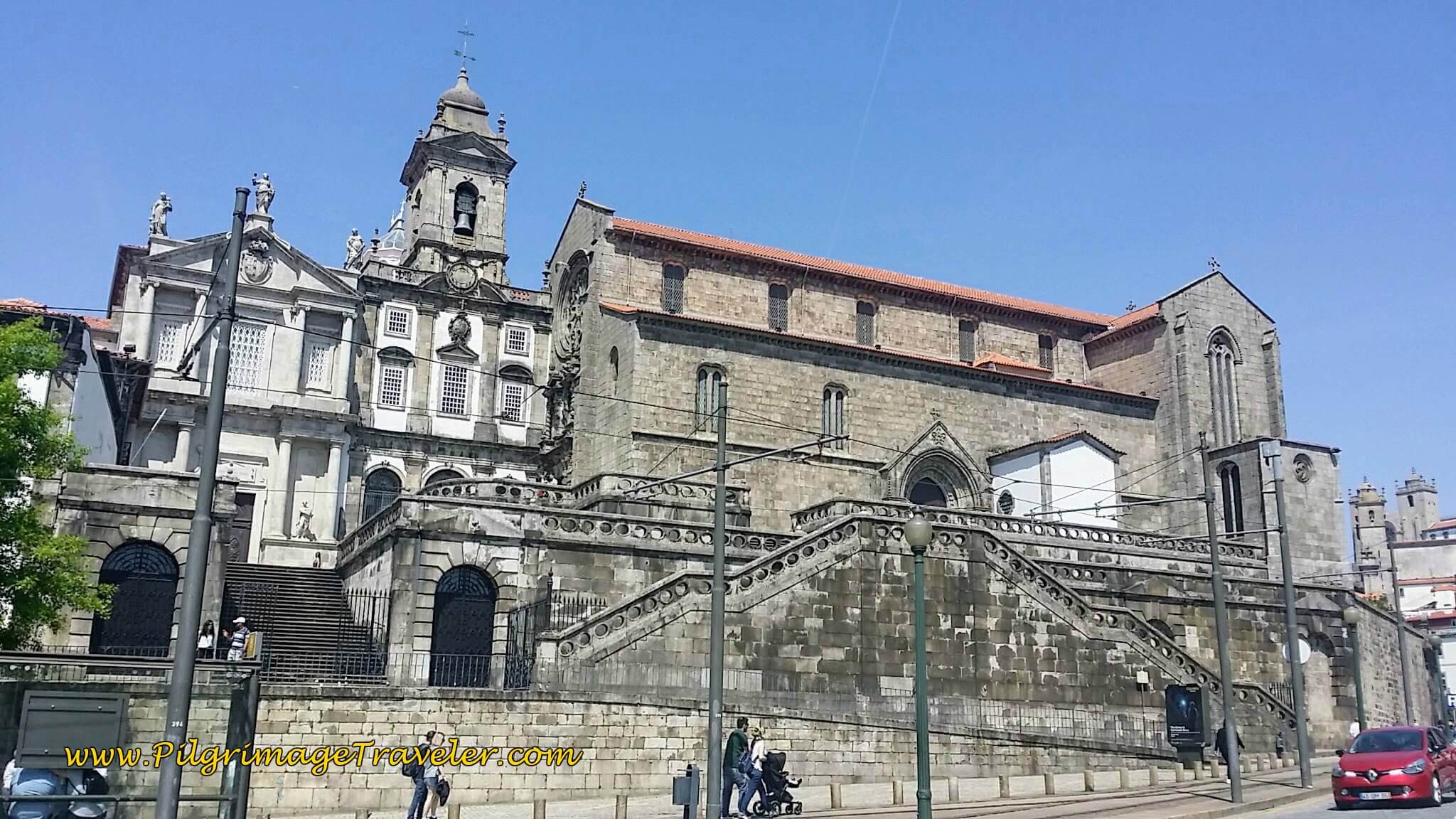 Igreja Monumento de São Francisco
Igreja Monumento de São FranciscoAcross the street from the San Francisco church is this little gem, the blue-tiled Igreja Paroquial de São Nicolau. The photo on the left shows it from the upper terrace of the San Francisco church.
And beside the churches to the north is the Jardim do Infante Dom Henrique, a small green park with a statue commemorating the man of the same name, known as Prince Henry the Navigator. This statue was completed in 1900 and honors the courage and faith of the famous Portuguese navigators.
Just beyond the statue, you can see the red buildings of the Ferreira Borges Market where we chose to sit and have a beer instead of touring another monument! Then the beer was followed by a café con leite, to perk us up for the remainder of the day!
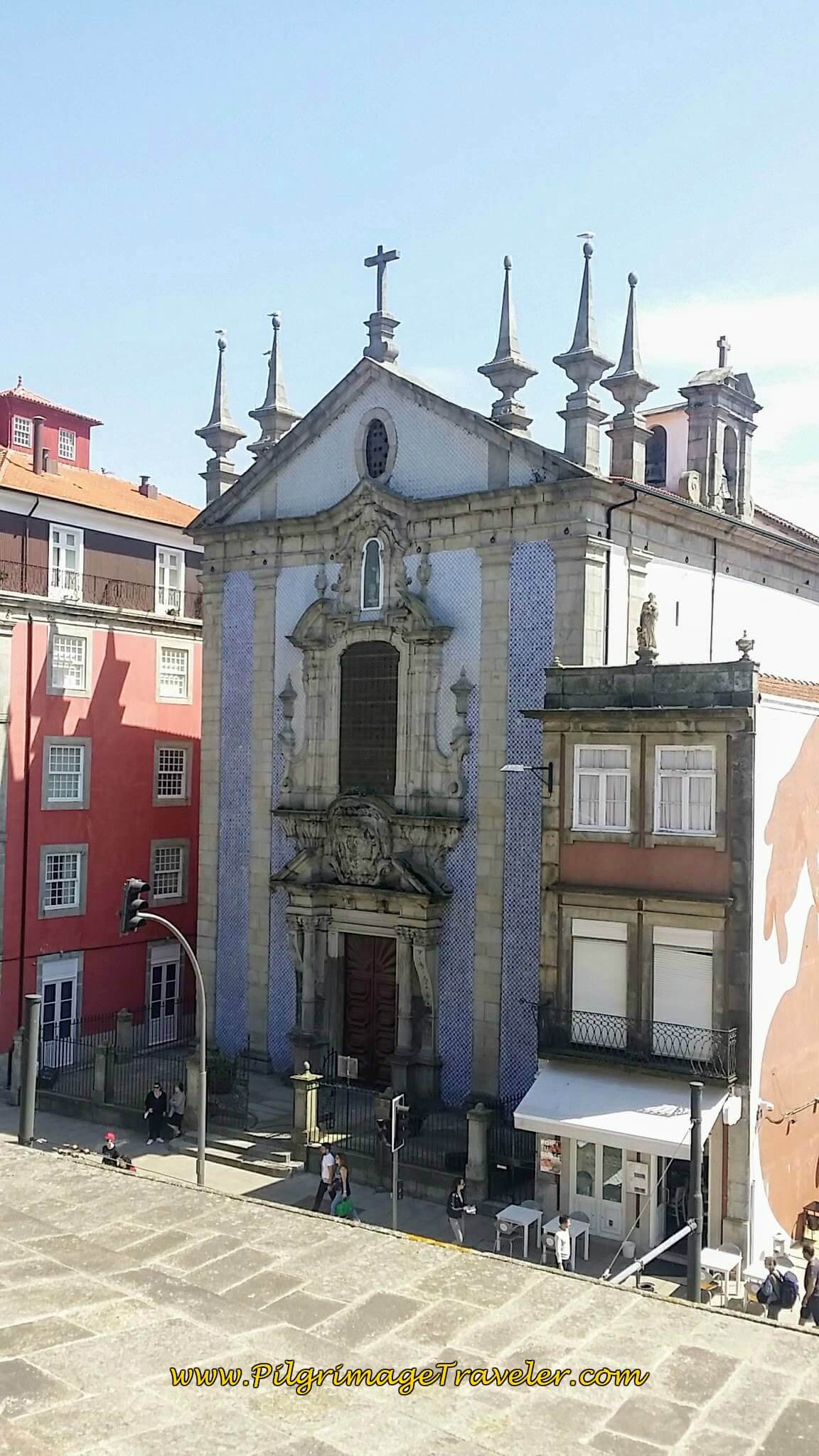 Igreja Paroquial de São Nicolau
Igreja Paroquial de São Nicolau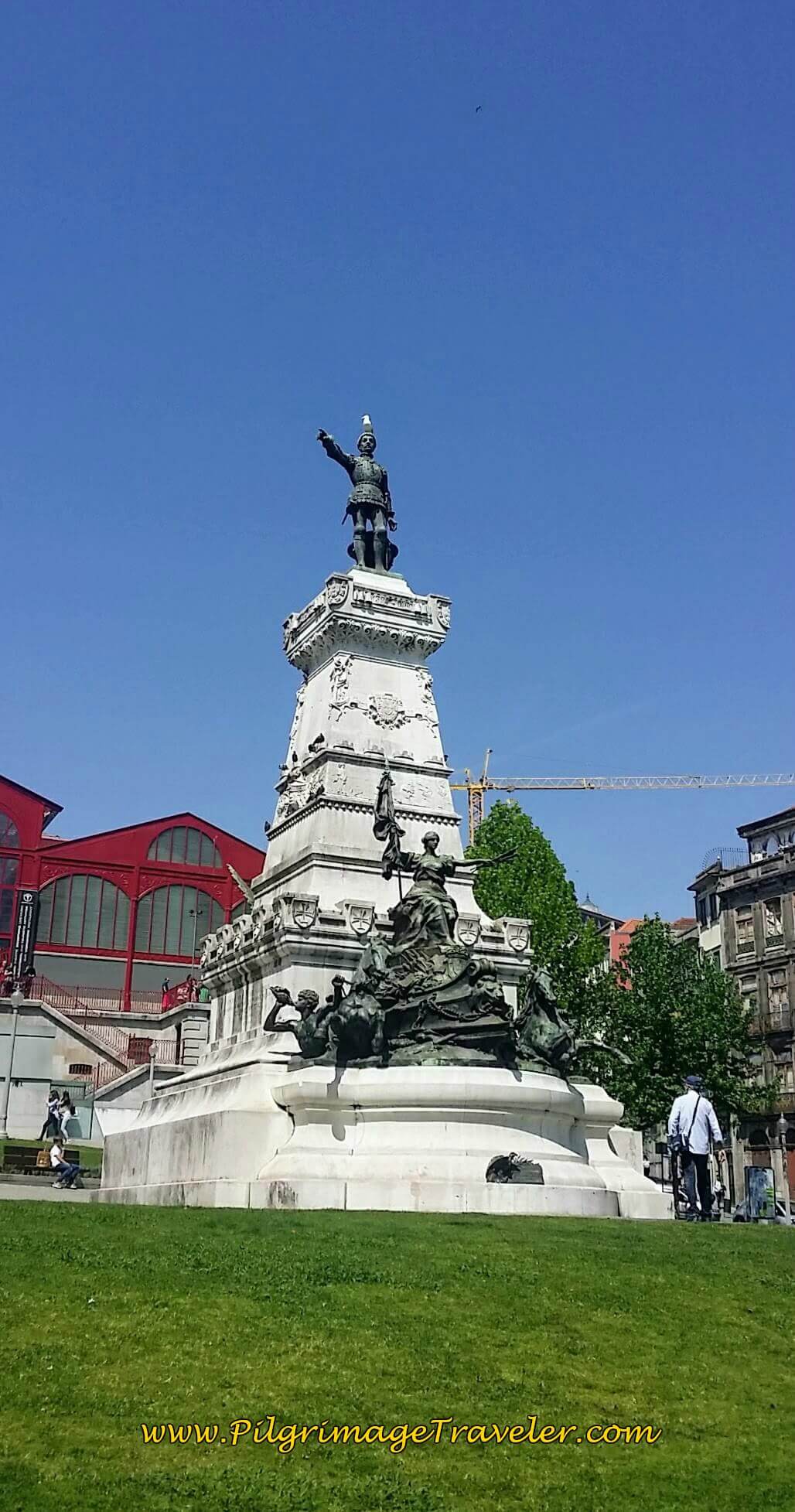 Infante Dom Henrique Monument
Infante Dom Henrique MonumentFrom the Dom Henrique statue, we opted to walk up the hill towards our final monument for the day, the famous train station with the blue murals.
We walked along the Rua de Mouzinho da Silveira, shown to the left side of the photo below with the São Bento metro station in the foreground. This photo was taken from the terrace of the São Bento train station.
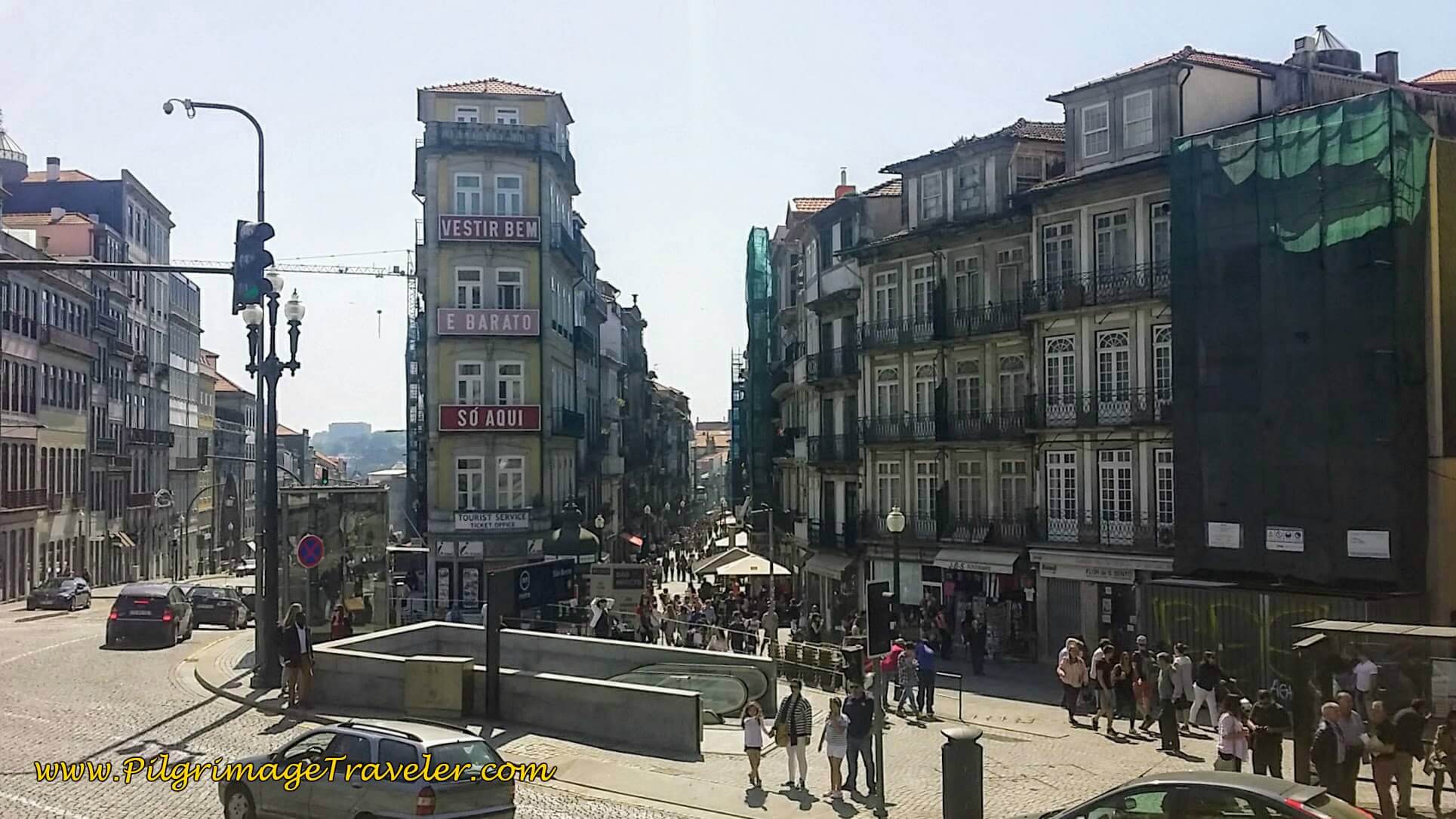 Rua de Mouzinho da Silveira by the Metro Station
Rua de Mouzinho da Silveira by the Metro StationAlso from the terrace of the train station on the right side of the photo, below, one can see another blue-tiled Church, the Igreja de Santo Antonio dos Congregados. So many churches, so little time!
Jump to Camino Portugués Stages
And perhaps, the crowning glory of the day, is the Estação São Bento, the famous train station.
The train station's famous murals depict scenes from Portuguese history, and was inaugurated in 1916.
Here is an azulejo mural of the knight Egas Moniz before the king, Alfonso VII of Leon in the 12th century, offering his life, his wife and his sons during the siege of Guimarães.
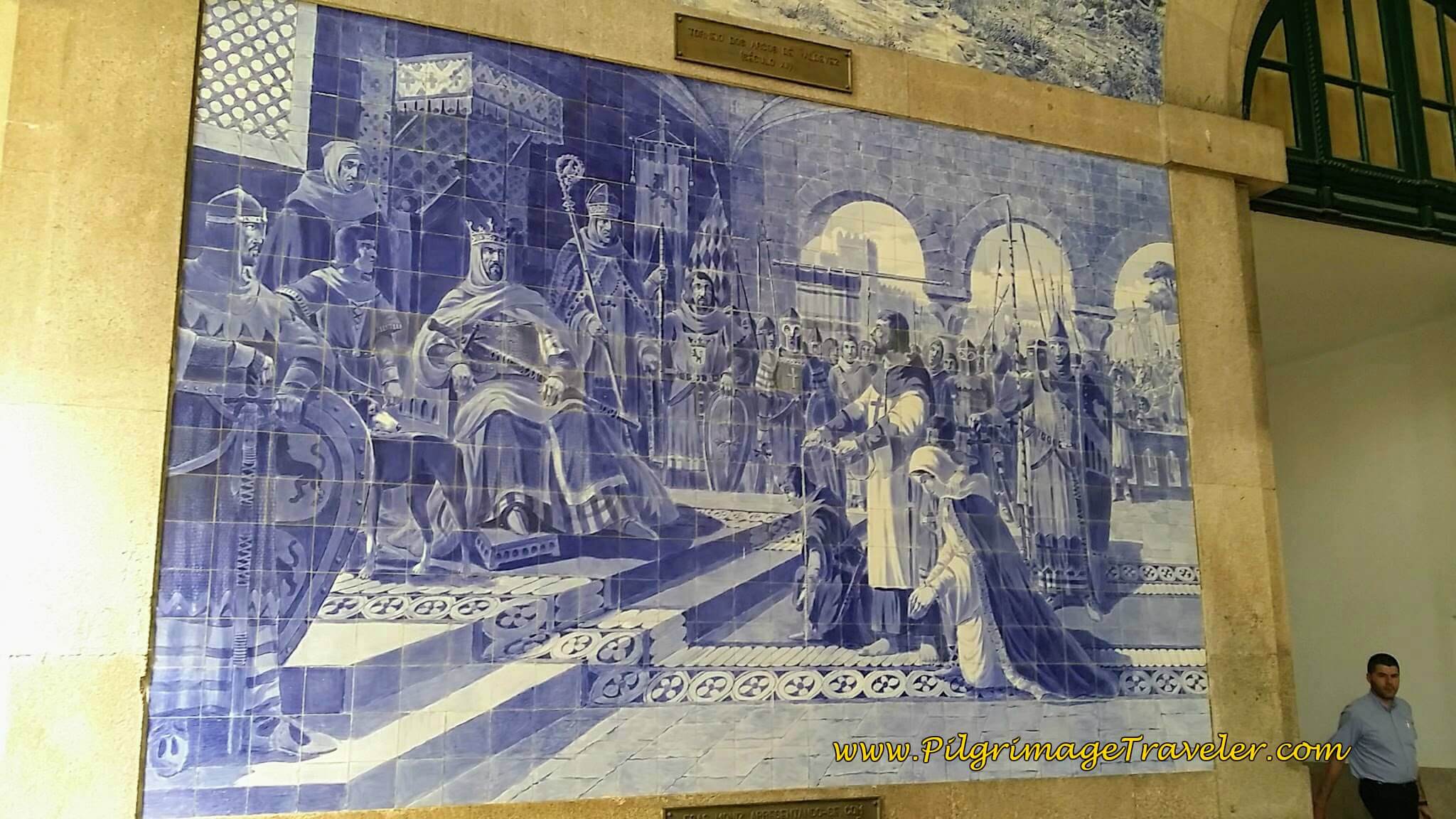 Mural of a Royal Scene in the São Bento Train Station
Mural of a Royal Scene in the São Bento Train StationThe next mural I show is of the entrance of King John I and Philipa of Lancaster into Porto on horseback, to celebrate their marriage in the 14th century.
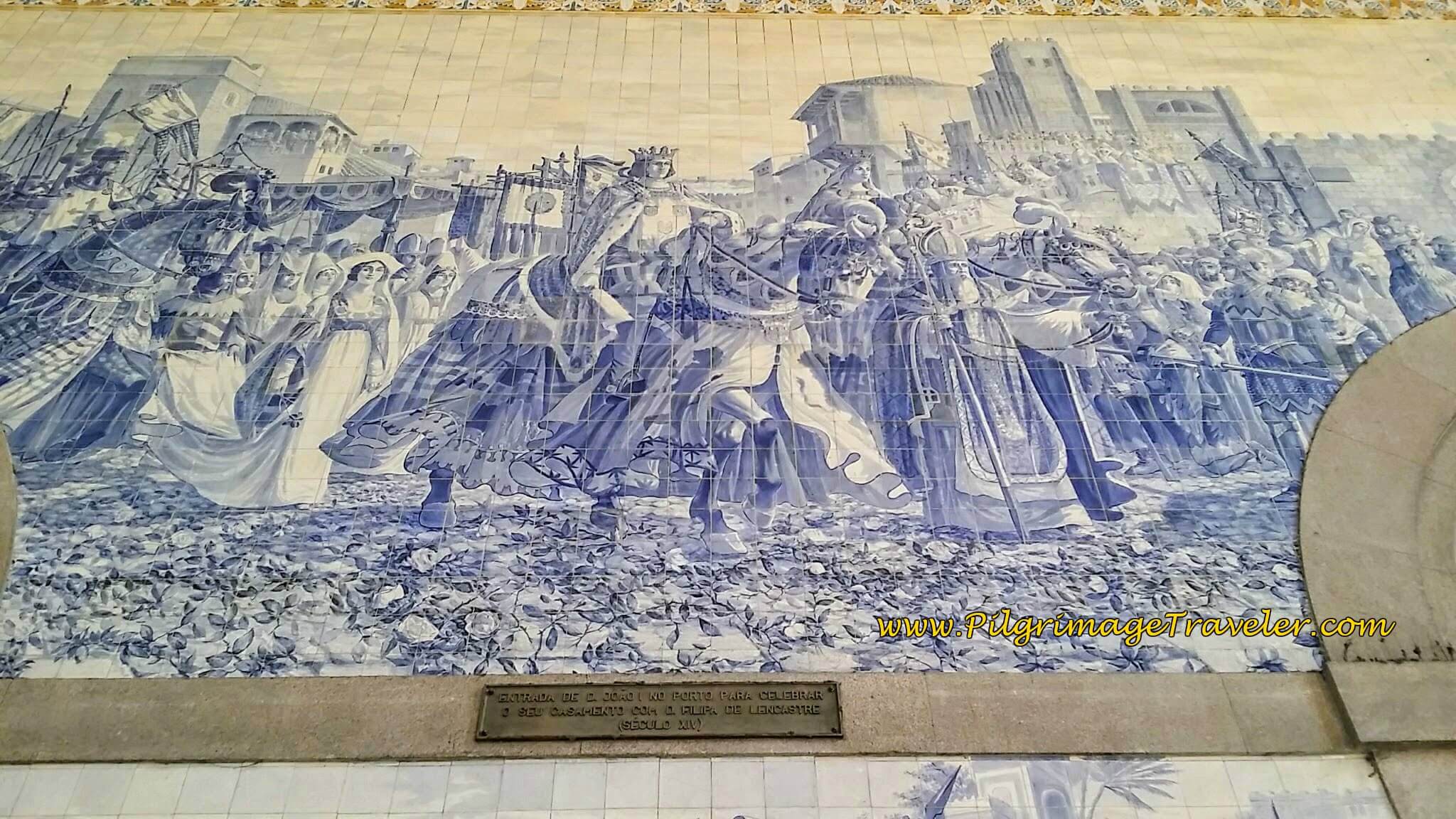 Mural of a Royal Marriage Procession in the São Bento Train Station
Mural of a Royal Marriage Procession in the São Bento Train StationAnd finally, after a long day of touring, we wanted to head to the port houses on the south bank of the Douro to conclude our day. We walked the few kilometers from the train station, back across the Ponte Luiz pedestrian level, and wound our way down from the upper level of the bridge and its look-out, to the lower level of the bridge and the River Douro.
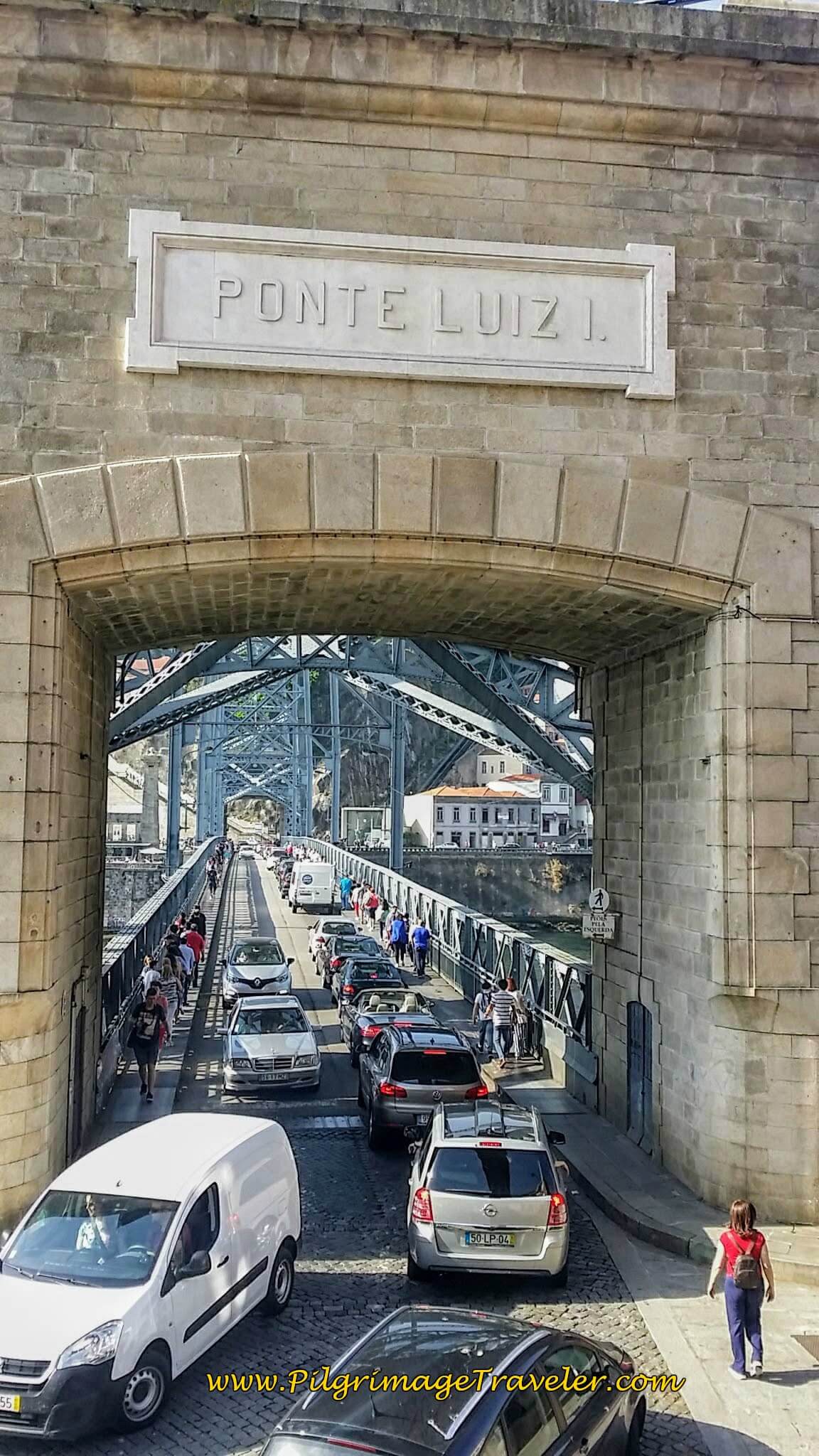 Lower Level of Ponte Luis I Bridge, for Automobile Travel
Lower Level of Ponte Luis I Bridge, for Automobile TravelAs expected, on a warm sunny Sunday afternoon, the street and promenade along the River Douro were crowded with people.
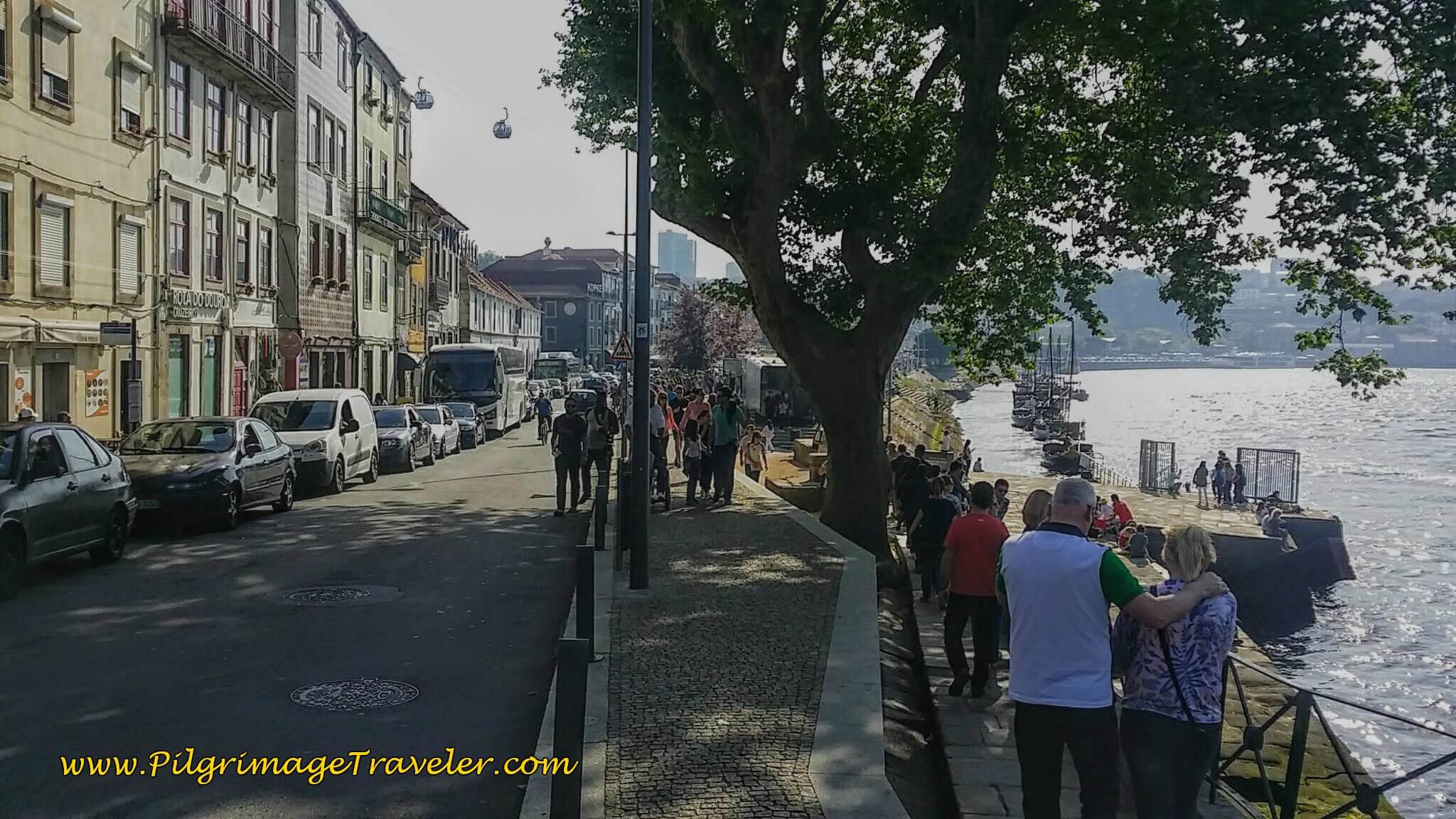 Southside River Promenade
Southside River PromenadeHere is a photo of a typical port winery, the Sandeman. We didn’t know at the time, but we know now that the House of Sandeman also has a hostel and rooms for the night if you don't want to walk home after your port wine fix!
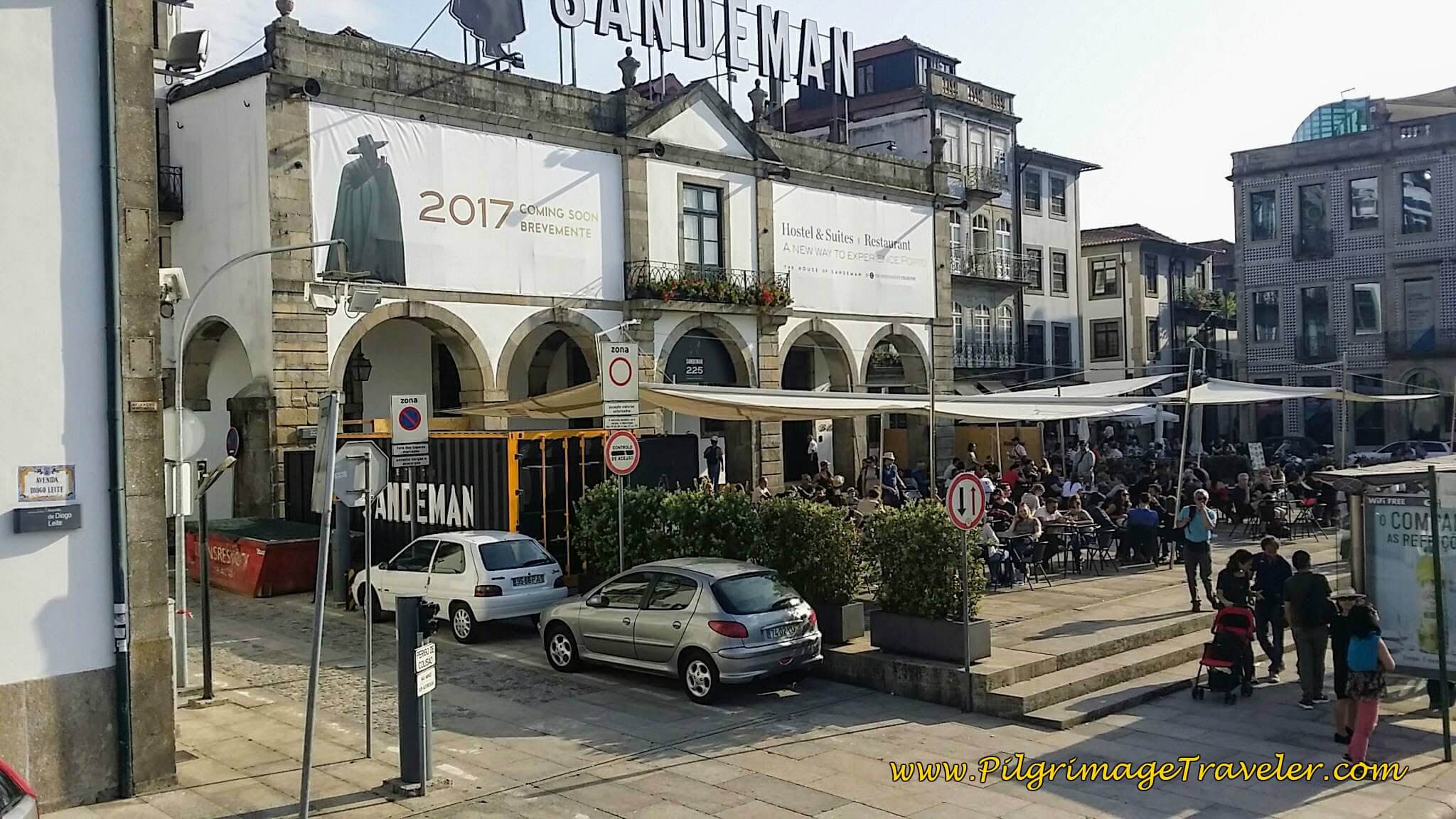 Sandeman Port House
Sandeman Port HouseWe chose to try out a less crowded port house, but the one we chose, the Quinta do Noval was a mistake! The waitress did her best to get us to try the most expensive port on the menu, about 35 Euros a glass! We chose the cheapest instead, about 5-6 Euros, and got this amount, in the photo below! I guess there was a reason the Sandeman was crowded?
However, the port is fabulous, and we imbibed in another restaurant earlier for an almost-as-tasty experience at 1/3rd the price. So choose your port house carefully, unless you have a much more discerning palate than mine!
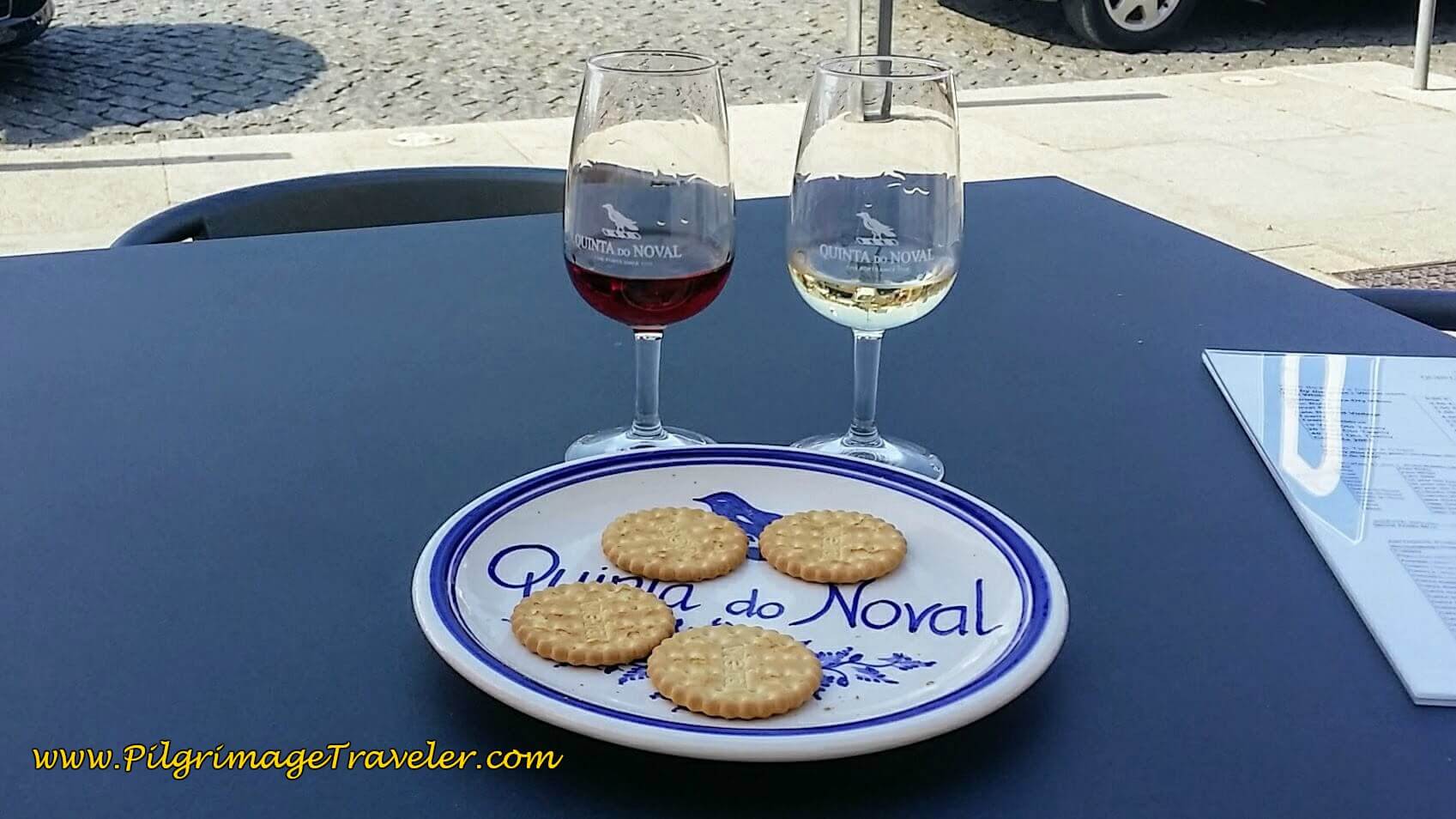 Port Wine Tasting
Port Wine TastingAnd the final beauty of our day, was that the red line of the Hop On Hop Off bus came right by the Quinta do Noval and took us up the hill to our hotel farther south, in Vila Nova de Gaia. No taxi-ride necessary!
I hope your own day(s) in Porto are as fabulous as ours! It was really no break from walking for us at all, but it was a welcome day of luxurious sightseeing.
Clearly, you will not be bored in Porto! Indeed there is always somewhere to be, something to do and someone to see!
Camino Portugués eBook Guides
Our Downloadable Camino Portugués eBook Guides in PDF Format contain all the valuable information from our web pages, for comfortable reading offline and without ads on your personal device. Don't carry a hard copy guide book to increase your pack weight. Use our digital guides on your next Camino instead!
Our ebook guides are packed with frequently updated information, because a digital format is more nimble than hard-copy publishing. Our eBook Guide is unique because we also entertain and immerse you with our story! Click on any eBook above for more information.
Buy only what you need OR buy ALL FOUR eBooks for the price of THREE - a 25% savings! Click here for more information or BUY NOW at only 17.85!
Camino Portugués Stages
Lisbon to Porto
Senda Litoral or the Coastal Routes: Porto to Santiago
Skip to Central Route Below, for Final Days 22-25 to Santiago
Central Route: Porto to Santiago
Variante Espiritual
Please Consider Showing Your Support
Many readers contact me, Elle, to thank me for all the time and care that I have spent creating this informative website. If you have been truly blessed by my efforts, have not purchased an eBook, yet wish to contribute, I am very grateful. Thank-you!
Search This Website:
🙋♀️ Why Trust Us at the Pilgrimage Traveler?

We’re not a travel agency ~ we’re pilgrims, just like you.
We've walked Pilgrimage Routes Across Europe!
💬 We’ve:
- Gotten lost so you don’t have to. 😉
- Followed yellow arrows in the glowing sunlight, the pouring rain and by moonlight. ☀️🌧️🌙
- Slept in albergues, hostals & casa rurals. Ate and drank in cafés along the way. 🛌 😴
- Created detailed and downloadable GPS maps and eBook Guides, full of must-have information based on real pilgrimage travels. 🧭 🗺️
- Shared our complete journeys, step by step to help YOU plan your own ultimate pilgrimage and walk with your own Heart and Soul. 💙✨
Every detail is from our own experiences ~ no fluff, no AI rewrite. Just fellow pilgrims sharing the way. We add a touch of spirituality, a big dose of ❤️ and lots of wisdom from the road.
Ultreia and Safe Pilgrimage Travels, Caminante! 💫 💚 🤍
Follow Me on Pinterest:
Find the Pilgrimage Traveler on Facebook:
Like / Share this page on Facebook:
Follow Me on Instagram:
***All Banners, Amazon, Roamless and Booking.com links on this website are affiliate links. As an Amazon associate and a Booking.com associate, the Pilgrimage Traveler website will earn from qualifying purchases when you click on these links, at no cost to you. We sincerely thank-you as this is a pilgrim-supported website***
PS: Our eBook Guide books are of our own creation and we appreciate your purchase of those too!!
Shroud Yourself in Mystery, along the Via de Francesco!
Walk in the Footsteps of St. Francis, and Connect Deeply to the Saint and to Nature in the Marvelous Italian Countryside!
Need suggestions on what to pack for your next pilgrimage? Click Here or on the photo below!
Carbon fiber construction (not aluminum) in a trekking pole makes them ultra lightweight. We like the Z-Pole style from Black Diamond so we can hide our poles in our pack from potential thieves before getting to our albergue! There are many to choose from! (See more of our gear recommendations! )
Gregory BackPack - My Favorite Brand
Do not forget your quick-dry microfiber towel!
Booking.com
My absolute favorite book on how to be a pilgrim:
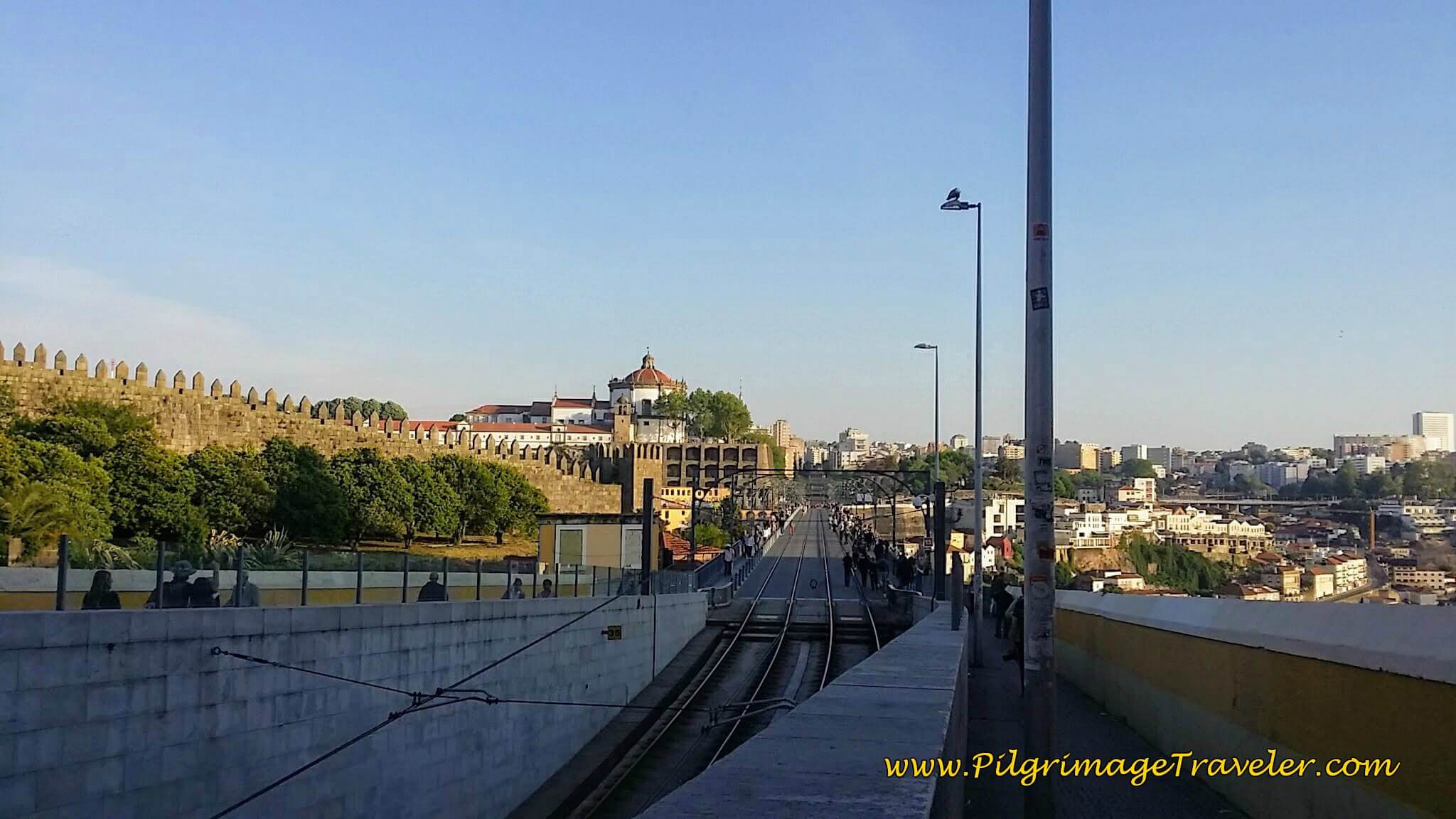
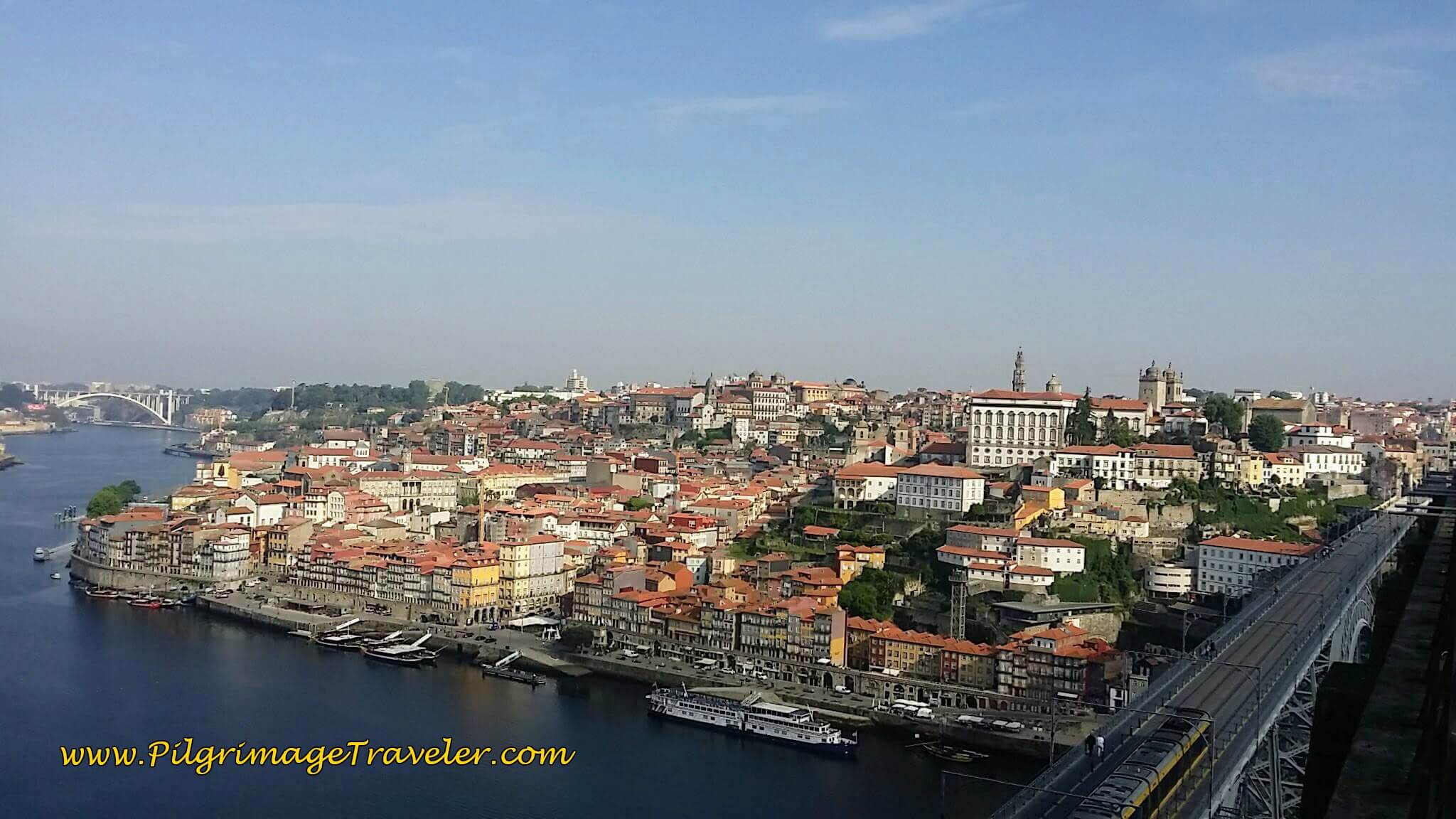

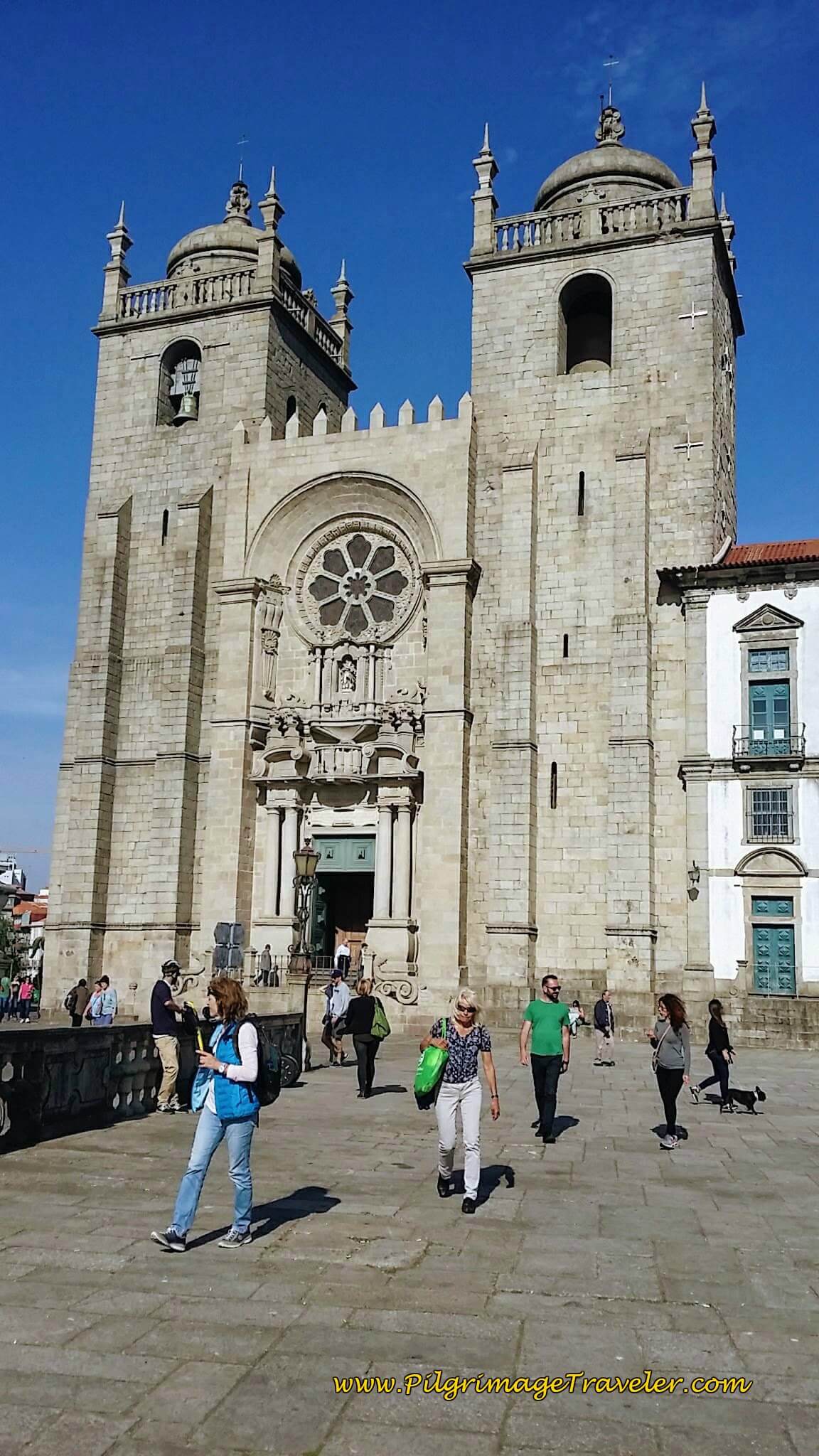
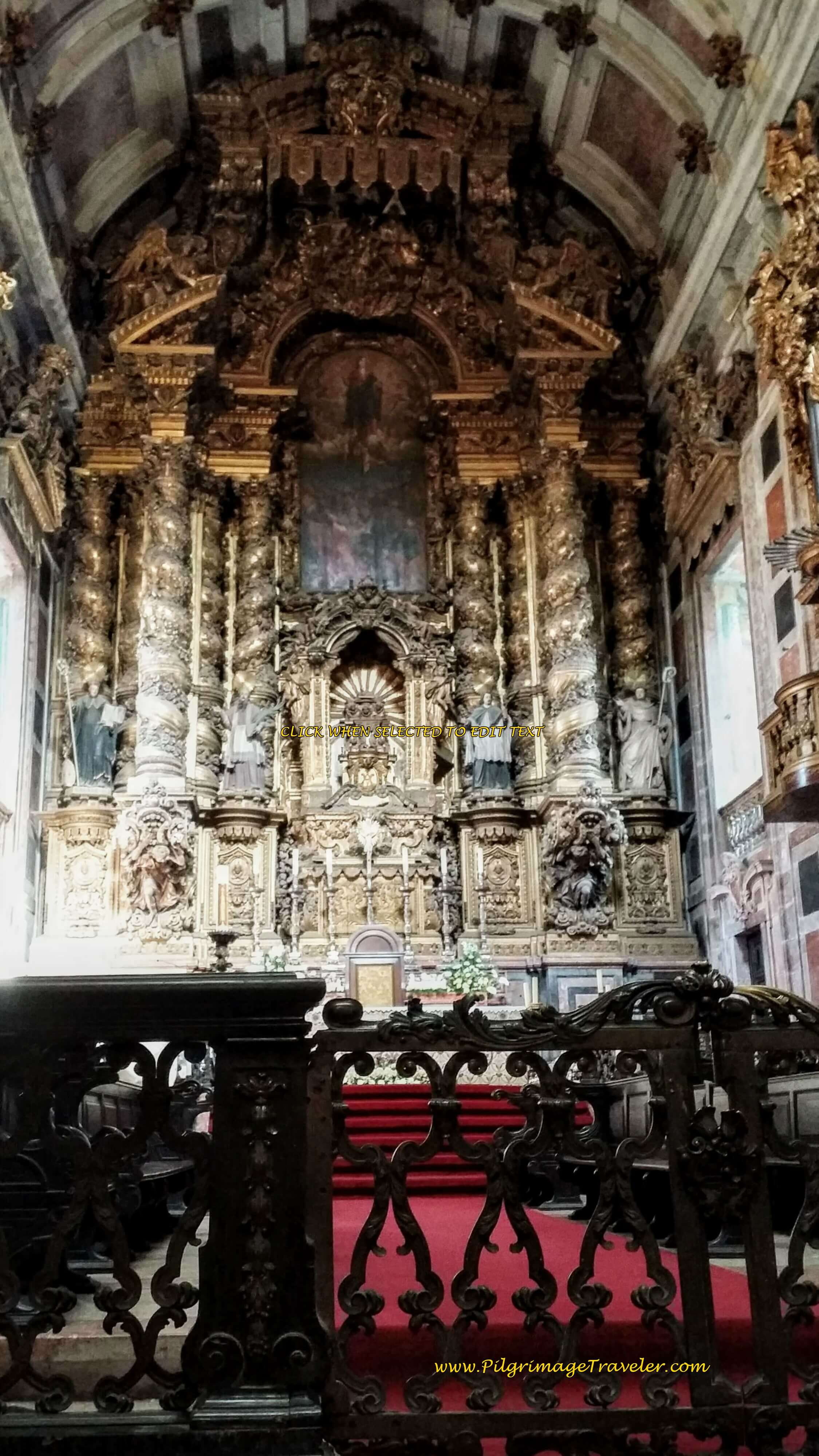
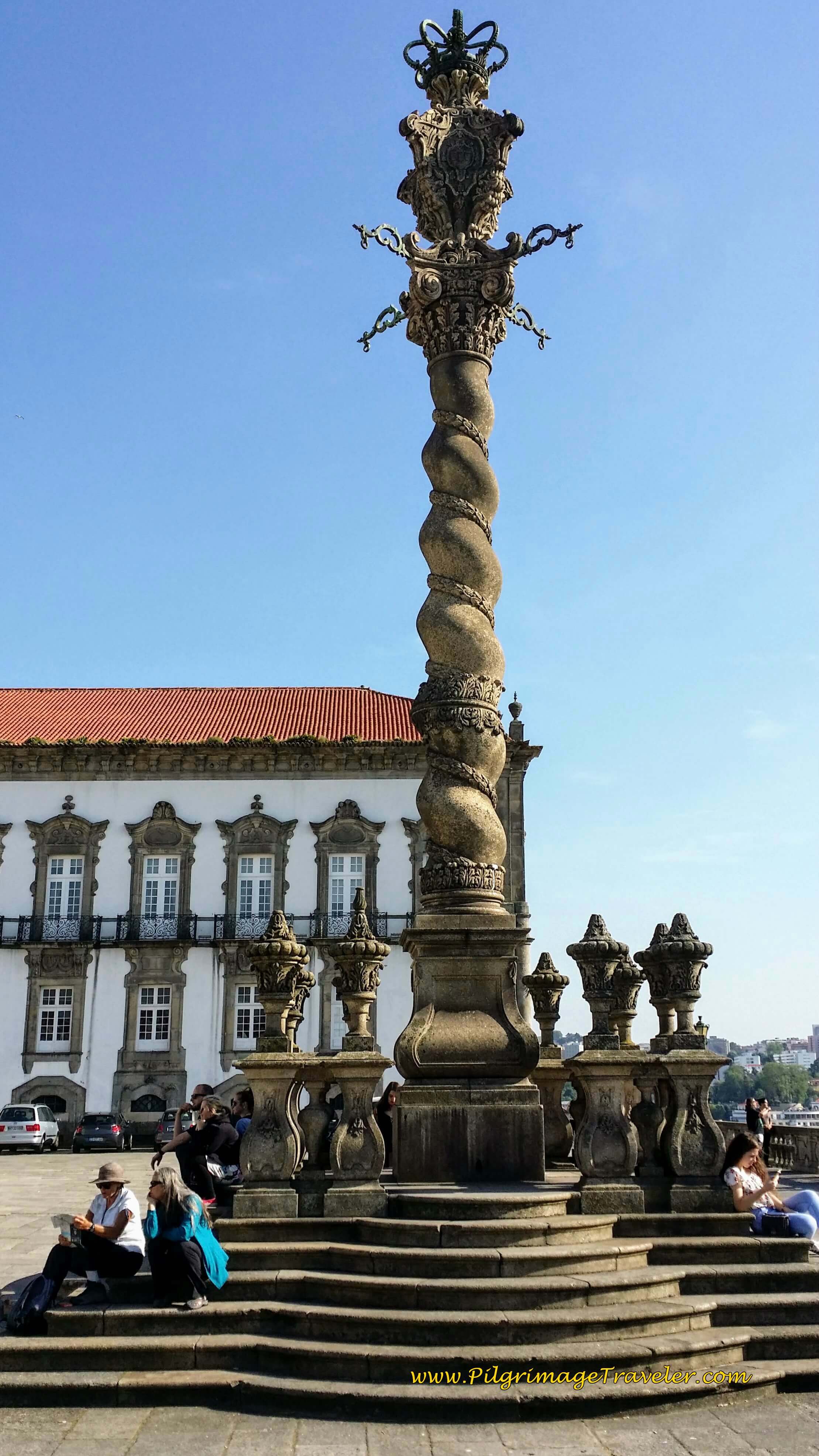
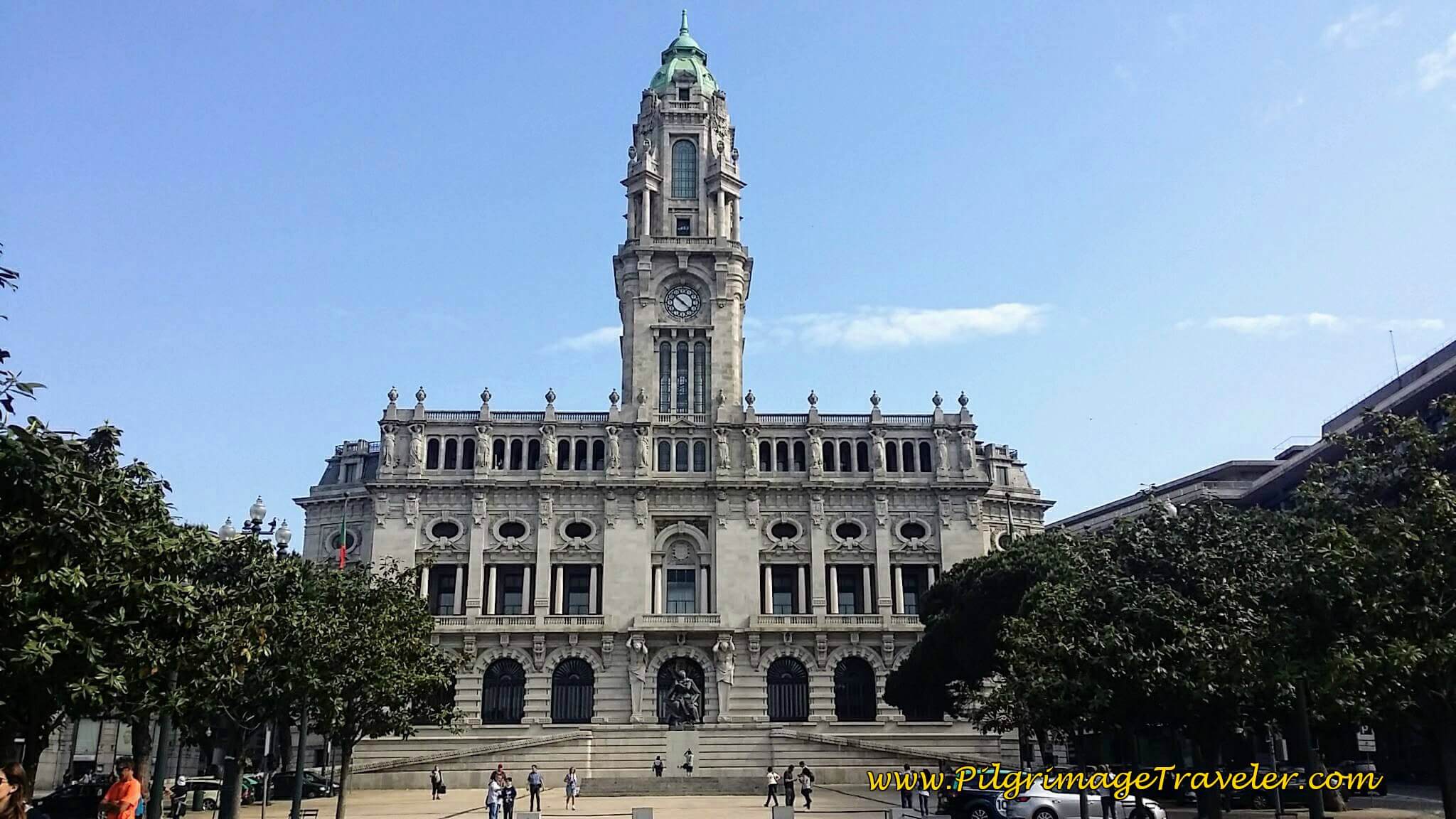
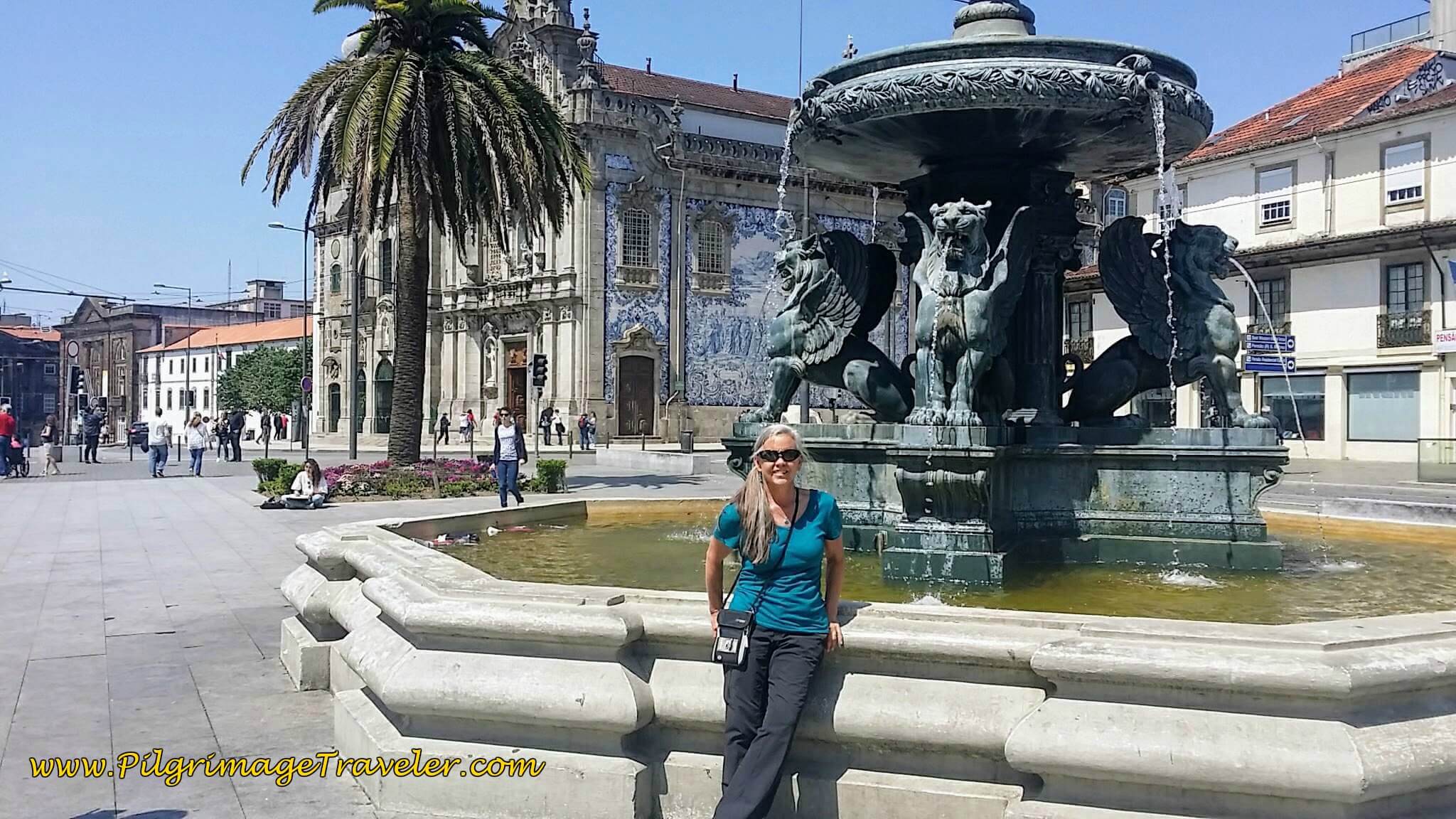
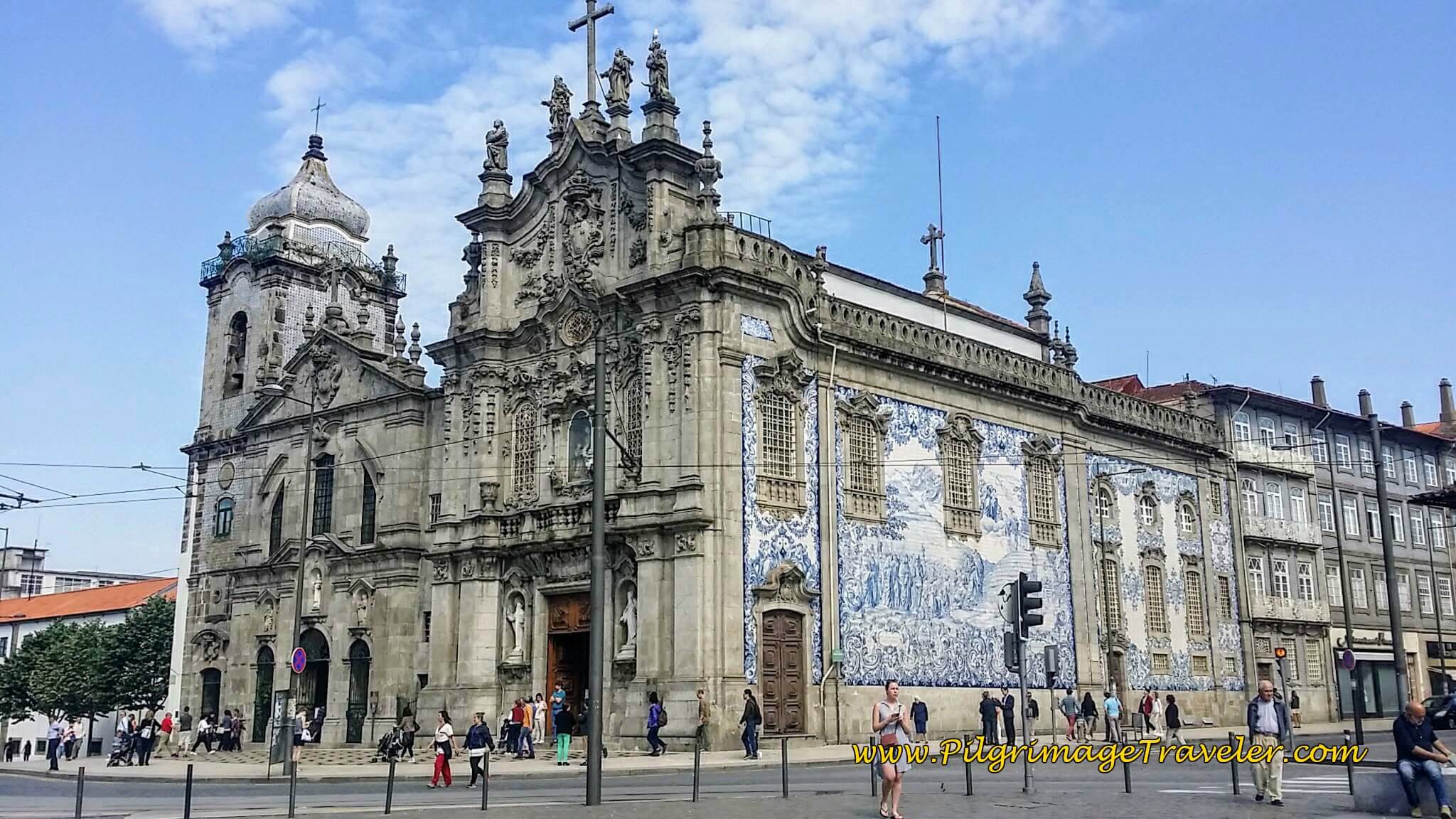

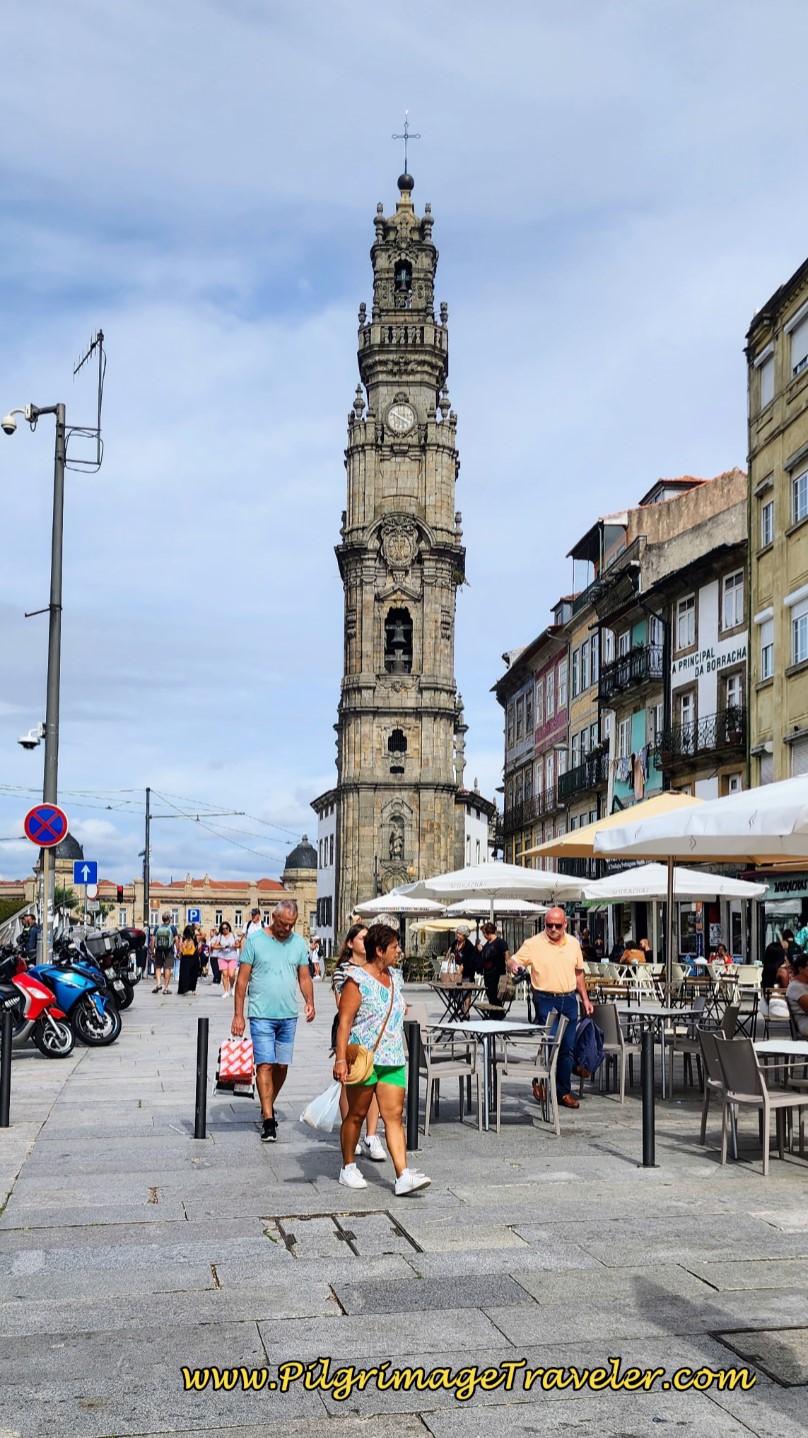
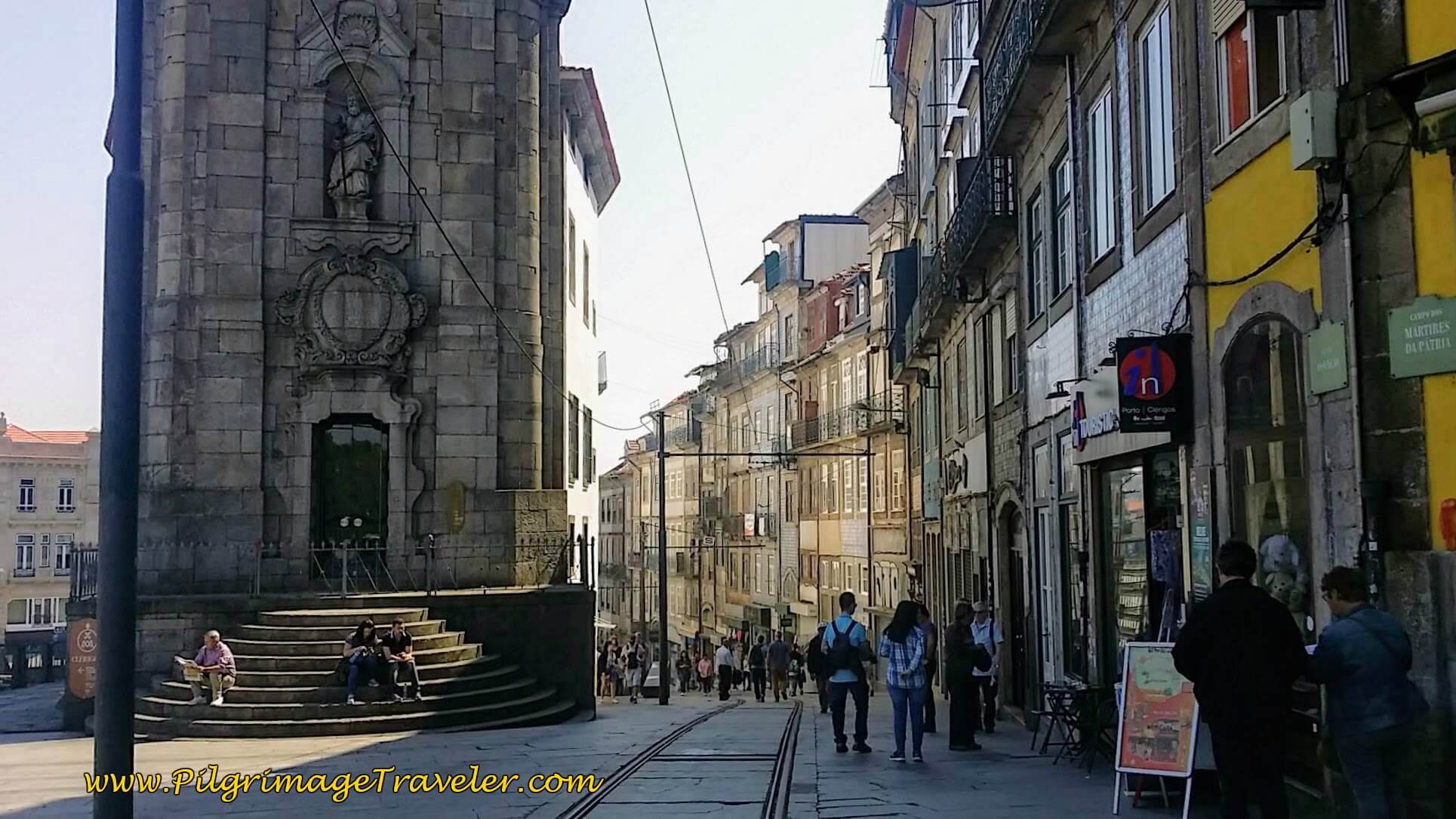
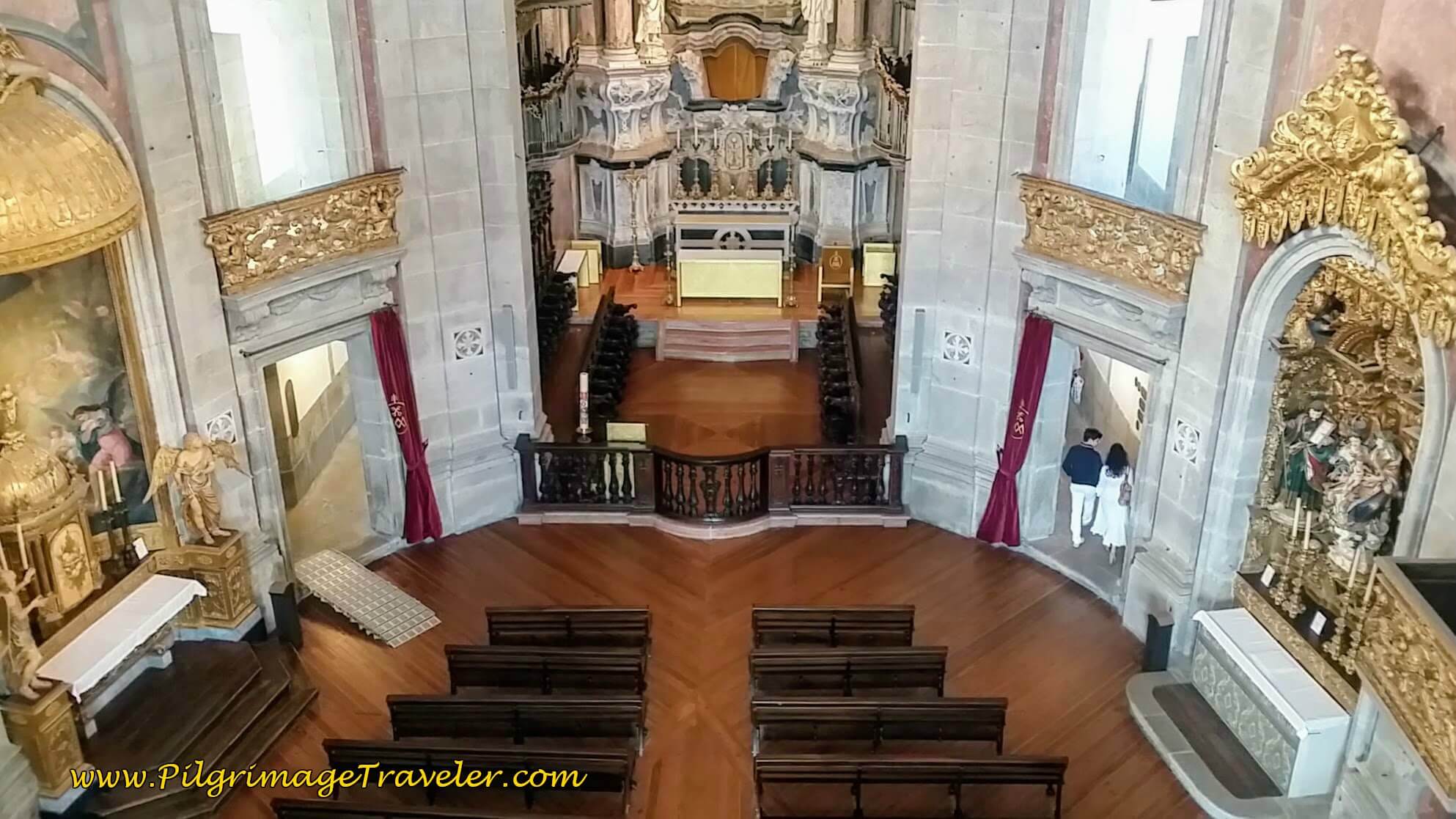
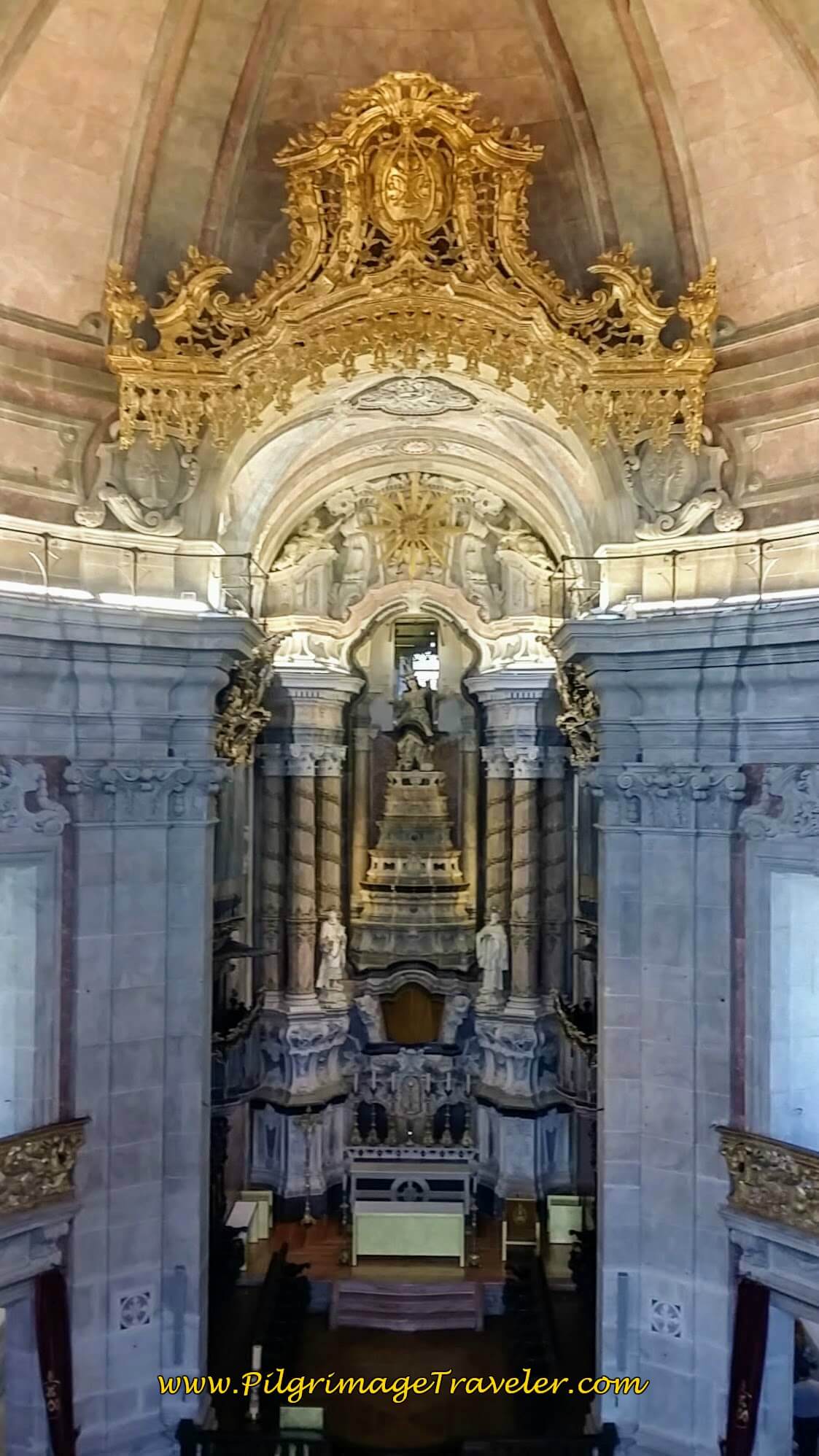
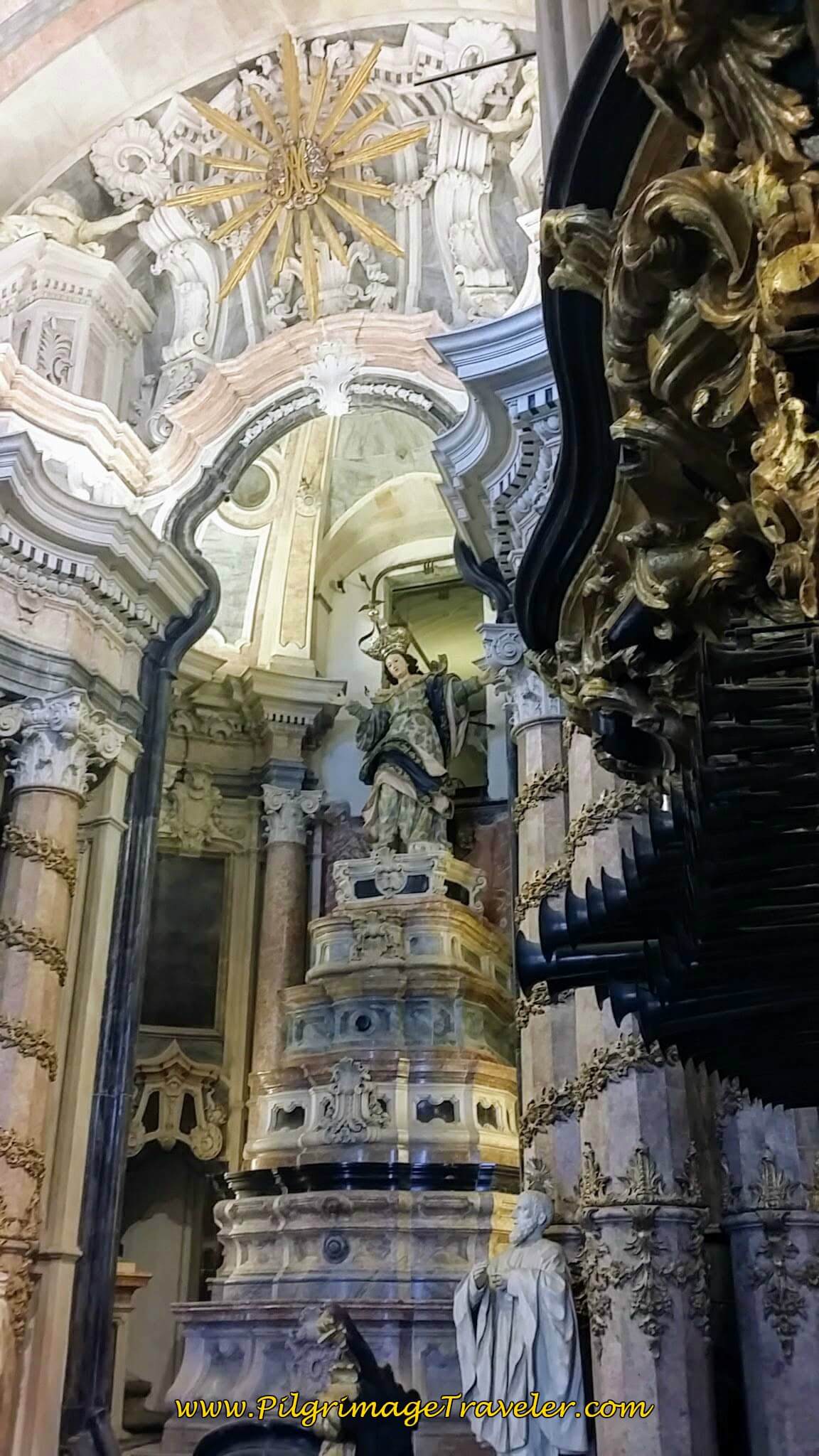
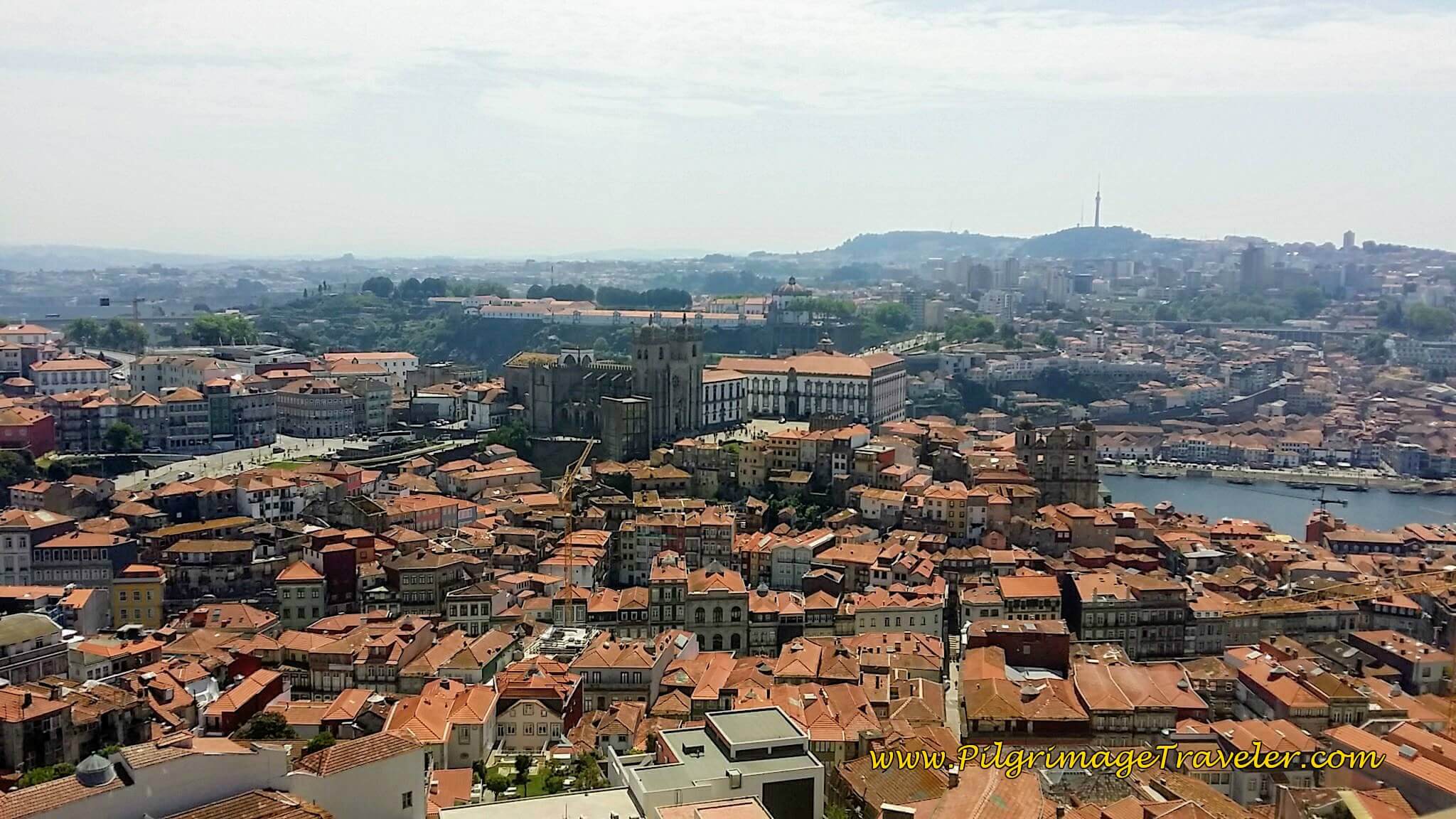
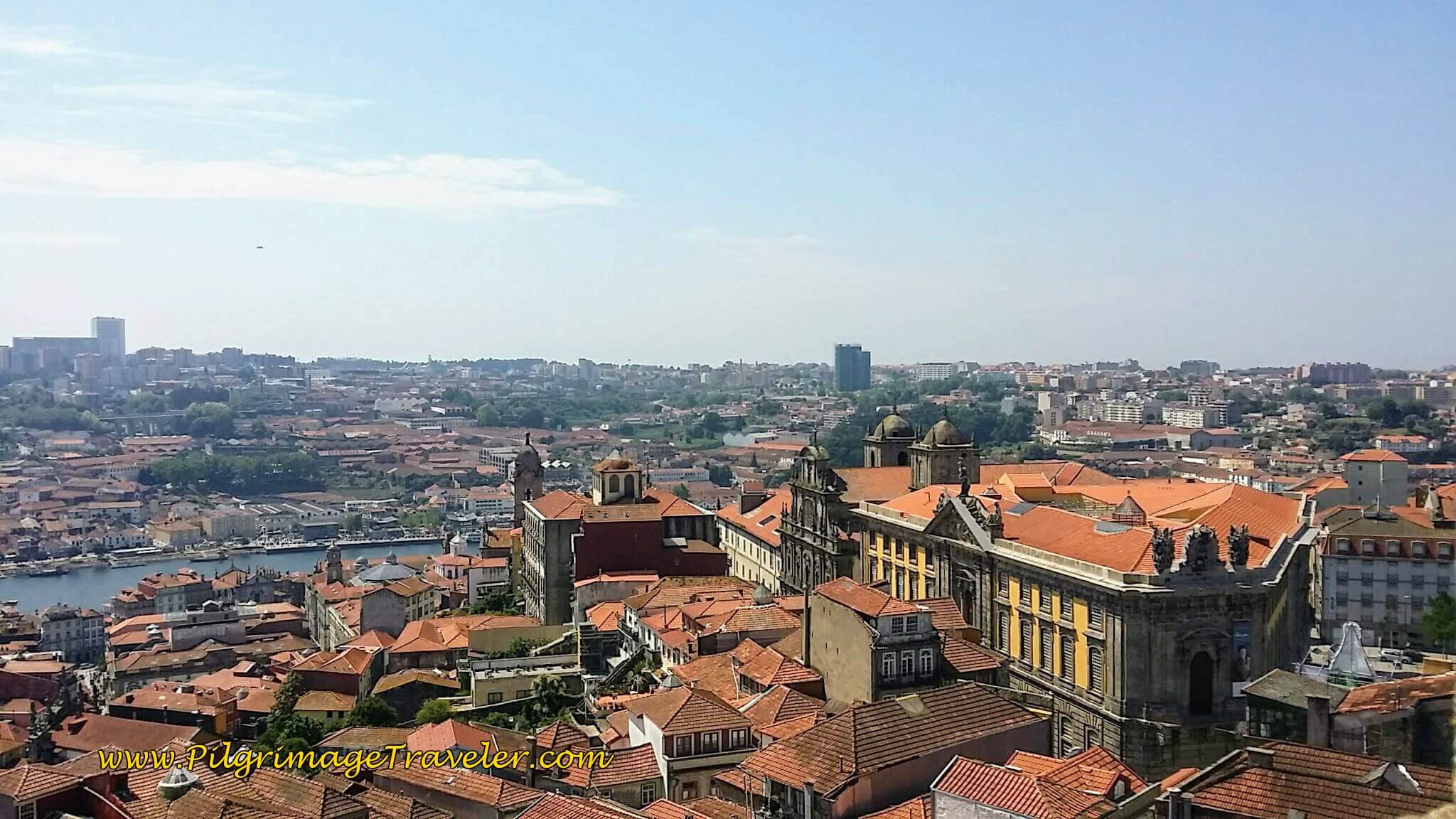
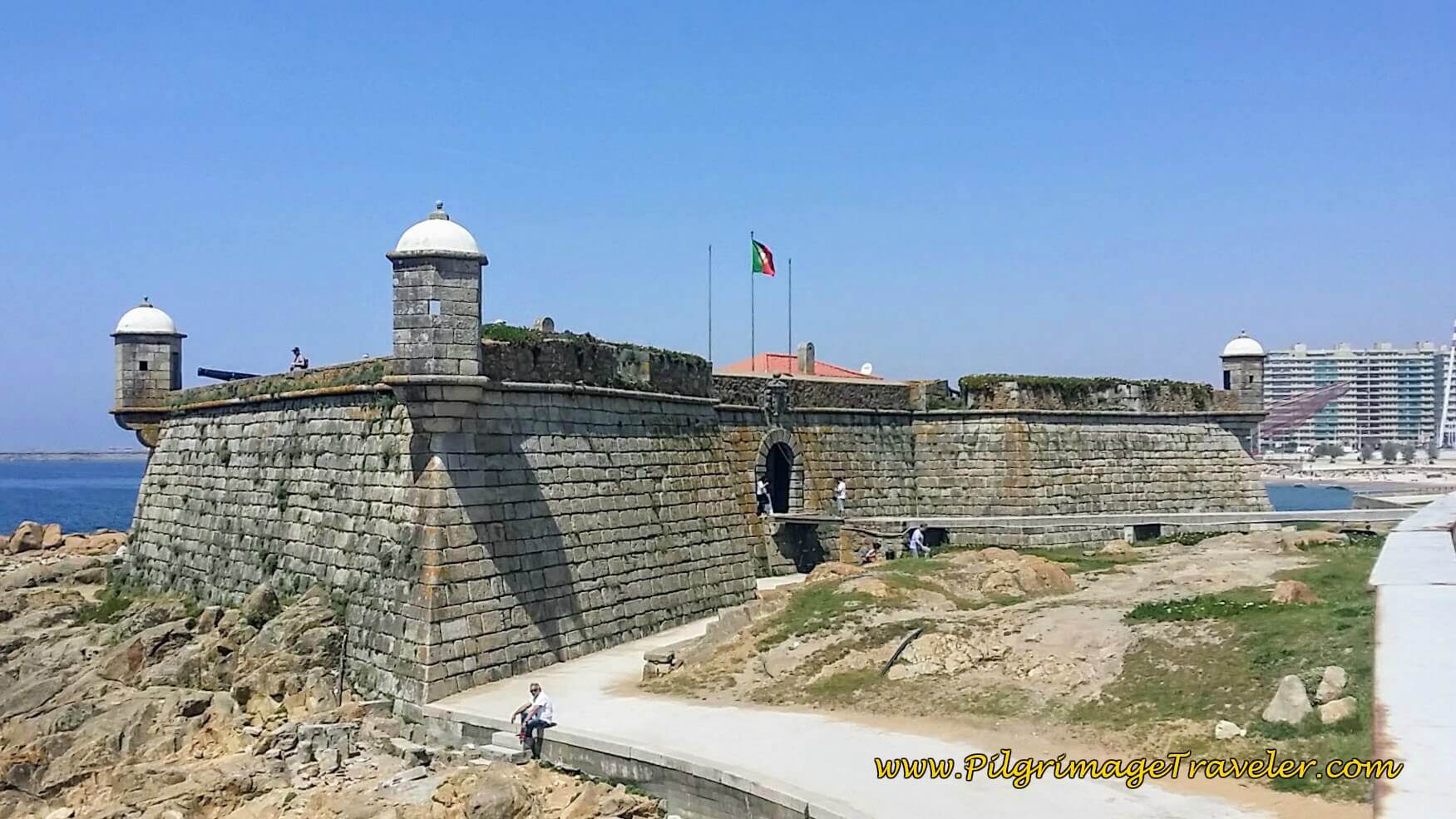
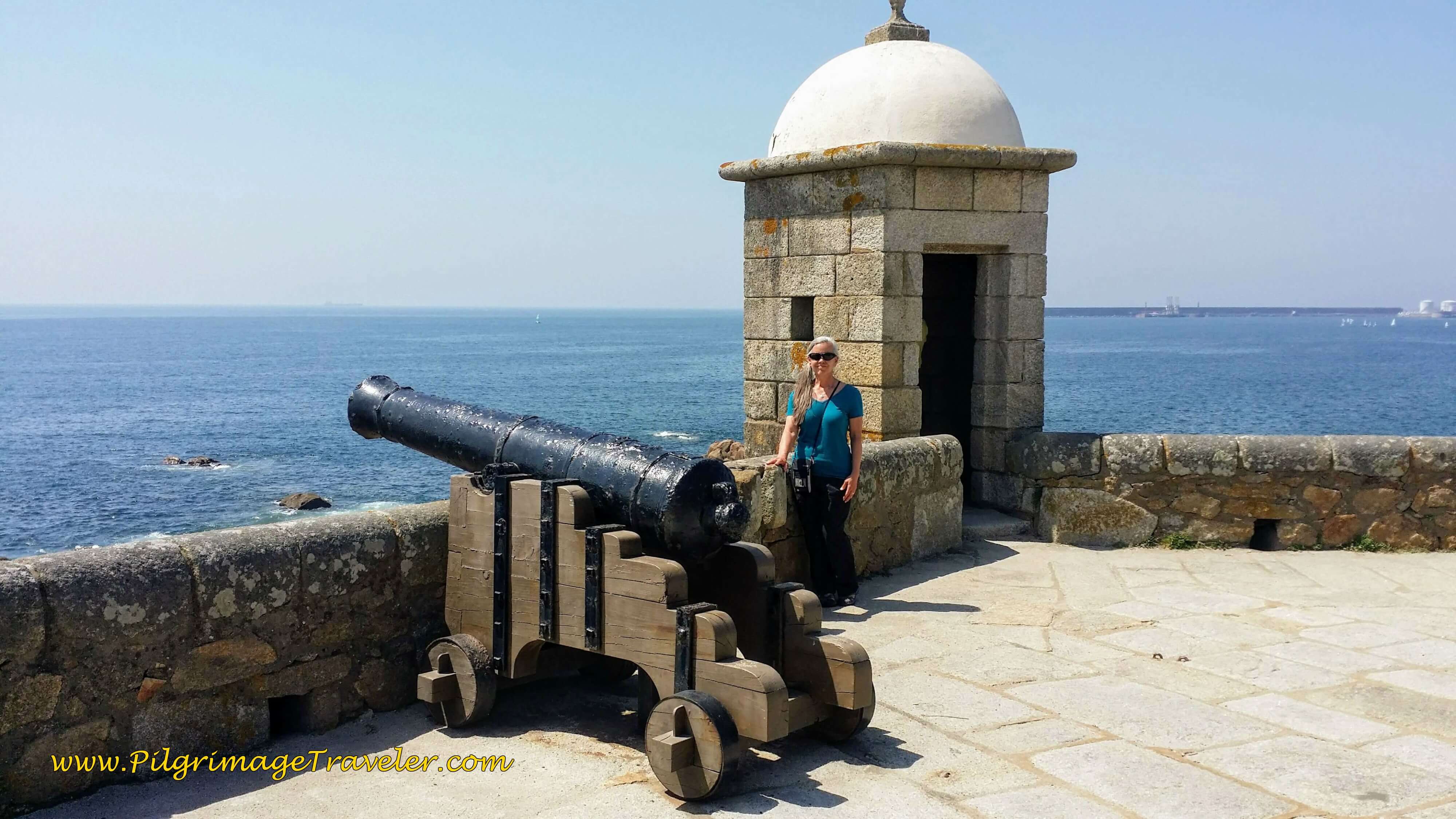
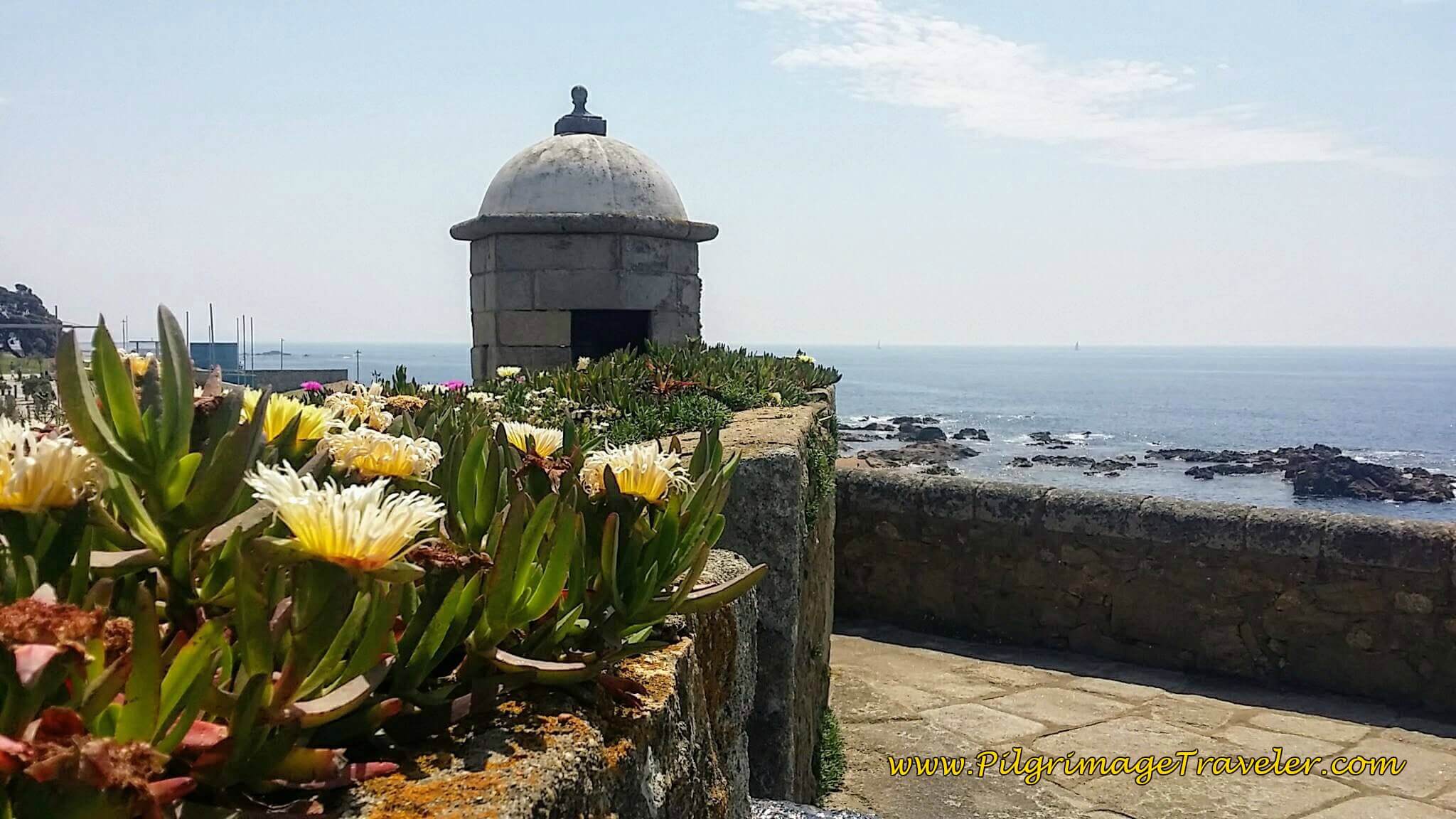
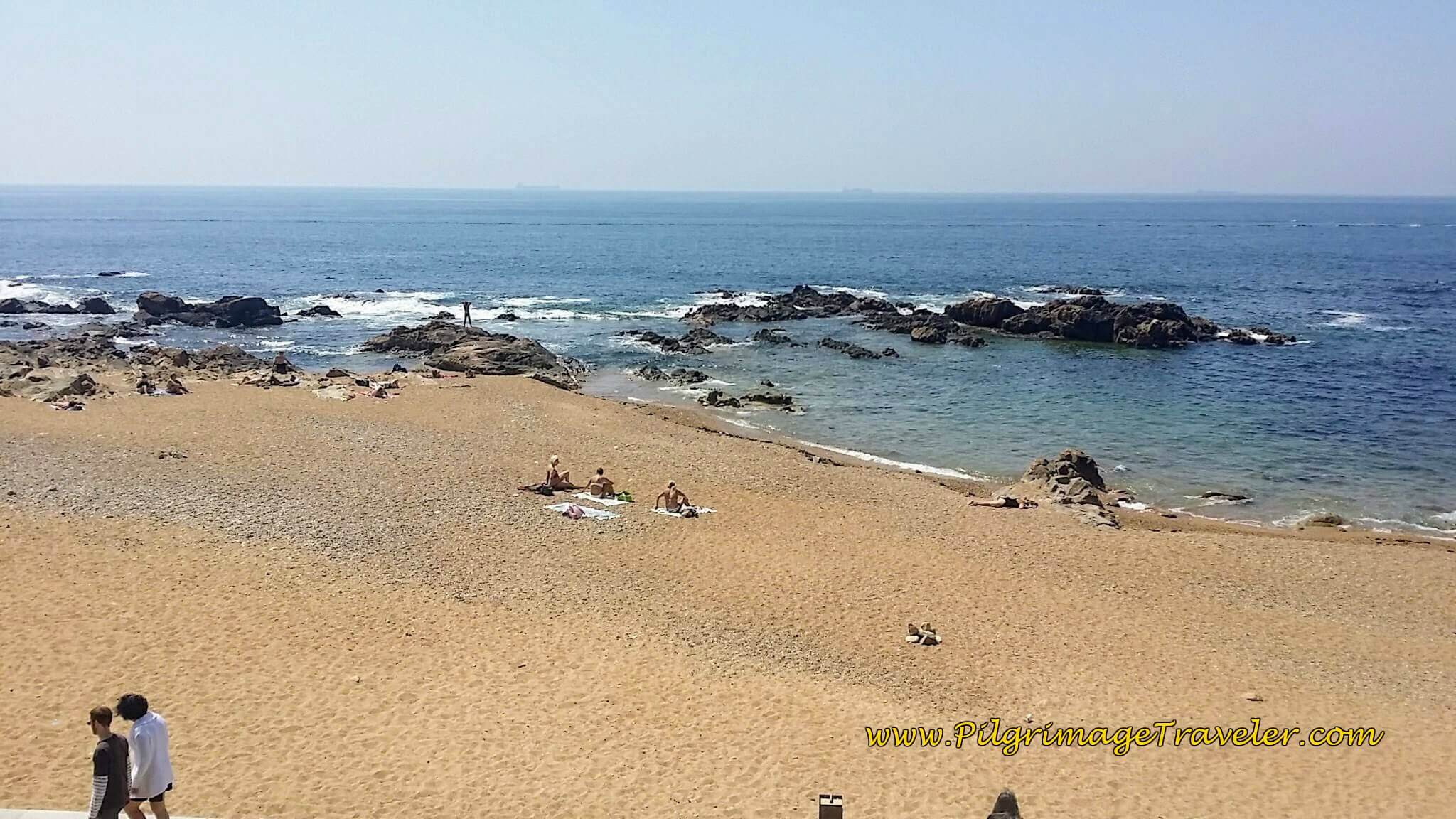
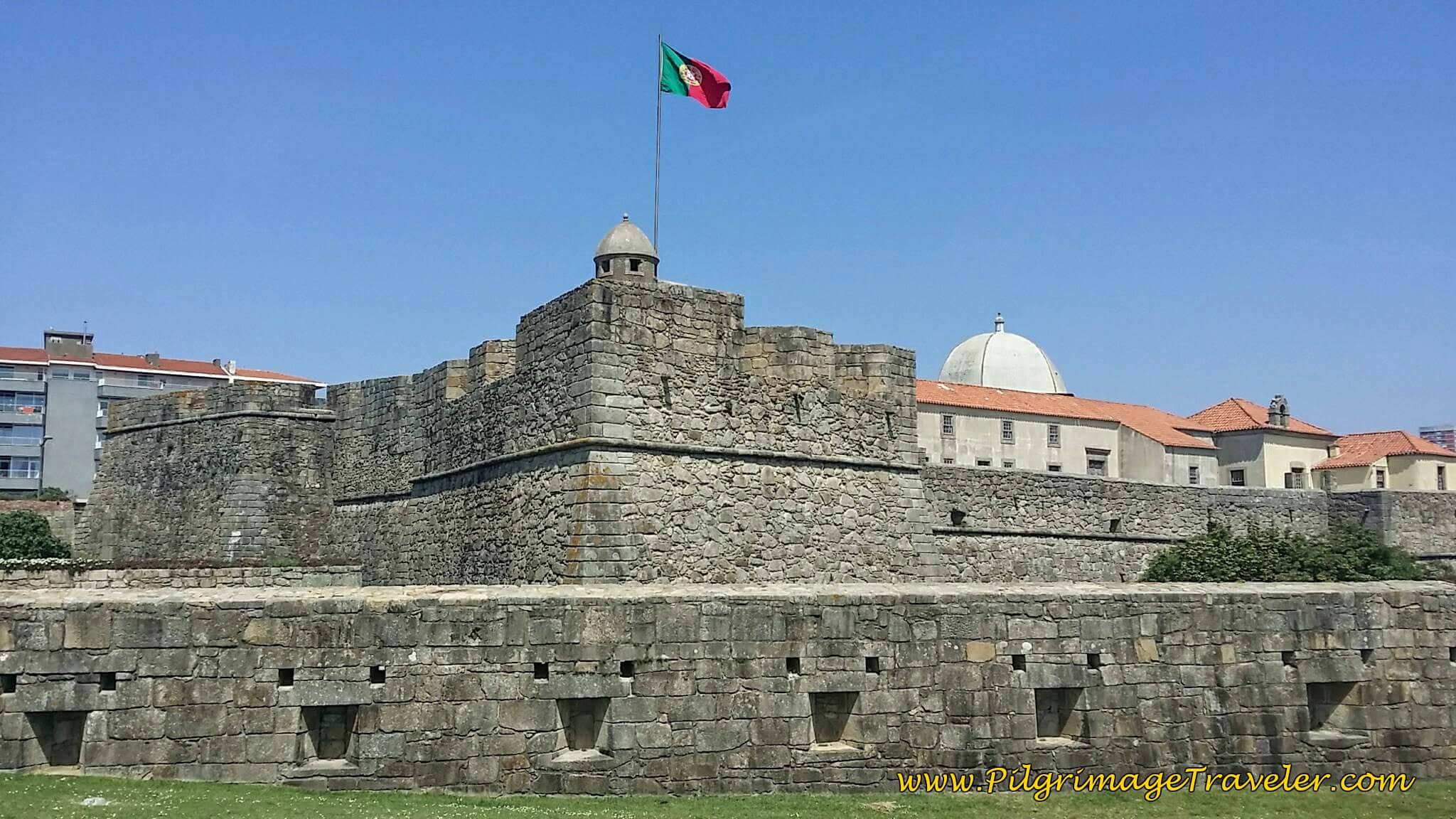
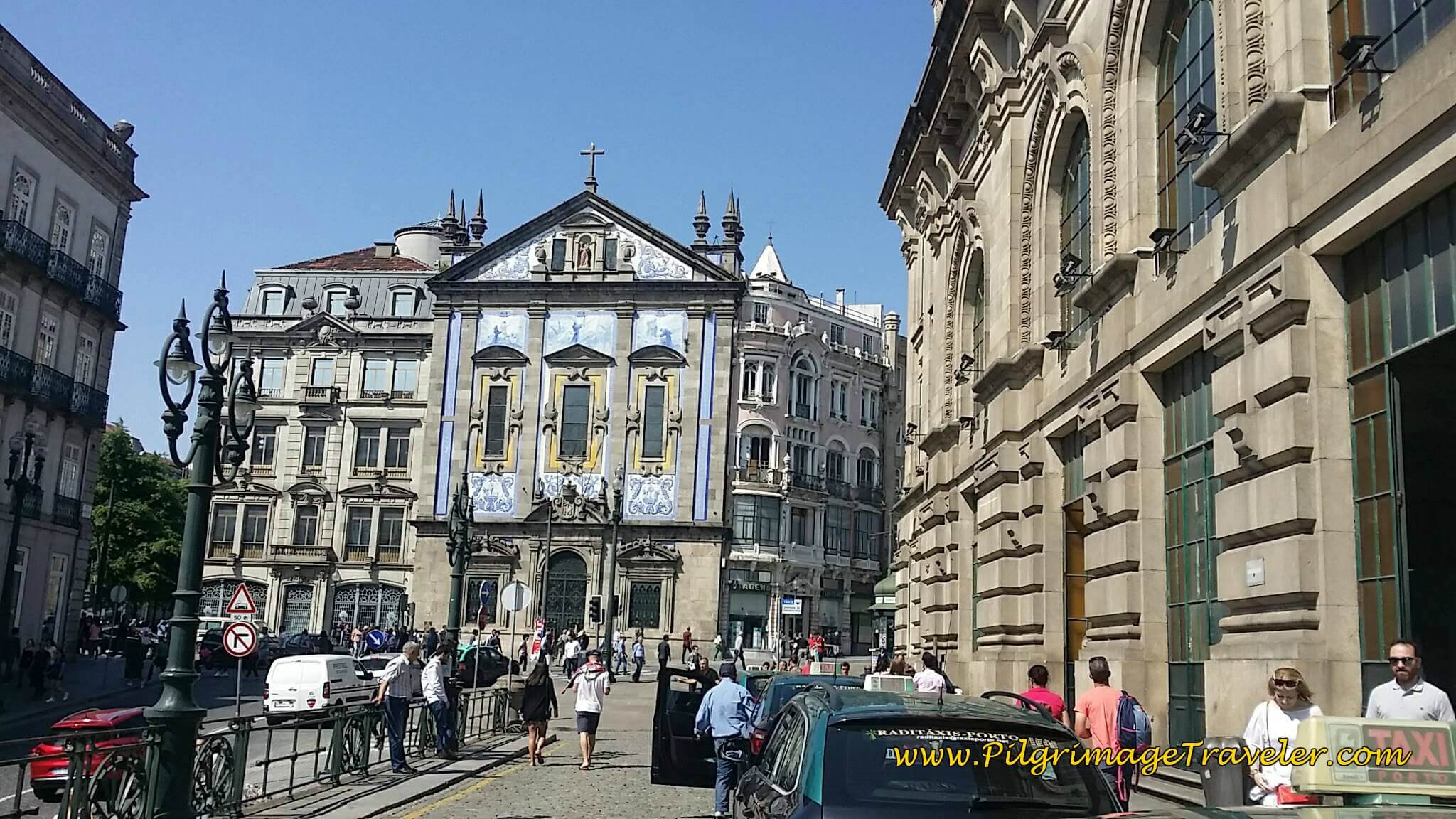
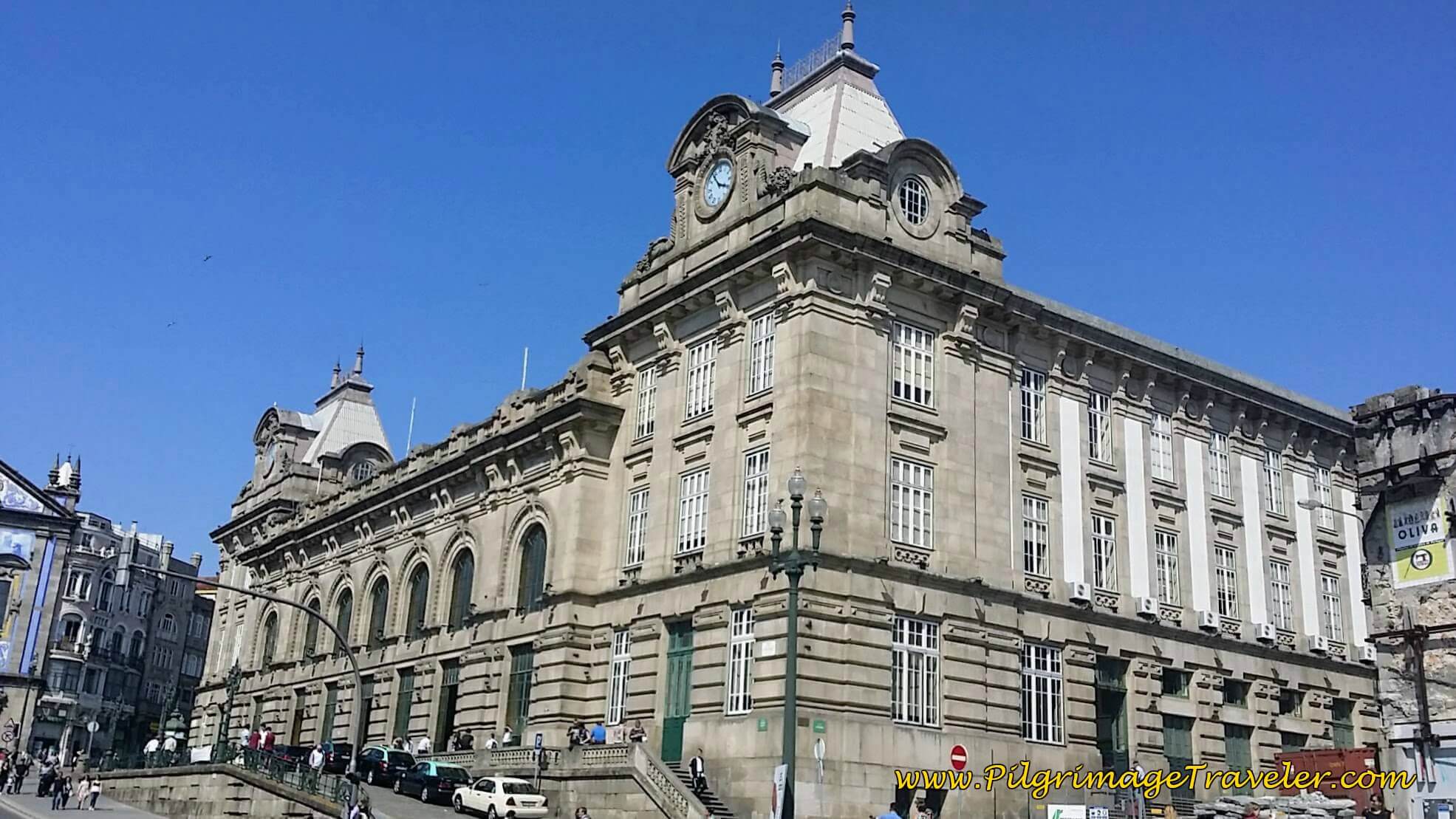
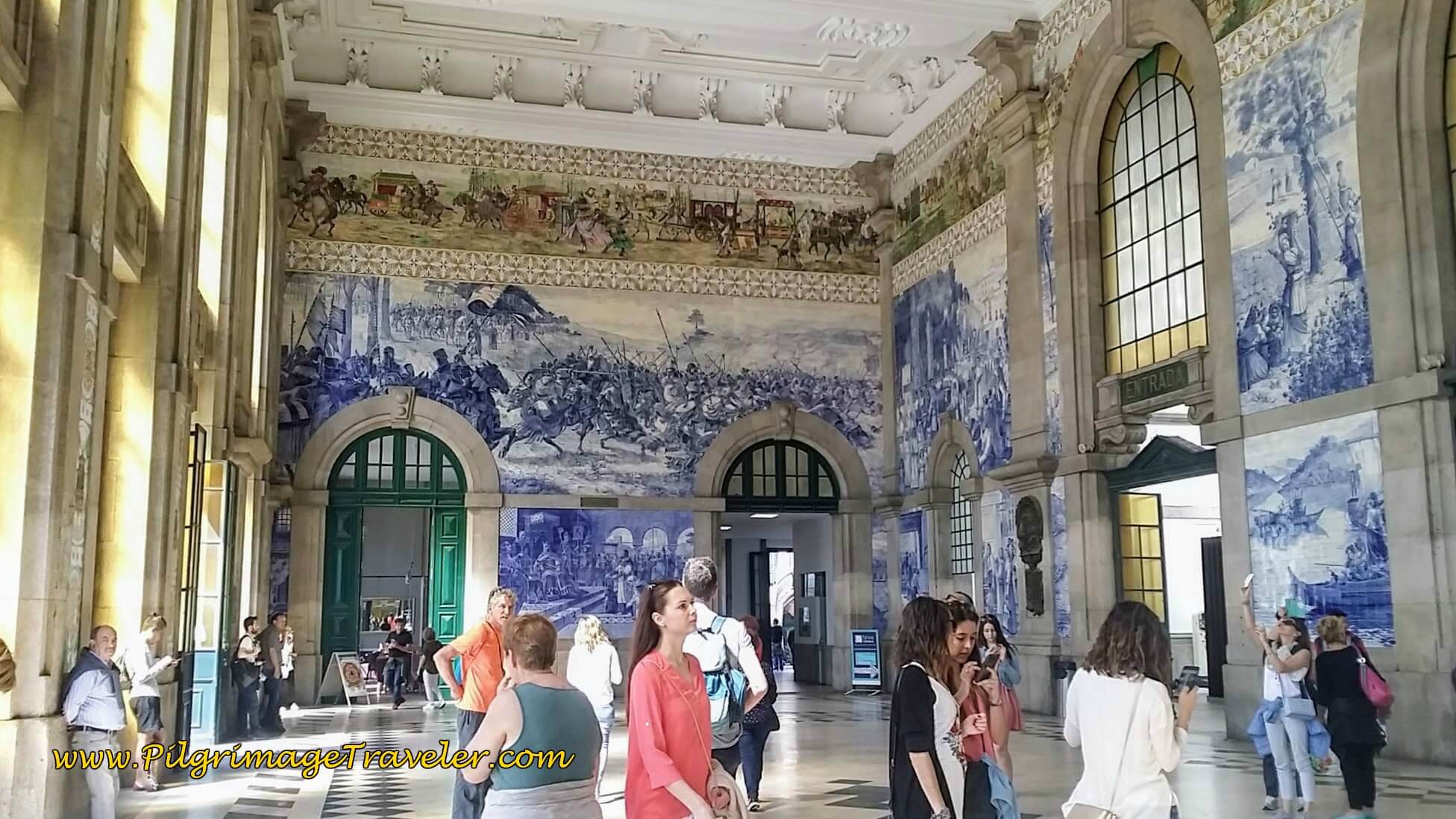
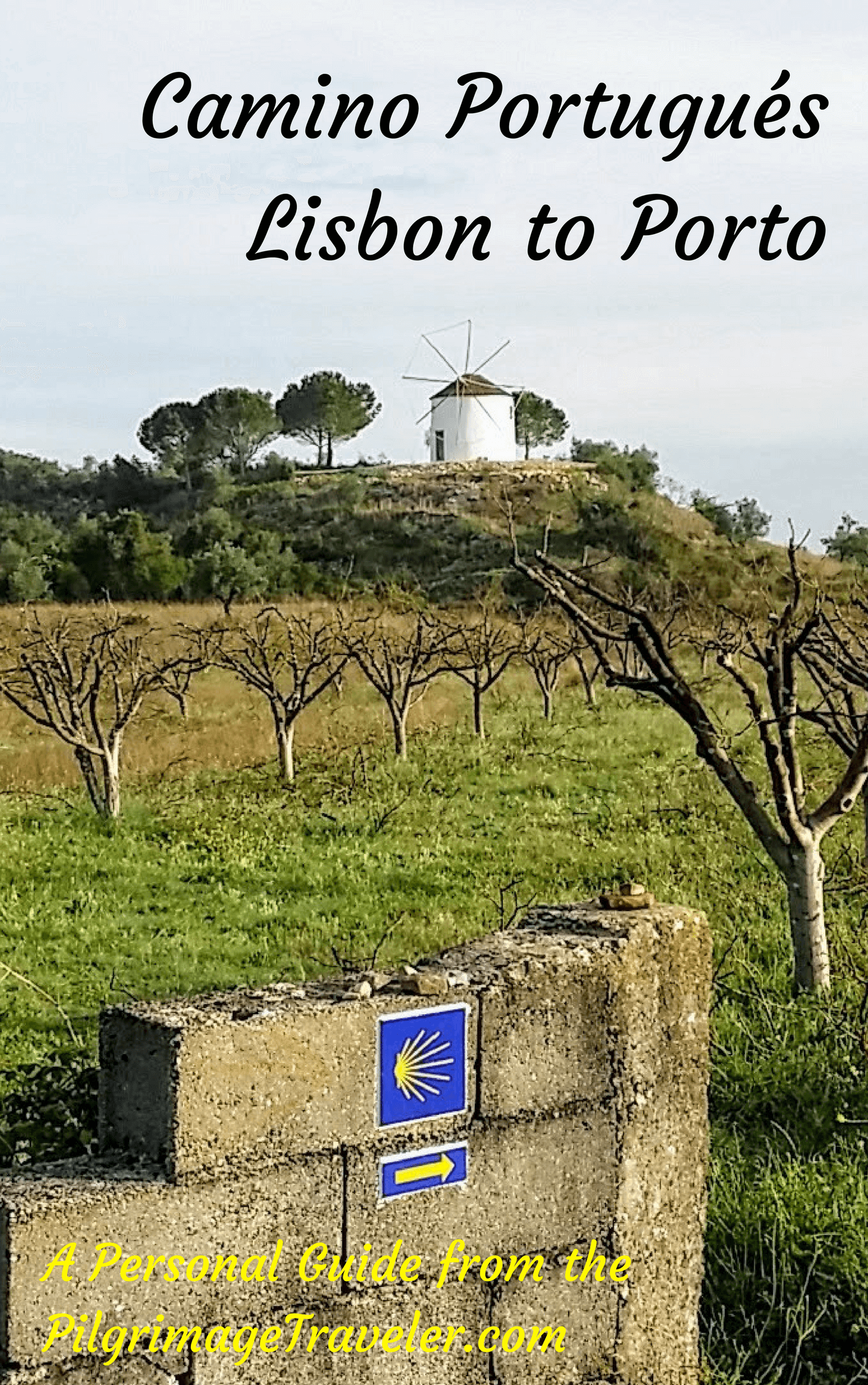
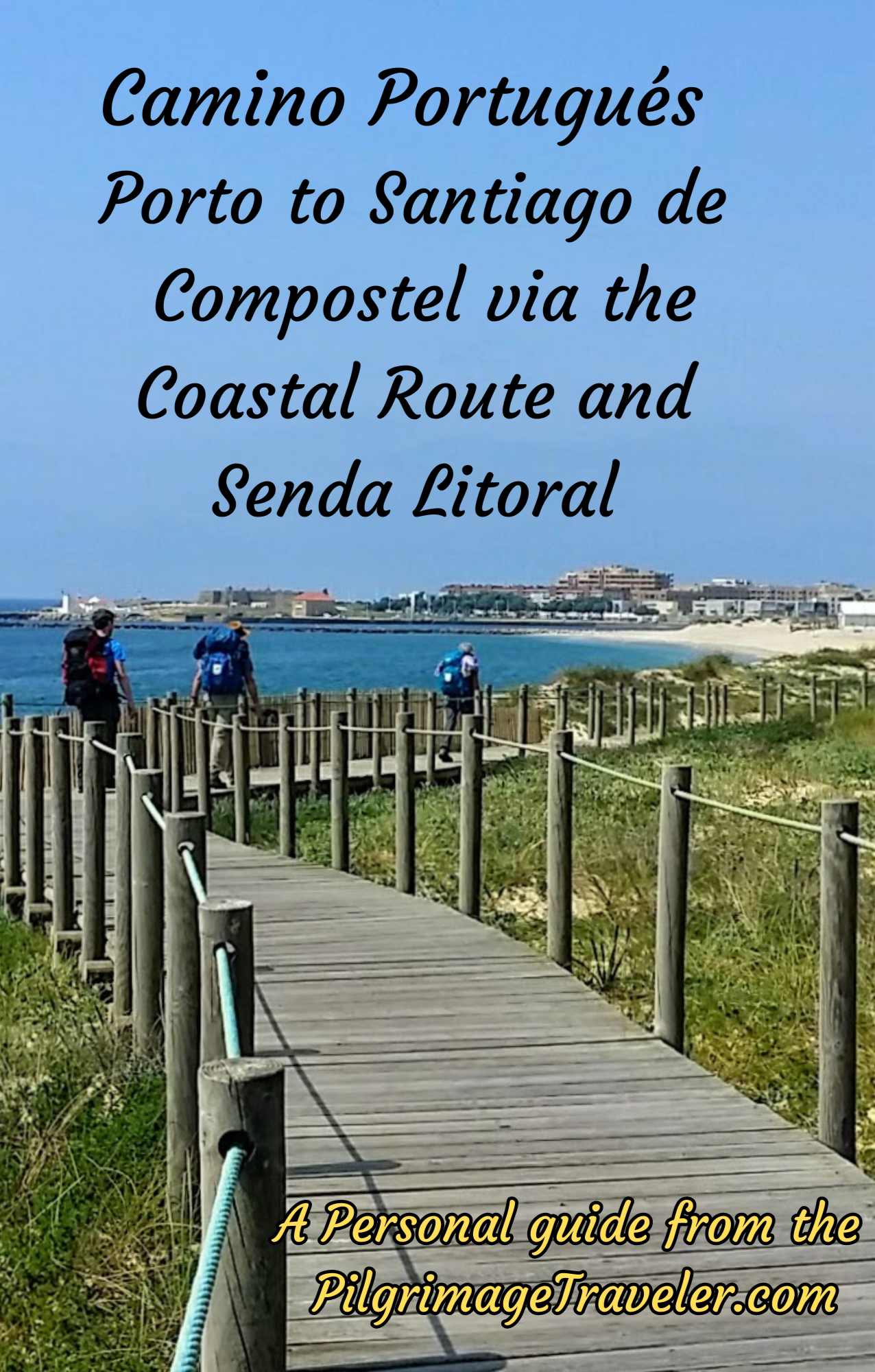
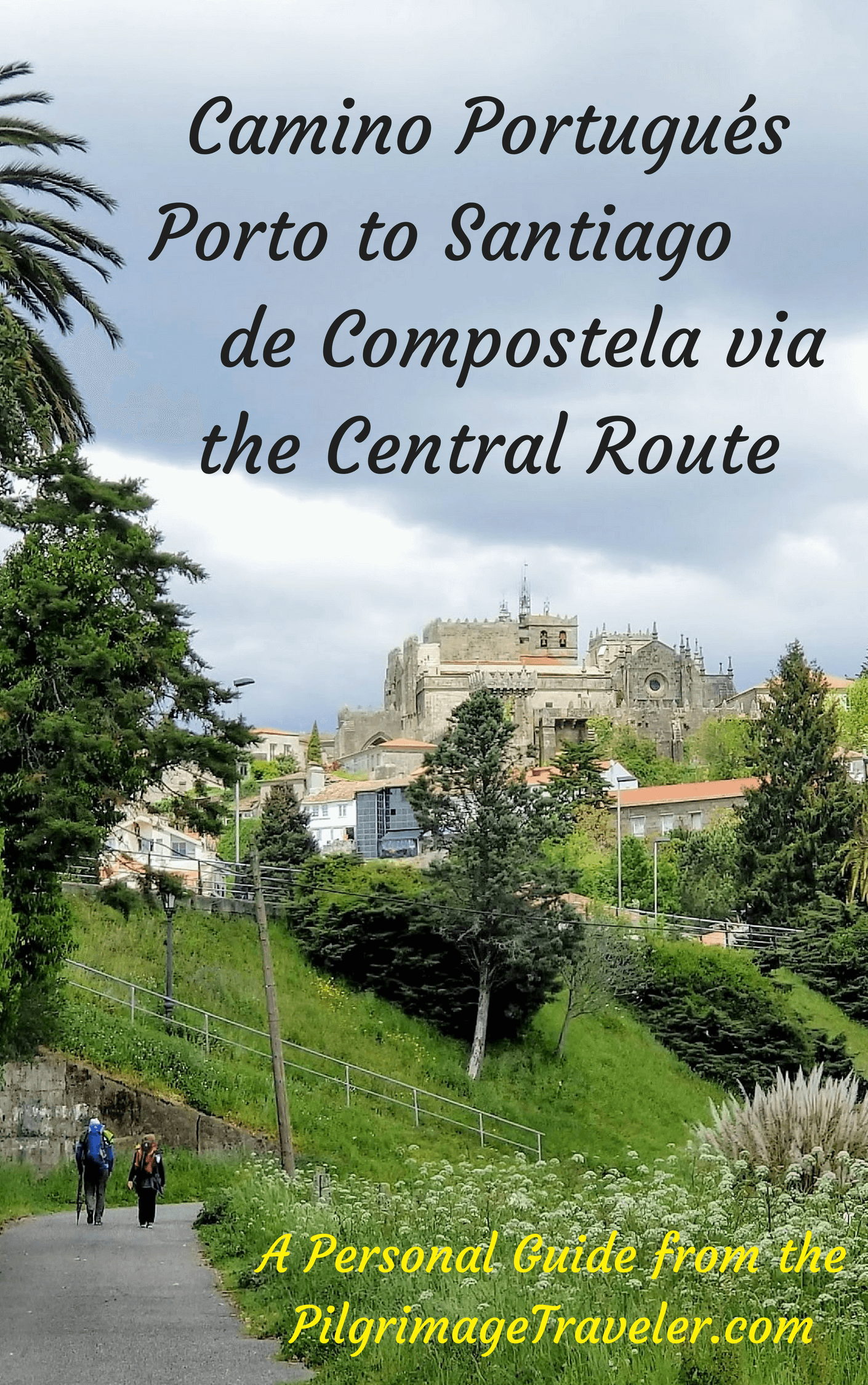
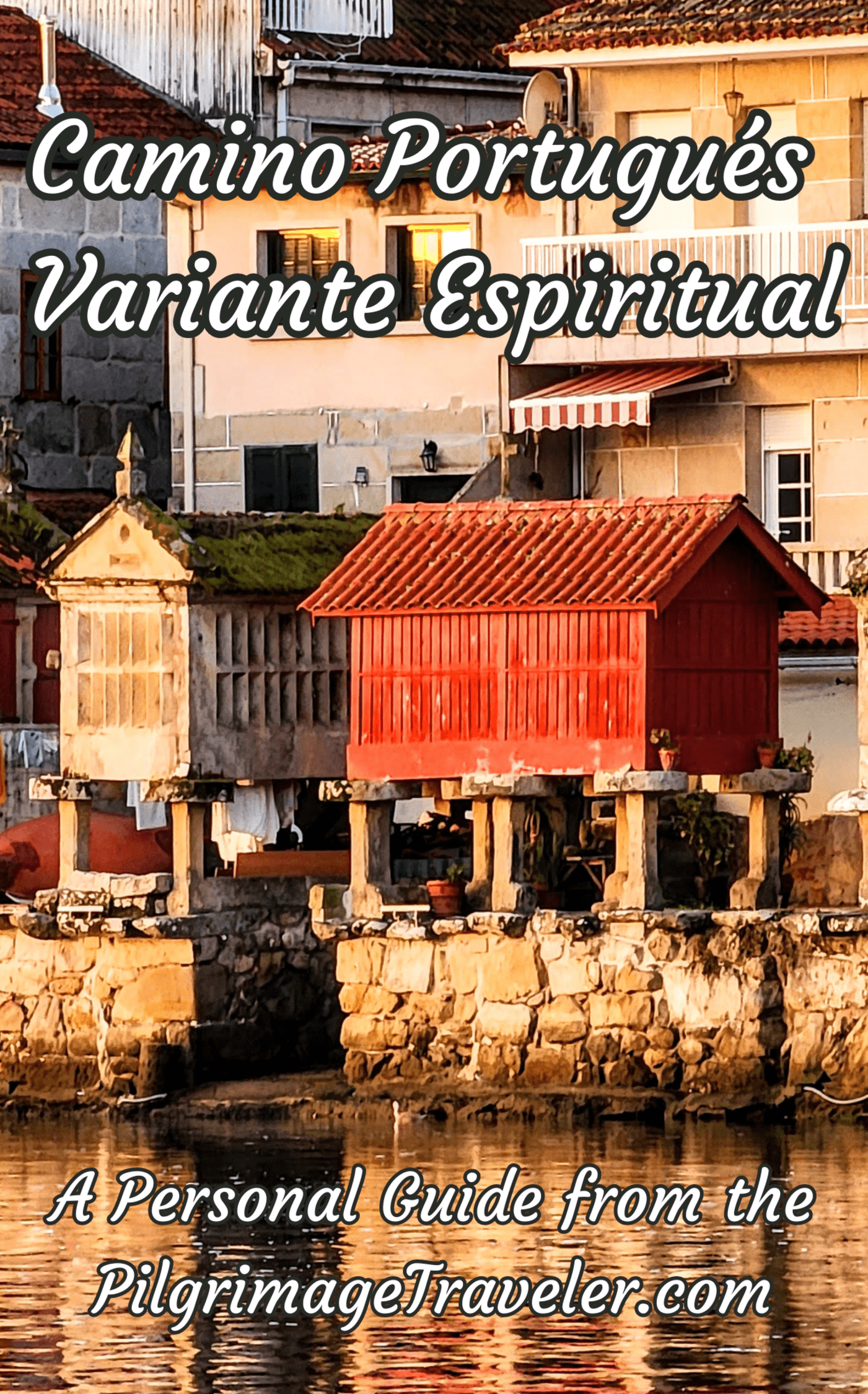

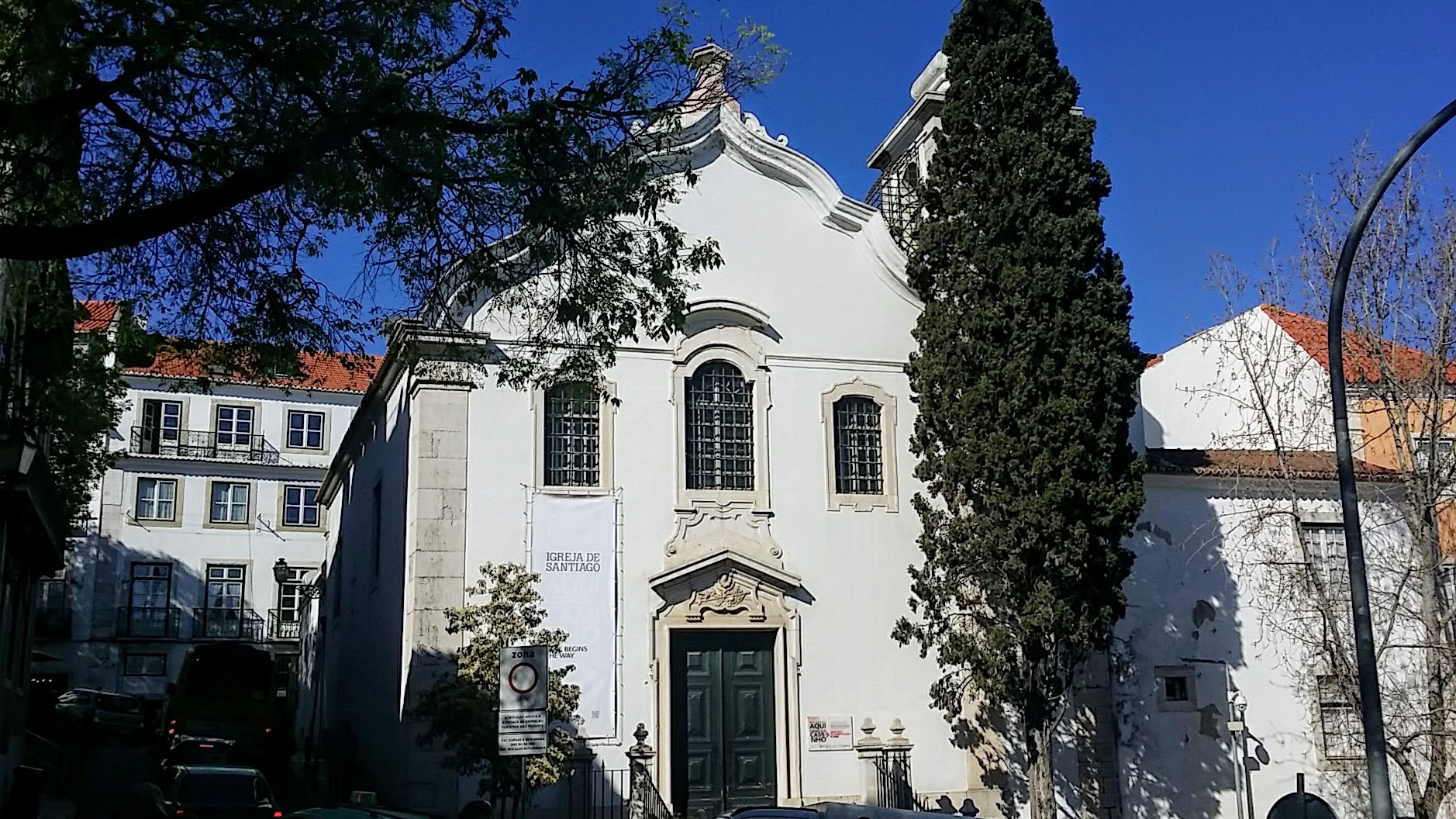

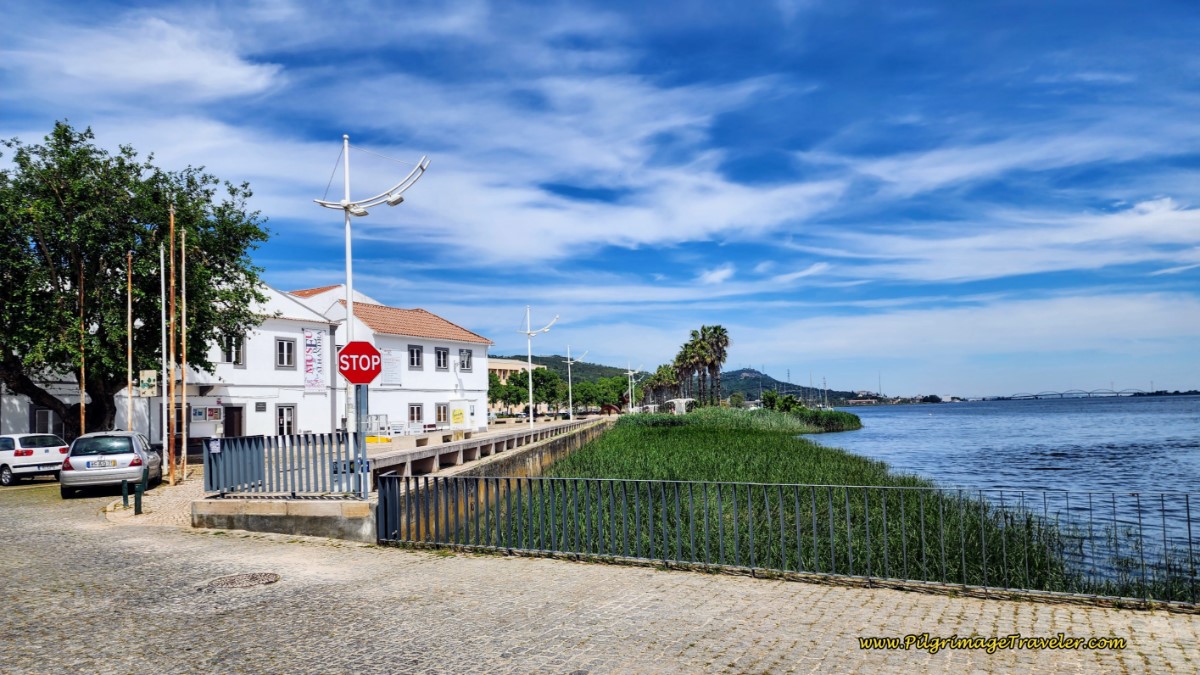









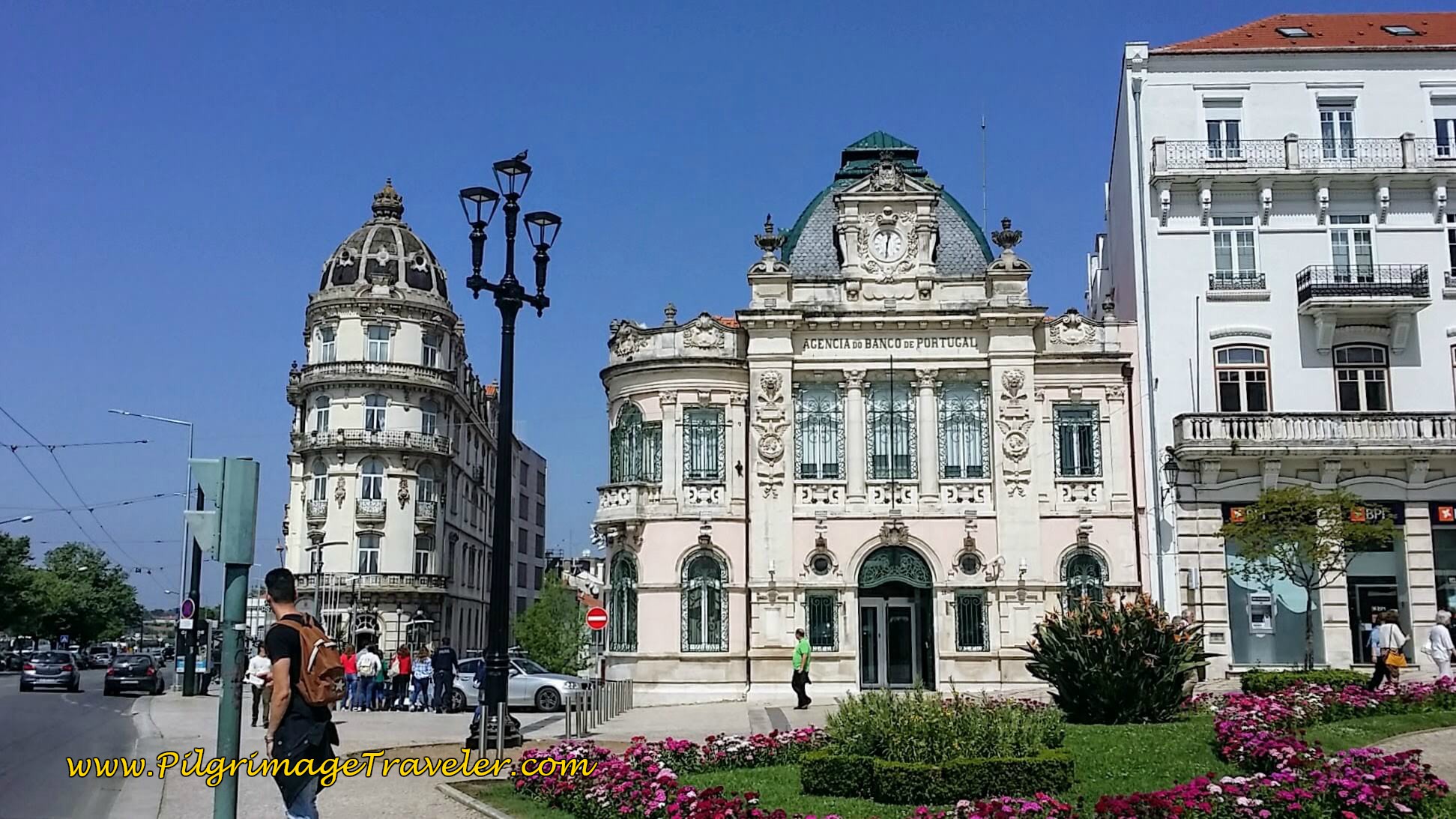





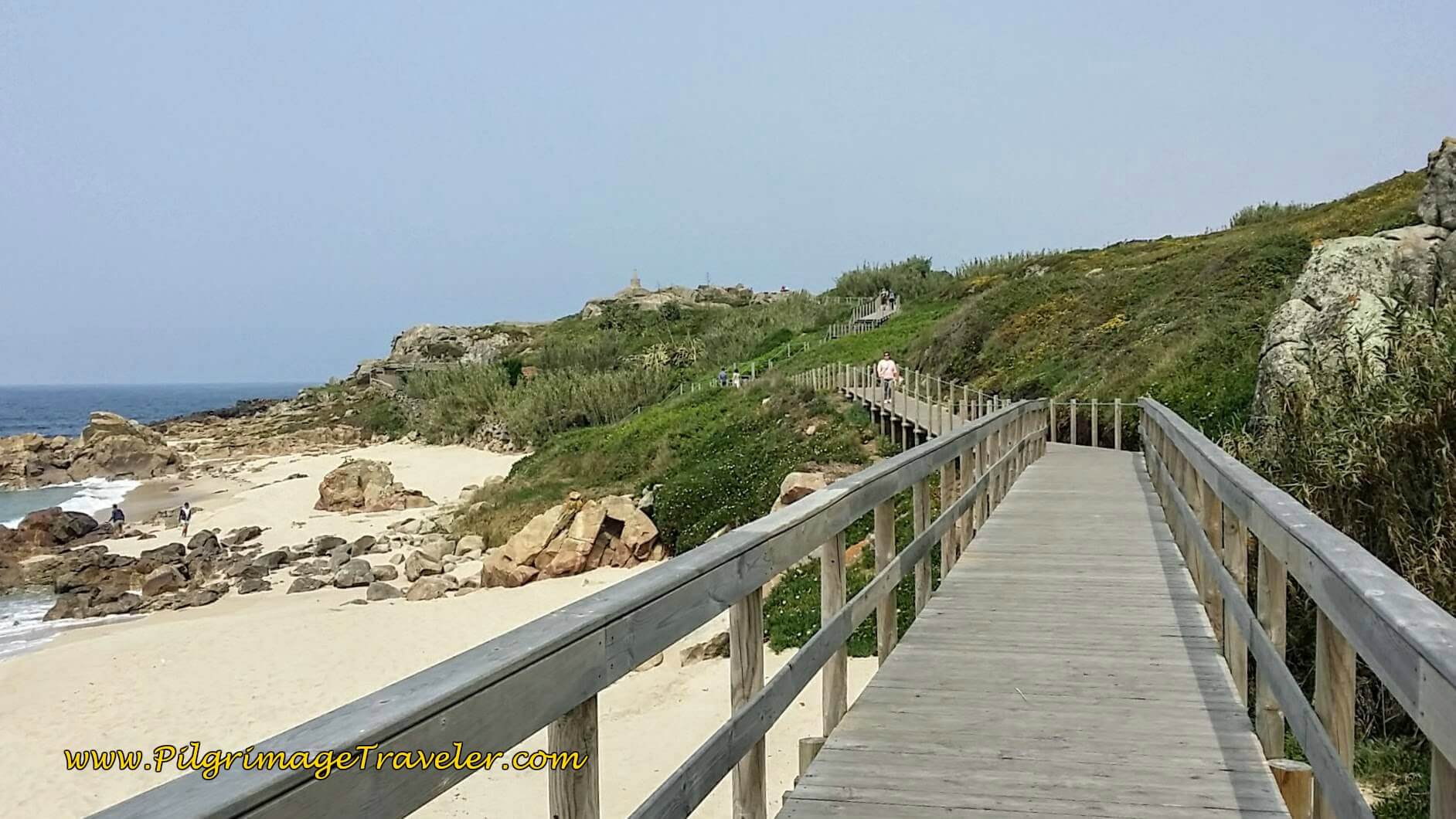

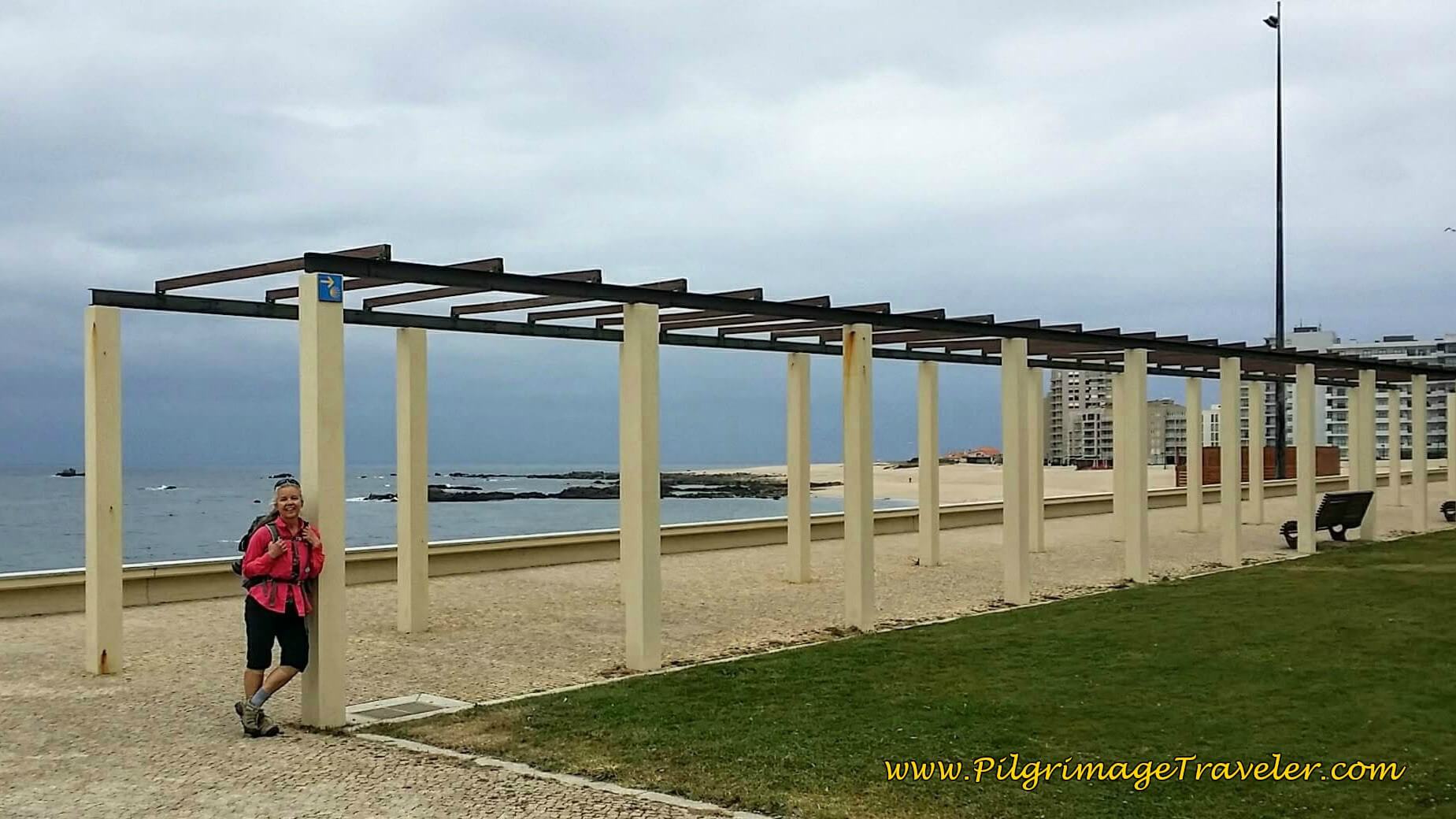

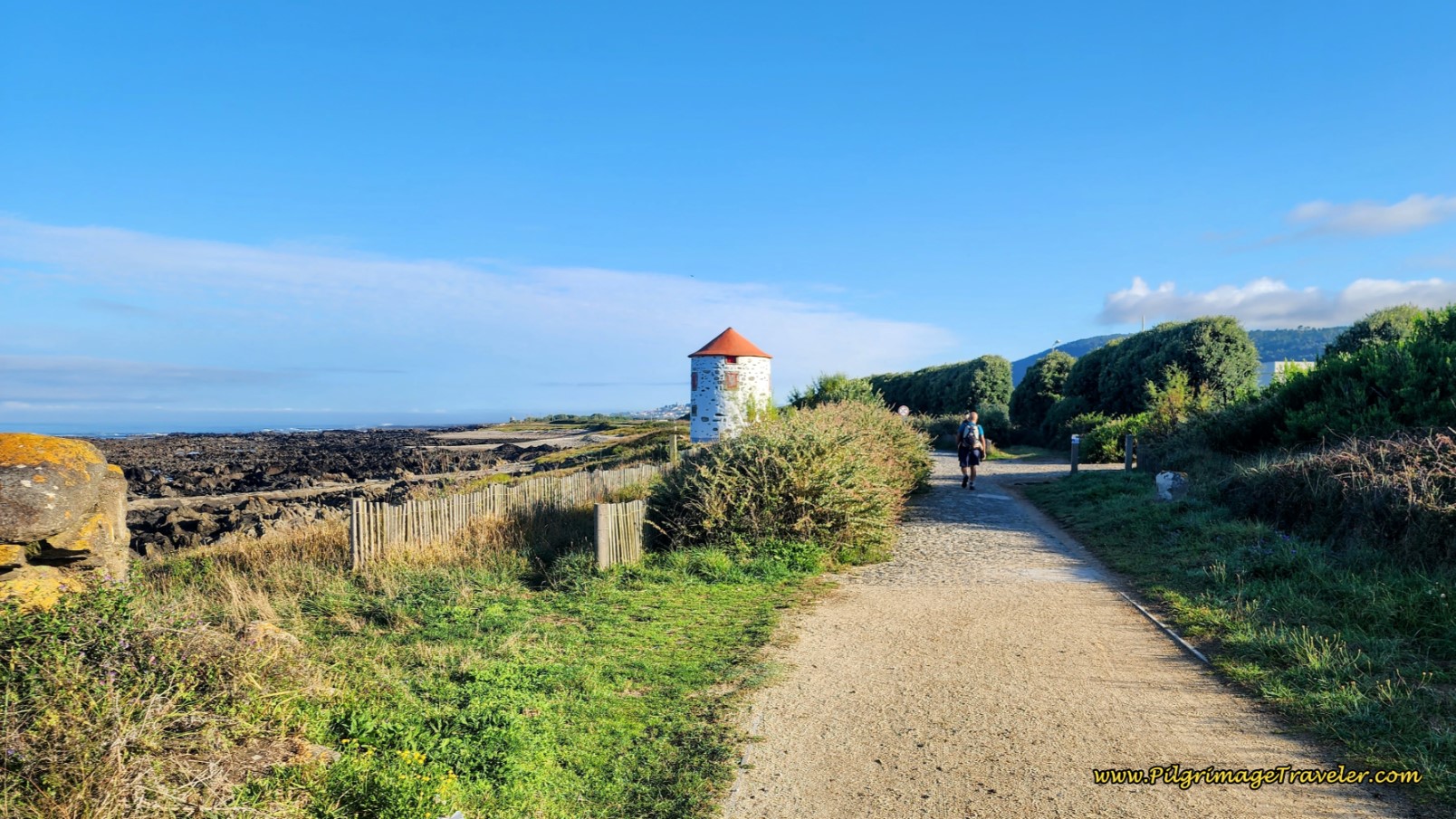








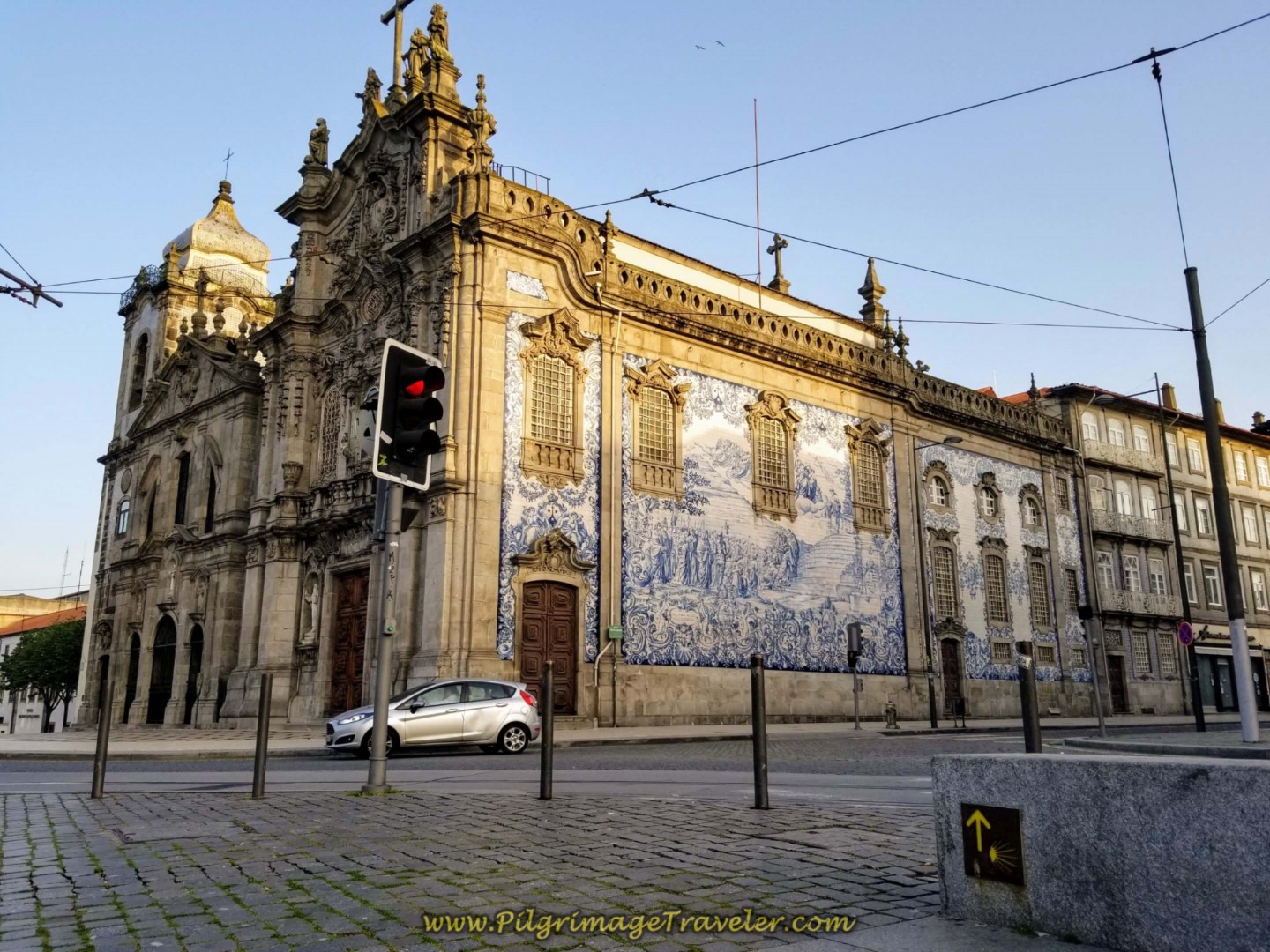











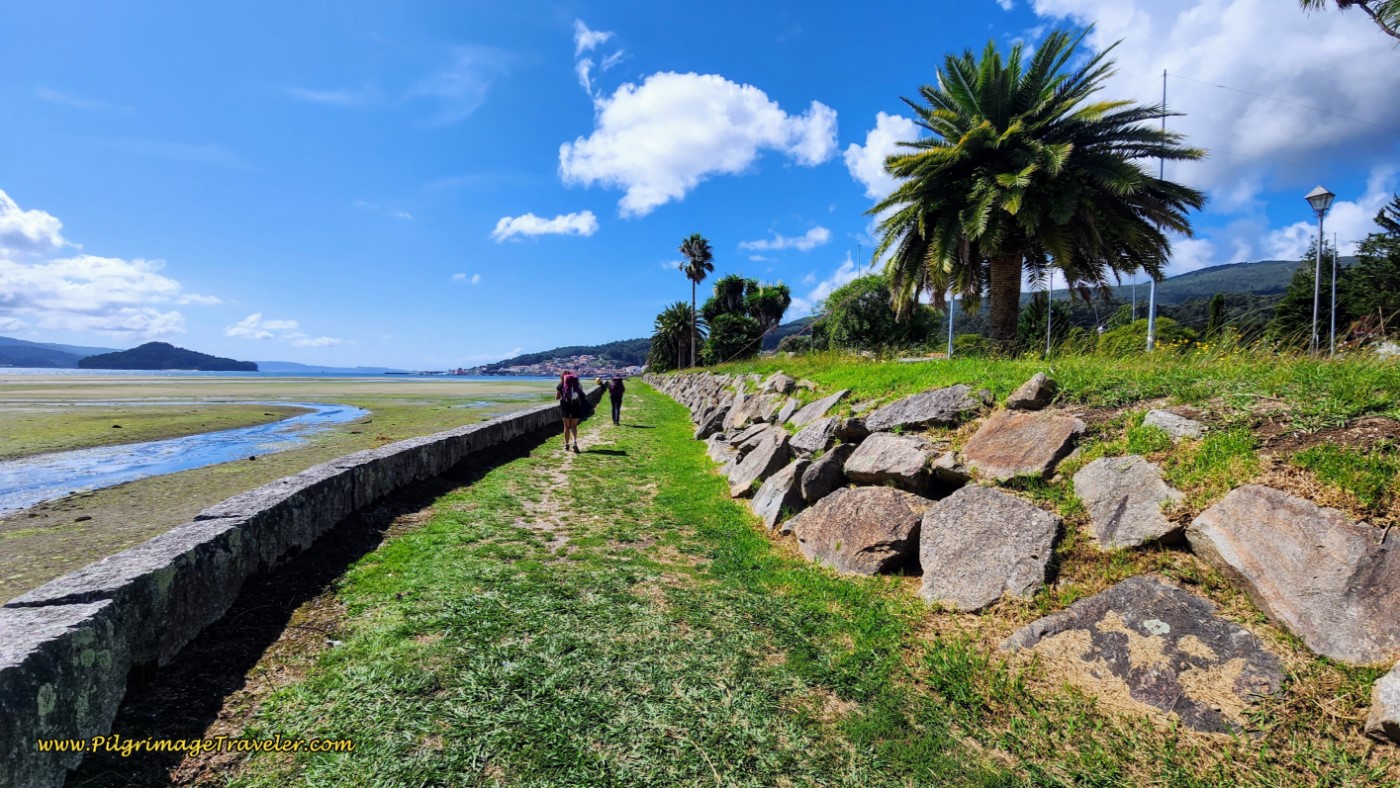


















Your Opinion Matters! Comments
Have you had a similar experience, have some advice to give, or have something else you'd like to share? We would love to hear from you! Please leave us a comment in the box below.